






USPS 382-600/ISSN#00287121
2340 Frederick Douglass Boulevard
New York, New York 10027
(212) 932-7400 / FAX (212) 222-3842
By TANDY LAU Amsterdam News Staff, Report for America Corps Member
Executive & Investigative Editor – Damaso Reyes Damaso.Reyes@AmsterdamNews.com
Managing Editor – Kristin Fayne-Mulroy KFM@AmsterdamNews.com
Digital Editor - Josh Barker
Josh.Barker@AmsterdamNews.com
Karen Juanita Carrillo
Karen.Carrillo@AmsterdamNews.com
Shannon Chaffers
Shannon.Chaffers@amsterdamnews.com
Ariama C. Long Ariama.Long@AmsterdamNews.com
Tandy Lau
Tandy.Lau@AmsterdamNews.com
DISPLAY & DIGITAL ADVERTISING CONSULTANT
William "Bill" Atkins (212) 932-7429 William.Atkins@AmsterdamNews.com
DIGITAL, BRANDED CONTENT & HYBRID ADVERTISING CONSULTANT
Ali Milliner (212) 932-7435 Ali.Milliner@AmsterdamNews.com
LEGAL, LLC & CLASSIFED ADVERTISING CONSULTANT
Shaquana Folks (212) 932-7412 Shaquana.Folks@AmsterdamNews.com
CIRCULATION / SUBSCRIPTION
Benita Darby (212) 932-7453 Benita.Darby@AmsterdamNews.com
The AmsterdamNewsassumes no responsibility for the return of unsolicited manuscripts or photographs. Photographs and manuscripts become the property of The Amsterdam News. Published weekly. Periodicals Class postage paid at New York, N.Y. POSTMASTER: Send address corrections to NYAmsterdamNews,2340 Frederick Douglass Blvd., New York, NY 10027.
MAIL SUBSCRIPTIONS INFORMATION
In 2022, Newark Mayor Ras Baraka rolled out “The Path Home” to end chronic homelessness in New Jersey’s biggest city. Just a year later, street homelessness was down by more than half — 57.6% to be exact, from 3,841 unsheltered individuals to 1,627.
“The mayor created the Office of Homeless Services just over two years ago, so it’s still new, but he saw that there was a need to have a dedicated office to really address homelessness in our city,” said Luis Ulerio, director of the Newark Mayor’s Office of Homeless Services. “He charged our office to create the city’s first strategic plan around homelessness, which we were really proud to launch in December of 2022.
“We immediately began to implement a lot of its strategies over that year, which included focusing on reducing street homelessness throughout our communities.”
While the plan’s sophomore year saw an uptick in homelessness in line with the rest of the state and country, Ulerio said new initiatives, like enhanced street outreach teams and more transitional housing, helped absorb the increase. As a result, street homelessness continues to trend downward.
Last month, street outreach efforts expanded, and Newark now boasts several new teams through nonprofit providers and local hospi-

tals, along with a new non-emergency hotline for unhoused people in need of assistance. However, different factors are at play across the Hudson here in New York City, where roughly 4,140 unsheltered people were counted in last year’s HOPE homeless count on Jan. 23, 2024 (this year’s count occurred at the end of last month). 97% of unhoused people in New York City are sheltered. According to Kelly Quirk, chief program officer of the Bowery Residents’ Committee (BRC), the right-to-shelter laws are the biggest distinguishing factor in her organization’s work between the two cities through
the New Jersey Transit. Of course, a consent decree from the landmark Callahan v. Carey lawsuit means a short-term bed is available to anyone in the Big Apple — a unique legal protection among American cities.
“The relationship with folks is the number one key, and that’s not going to change anywhere that you go,” said Quirk. “Newark has put an emphasis on making sure that there is bed availability and that they’ve reduced barriers to entry. I will say there [aren’t] really barriers to entry in New York — if someone wants to leave the street, we can find a place
See HOMELESSNESS on page 33

By KAREN JUANITA CARRILLO Amsterdam News Staff
Brooklyn Parks Commissioner Marty Maher has consistently said that the tennis courts at Bed-Stuy’s Jackie Robinson Park Playground are going to remain closed until April.
Bed-Stuy residents started a Change.org petition in mid-January to try to get the commissioner to open the tennis courts for offseason use or give a valid reason for keeping them closed. They say they want to be able to use them during the winter, the same way the borough’s other walk-on tennis court facilities are being used.
But, so far, the Parks Department has only responded to AmNews inquiries about this situation by insisting that the courts are closed this winter because of “repeated vandalism and misuse during the prior season.”
“They want us to believe these things,” Frances Ferdinand, the director of HQ Tennis LLC, said in response to those claims, “but I feel like that’s a very political answer because we know that that’s not the case.” Coach Ferdinand has been utilizing the Jackie Robinson Park tennis courts for the past five years to both give tennis instruction and sponsor
free and low-cost classes for kids and adults. Seeing that promoting park use made the neighborhood safer, Ferdinand and members of the Friends of Jackie Robinson Park Playground, advocated for renovations that saw the tennis courts resurfaced and repainted. She was shocked last spring, though, when her company was outbid by a tennis company that was new to the neighborhood for the exclusive right to teach classes on the park’s four tennis courts.
Some community members believe the entire neighborhood is being penalized because they spoke out against the Parks Department’s highest bidder court concessions process. They claim that now everyone is being restricted from accessing the tennis courts.
“This is the first time in the five years that I’ve been coaching and the years that I’ve been around Brooklyn that I know for those courts to be locked during the winter like this,” Ferdinand said in disappointment. “Like if people are brave enough to play outdoors in the winter, then they should be able to do it. It’s crazy to me that you would close off a part of the park. The whole park is not closed. If I want to play basketball, I can play basketball. If I want to play
By ARIAMA C. LONG Amsterdam News Staff
The New York State Black, Puerto Rican, Hispanic, and Asian Legislative Caucus (BPHA Caucus) unveiled its Empower Black New York Agenda this month. During their annual conference in Albany, legislators and advocates came together in celebration and determination to uplift Black communities across the state.
The Caucus’s 54th Annual Legislative Conference in Albany coincided with Valentine’s Day and Presidents Day weekend this year, with the theme of “We Are Bold.” That meant bold red colors, decor, food, culture, and music were in abundance.
But the conference was mostly about promoting even bolder legislation in the face of unprecedented adversity in the U.S political climate — especially during Black History Month.
“The Caucus has passed historic legislation on behalf of Black New Yorkers, from reparations to protections against deed theft, this body remains committed to closing the racial wealth gap and addressing the disparities Black communities continue to face,” said Assemblymember Michaelle Solages, deputy majority leader of the New York State Assembly and BPHA Caucus Chair.

The Caucus’ Black agenda includes budget and legislative priorities at the city and state levels in the areas of housing, wealth equity, business, workforce, healthcare, climate, transportation, mental health, education, civil rights, criminal justice reform, child and family wellbeing, and the immigrant community. Their demands include $50 million in direct funding for Black-led community organizations focused on economic empowerment, workforce development, and social ser-
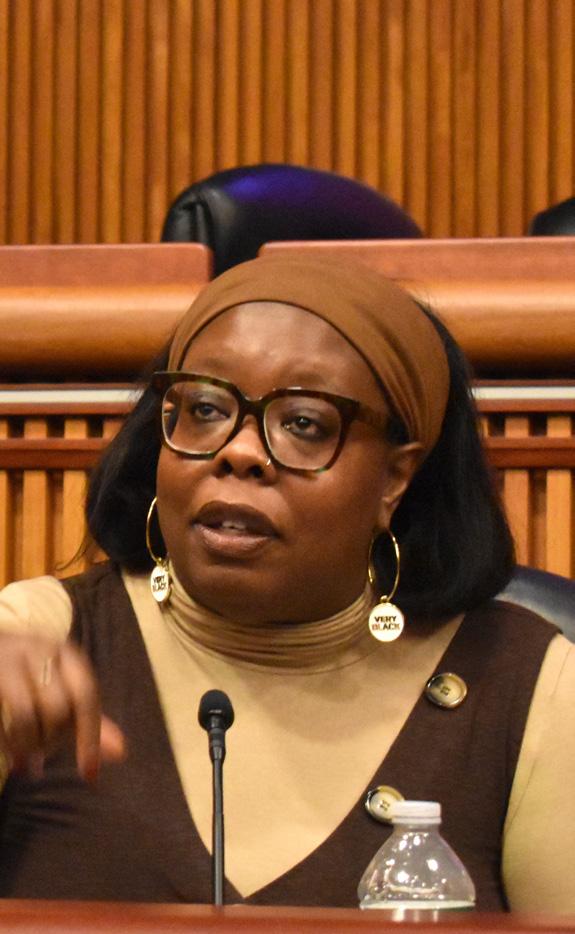
vices; $250 million towards the Housing Access Voucher Program and $1 million to expand Cease & Desist zones to address gentrification; $1 billion to establish a full year youth and young adult employment immersion program, $30 million to support efforts to expand college access for incarcerated individuals, and $100 million to immigrants’ right to counsel.
Brooklyn Councilmember Crystal Hudson and Bronx Councilmember Althea Stevens, along with
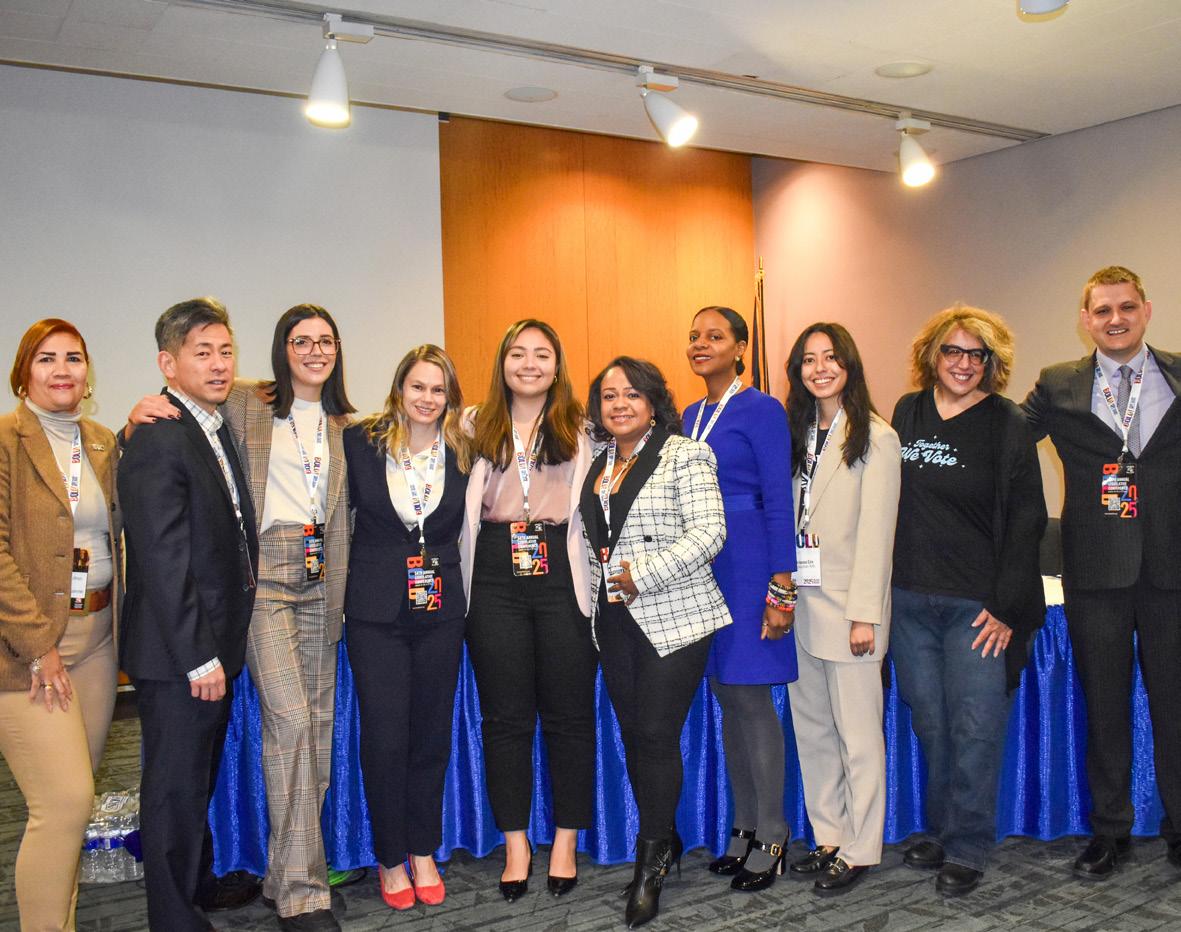
Queens Assemblymember Khaleel Anderson, were part of a panel discussing why a similar agenda hadn’t materialized when New York State has so many Black and Brown representatives. They pointedly said that plenty of their colleagues in government haven’t been unified in action and policies, and at times actively block progress.
“The task isn’t easy because one of the things that I found when I first got into council is saying ‘Black’ for some reason people hear that
you’re anti something else,” said Stevens at the conference. Stevens encouraged attendees and voters, especially the youth, to be civically engaged and hold Black electeds accountable. Alluding to the foothold Republicans have in the state, and the rise white nationalism across the country, Stevens said that Democrats were “asleep at the wheel” and unorganized last year. She hopes that a singular agenda will help create more unity
See NYSBPHA CAUCUS on page 25
By TANDY LAU Amsterdam News Staff, Report for America Corps Member
Racial and class disparities persisted last year in the city’s traffic deaths, despite marked improvements under the decade-old Vision Zero program.
That was the finding in the annual report from nonprofit Transportation Alternatives (TransAlt). Fatalities rose by 12% last year in neighborhoods with the most Black residents and 34% in those with the most Hispanic residents. Meanwhile, traffic deaths decreased in primarily white neighborhoods.
“There’s a couple different factors for that, but the one that we find that the data points the most toward is, of course, the lack of design and infrastructure, [and a] slow patchwork approach towards investing in these communities,” said Shawn Garcia, TransAlt’s director of ad -
vocacy. “The city has, especially in the last few years, really tried to lean more into goals around equity. For instance, we saw one of the biggest increases of bike lane infrastructure in the Bronx over the past three to four years.”
An NYC Department of Transportation (NYC DOT) report released on Jan. 15 found neighborhoods with populations of 80% or more Black, Brown, and/ or Asian saw the biggest decline in traffic deaths over the decade since then-Mayor Bill de Blasio implemented Vision Zero, which aspired to eliminate traffic-related deaths entirely.
The NYC DOT’s equity report examined Street Improvement Project (SIP) miles to the overall street miles based on the racial demographic of each neighborhood for such findings. An agency spokesperson also pointed to specific projects in communities of color,
including new bike lanes for the Bronx’s Soundview Avenue and in Brooklyn’s East New York neighborhood.
“Since the advent of the highway, many urban planning practices have left low-income neighborhoods and neighborhoods of color in New York City at a higher risk of traffic fatalities and childhood asthma,” said TransAlt executive director Ben Furnas after the report’s release. “We commend DOT on working to right these historic wrongs and prioritizing investment in every corner of the five boroughs. It’s fantastic to see an emphasis on work in every neighborhood.
Garcia said that, despite these improvements, further investment is needed for communities of color. He pointed to the city’s exemption to a statewide law for universal daylighting — removing parking spots in front

By TANDY LAU
Amsterdam News Staff, Report for America Corps Member
In 2023, the Manhattan District Attorney initiated just one hate crime prosecution based on national origin. Last year, that number spiked to 10, with anti-migrant sentiment as the alleged motivation for six of the 2024 incidents. This early in 2025, there are already three anti-national origin cases this year, tied with antisemitism for most of any hate crime category.
“We’ve seen an increase in incidents pertaining to migrants [and] unprovoked attacks against people that the defendants perceive to be migrants,” said Manhattan D.A. hate crimes unit chief Hannah Yu in an interview over the phone. “And a large [number], if not all, of our migrant cases involve a victim or victims from the Latino community.”
The increase lines up with the recent arrivals of asylum seekers from the southern border. Anti-migrant rhetoric is well-documented, with politics seeming to follow the most targeted groups.
Yu pointed to recent staffing of the office’s Survivor Services Bureau toward assisting Jewish and Muslim victims after the Oct. 7 attacks. She added that the office provides access to interpreters and does not ask about immigration status.
The groups targeted for hate crimes in Manhattan have also shifted since D.A. Alvin Bragg took office — back in 2022, anti-Asian incidents led all categories of new hate crime cases stemming from pandemic-related scapegoating
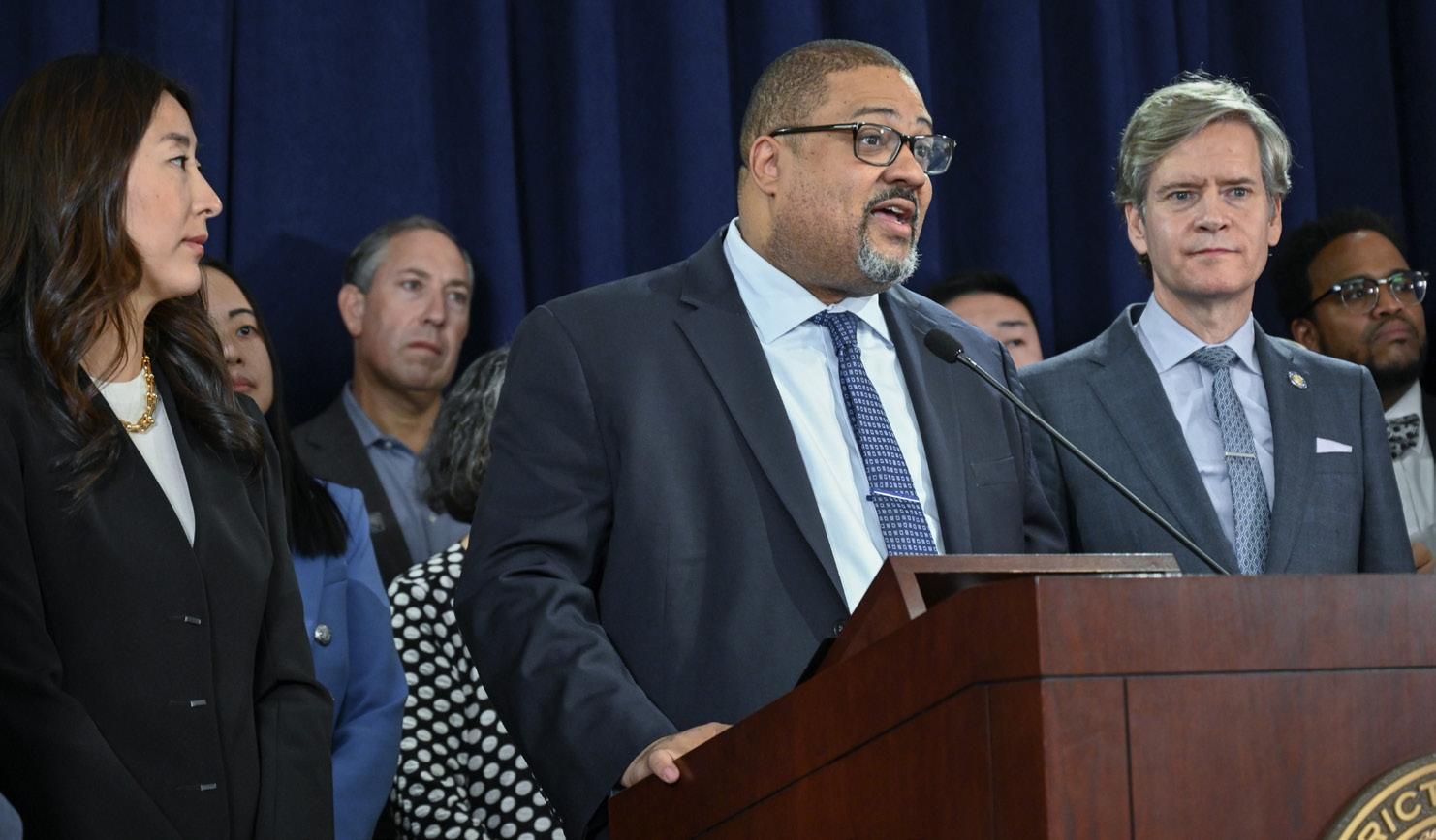
due to the discovery of COVID-19 in Wuhan, China (the number declined significantly over the past two years). Meanwhile, 11 antisemitic hate crimes prosecutions were initiated in 2022 compared to 33 last year. However, antiLGBTQIA incidents are consistently one of the highest in frequency.
This month, 148 hate crime cases remain open and pending — 11 under the category of anti-Black. Yu attributed the uptick to a “rising tide” of hate against all marginalized groups. More hate crime prosecutions also coincide with the office’s expansion of the unit handling them along with an increase in offenses that can be charged as hate crimes — last April, an amended version of the Hate Crimes Modern-
ization Act championed by Bragg was passed in the state budget, adding 23 new chargeable offenses to the hate crime statute, including gang assault and false incident reporting.
However, there are still gaps.
“The Hate Crimes Modernization Act certainly provides us with a greater ability to charge more offenses as hate crimes and, to some degree, it has been helpful in allowing us to hold perpetrators accountable,” said Yu. “The inception came from a feeling that any and all penal laws should be chargeable as a hate crime. There are still offenses that are being committed [that are] motivated by some sort of bias that we can’t charge as a crime.
“[For example,] endangering the welfare of
a child is an offense we’re seeing repeatedly happen in a hate crime context, but that was not one of the penal law offenses included in the action, so we’re still unable to charge that as a hate crime.”
An earlier version of the bill proposed 31 new chargeable offenses. Proponents pointed to the seemingly arbitrary logic for an offense’s exclusion in the hate crime statute — for example, first-degree rape could be charged as a hate crime but other forms of sexual assault, like forcible touching, could not (although the modernization act ultimately included it).
“While these changes have long been in the works, they are unfortunately newly urgent,” said Bragg in 2023. “The current surge in hate crimes reported to the NYPD follows a pattern — a pattern that we have sadly seen many times. Bias-motivated crimes often spike following highprofile events — from anti-immigrant hate crimes in 2016, following xenophobic rhetoric during the presidential campaign, to anti-Black hate crimes following the Black Lives Matter protests of 2020, to anti-AAPI hate crimes during the COVID pandemic, to more recently, antisemitic, anti-Arab, and Islamophobic incidents.”
Tandy Lau is a Report for America corps member who writes about public safety for the Amsterdam News. Your donation to match our RFA grant helps keep him writing stories like this one; please consider making a tax-deductible gift of any amount today by visiting https:// bit.ly/amnews1.
By ARIAMA C. LONG Amsterdam News Staff
Executives of the Black Roosevelt Island Operating Corporation (RIOC) — its CEO and President Shelton Haynes, and General Counsel Gretchen Robinson — were fired last year amidst a racial discrimination lawsuit against the state.
Roosevelt Island is located in New York City’s East River near Manhattan and is a New York State public benefit corporation that runs the island. Haynes started working there in 2016, and was the second Black person to hold the president position. Robinson began working at RIOC in 2015, and was the first Black person in that position.
Their lawyer, Milton Williams, a partner at Walden Macht & Haran LLP, filed the discrimination lawsuit executives in 2023 with the U.S. Southern District of New York against RIOC and Governor Kathy Hochul’s Executive Chamber. After nearly a year on paid administrative leave, Haynes and Robinson were fired abruptly due to a “loss of confidence” in November 2024.
Litigation is still ongoing.
“This is nothing short of a travesty,” said Williams in a statement. “Shelton Haynes and Gretchen Robinson have dedicated their careers to public service and served

the Roosevelt Island community with integrity and excellence. Instead of addressing their legitimate concerns about systemic issues, they have again and again been met with retaliation and unfounded accusations. The actions taken against them, under the guise of a ‘loss of confidence,’ reflect a disturbing misuse of power that undermines the principles of fairness and justice.”
The pair alleged that RIOC had a hostile work environment, was racially discriminatory, and launched numerous “baseless” investigations into their conduct since they assumed their positions in 2020. The costly state investigations, which ran from March 2021 to April 2023, didn’t corroborate any allegations against Haynes and Robinson or find any wrongdoing on their parts. They said the state didn’t allow them to defend themselves or hire a media company to handle negative press during that time, and that “hostile” board members were appointed without following typical procedure or approval from Haynes. There was also a slew of complaints from former employees, at least one of which was dismissed, who had been let go because of a restructuring plan. Those employees filed their lawsuit in 2023.

By ARIAMA C. LONG Amsterdam News Staff
The world of book publishing has not been historically kind to Black and Brown authors. That’s why literary champions of diversity, like Yona Deshommes, 56, stand out.
After a lengthy career in education and publishing, Deshommes founded her own publishing company, Riverchild Media LLC. Her mission is simply to amplify the voices of authors of color, showcase their works, and explore innovative promotional avenues that grow their business.
A daughter of Haitian immigrants, Deshommes was born in Brooklyn and raised in Rockland County. Her father is a retired math teacher and her mother was a nurse. Her earliest memory was sitting at the kitchen table with her father as he read the newspaper. Big on education, her parents encouraged an early appreciation for reading.
Initially, she pursued being a doctor to please her family, attending Hofstra University as a biology major. “That didn’t happen. That was really my dad’s dream, not mine,” said De-
shommes. “And I kind of fell into teaching by accident.”
Deshommes took a job as an academic coordinator at a residential treatment center in Chestnut Ridge called Edwin Gould Academy in the 1990s. She worked primarily with at-risk youth from the foster care and juvenile justice system, many of whom were reluctant readers. She got her undergraduate degree in special education from City College and went on to be a teaching assistant. She used books such as “The Coldest Winter Ever” by Sister Souljah, “Precious” and “Push” by Sapphire, and “Monster” by Walter Dean Myers to get them to read and was able to use those books to teach them to think critically.
“I was one of those rabble rousers, I guess you’d call them, at the school,” said Deshommes. “I was a fierce advocate for the kids. At the end of the day, they were Black and Brown children and they’d treat them like experiments.”
Deshommes suspects that friction led to her being let go from her school. For the first time, she considered a career in publishing and editing. She landed a pivotal internship in 2003, and started working as an assistant at then-Warner Books (now Hachette Book Group USA). She moved onto Harper Collins in publicity and publishing, working with higher profile authors. Eventually, she found a home at Atria Books for the next 13 years. She spent the better part of her career working with authors of color like Zane, Ta-
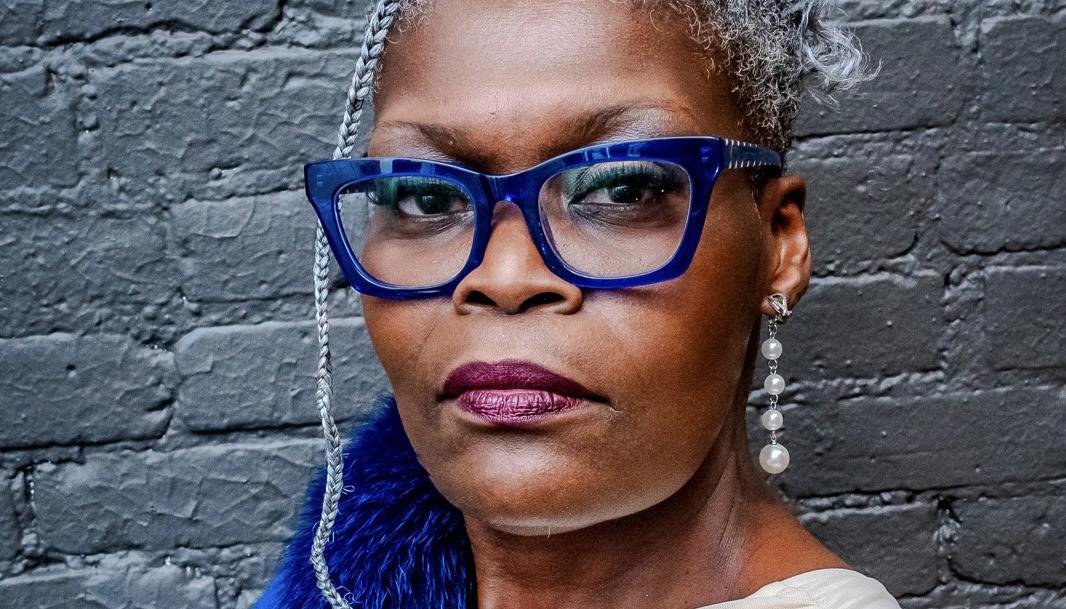
nanarive Due, Sister Souljah, Alice Walker, Taraji P. Henson, Kevin Hart, Marc Lamont Hill, Common, Michael Strahan, George Clinton, Charlie Wilson, and T.D. Jakes. In 2019, Deshommes was abruptly told that her position was being eliminated — an extension of a “shift” away from publishing diverse authors of color, she said. In a yearslong battle with cancer at the time, she took the hit pretty hard. “My coworkers were like my family,” she said, “but I always believe that God always puts us exactly where we need to be and when we need to be there.”
In 2020, during the COVID-19 pandemic, interest in Black and Brown authors boomed. Because of her experience and connections in publishing, Deshommes was uniquely positioned to flourish as a freelance publisher and agent. She created Riverchild Media the same year, and never looked back. Her newest venture will be a subsidiary of her company, River & Reeds Press.
For more information on books, authors, or offerings, check out her website at www. riverchildmediallc.com/
Become a Silver Corps member and support your community, while receiving training and credentialling to show employers you are the right candidate for them. Find out how to become a Silver Corps member by emailing silvercorps@aging.nyc.gov or call Aging Connect at 212-AGING-NYC (212-244-6469) to learn more.




By MARIELLE ARGUEZA Special to the AmNews
Before social safety nets were enshrined through government programs like Medicare, free-and-reduced school lunches, or food stamps, charity — the idea of the wealthier aiding the needy — was the social norm.
Especially in times of great socio-economic division, the upper classes were historically expected to perform acts of charity. Titans of industry like JD Rockefeller and JP Morgan famously supported several learning institutions like Spelman College and the Metropolitan Museum of Art. Rich heiresses such as Consuelo Vanderbilt and many of her contemporaries contributed their funds to building hospitals and providing economic relief to women. Even today, the British royal family’s influence is most tangibly seen in their support of more than 1,000 charities and patronages.
While these acts of charity and philanthropy no doubt shaped policies at a high level, immigrants, Black people, and other marginalized people have found ways of taking care of their own on a community level. Often ostracized by race, income, or class, communities of color everywhere in the U.S. didn’t have large sums of individual wealth or public influence.
What they did have (time, money, knowledge, and numbers), they could contribute to a collective cause, and meet their neighbors’ needs in solidarity with each other, not their much richer benefactors. It’s called mutual aid.
In the late 1700s, a group of freed Black men in Philadelphia formed the Free African Society. While they began as a group that mostly shared financial and religious knowledge, they volunteered to transport and bury the dead during an outbreak of yellow fever, helped financially support recent widows, placed orphans in apprenticeships, and paid the tuition of students who didn’t have access to free schools.
In 1833, poor Chinese workers in San Francisco, Calif., banded together to help each other find work, housing, and legal aid in what eventually became the Chinese Consolidated Benevolent Association. The group still exists today and functions in much the same way, and now provides naturalization and English language classes as well.
In East Harlem in the 1960s, the Young Lords, a coalition of Latino and Black youth, banded together to launch the “Garbage Offensive.” They demanded that the city provide proper sanitation services by blocking the streets with a giant pile of trash. They also commandeered churches, setting up feeding programs, clinics, and daycares for working families who couldn’t afford child-
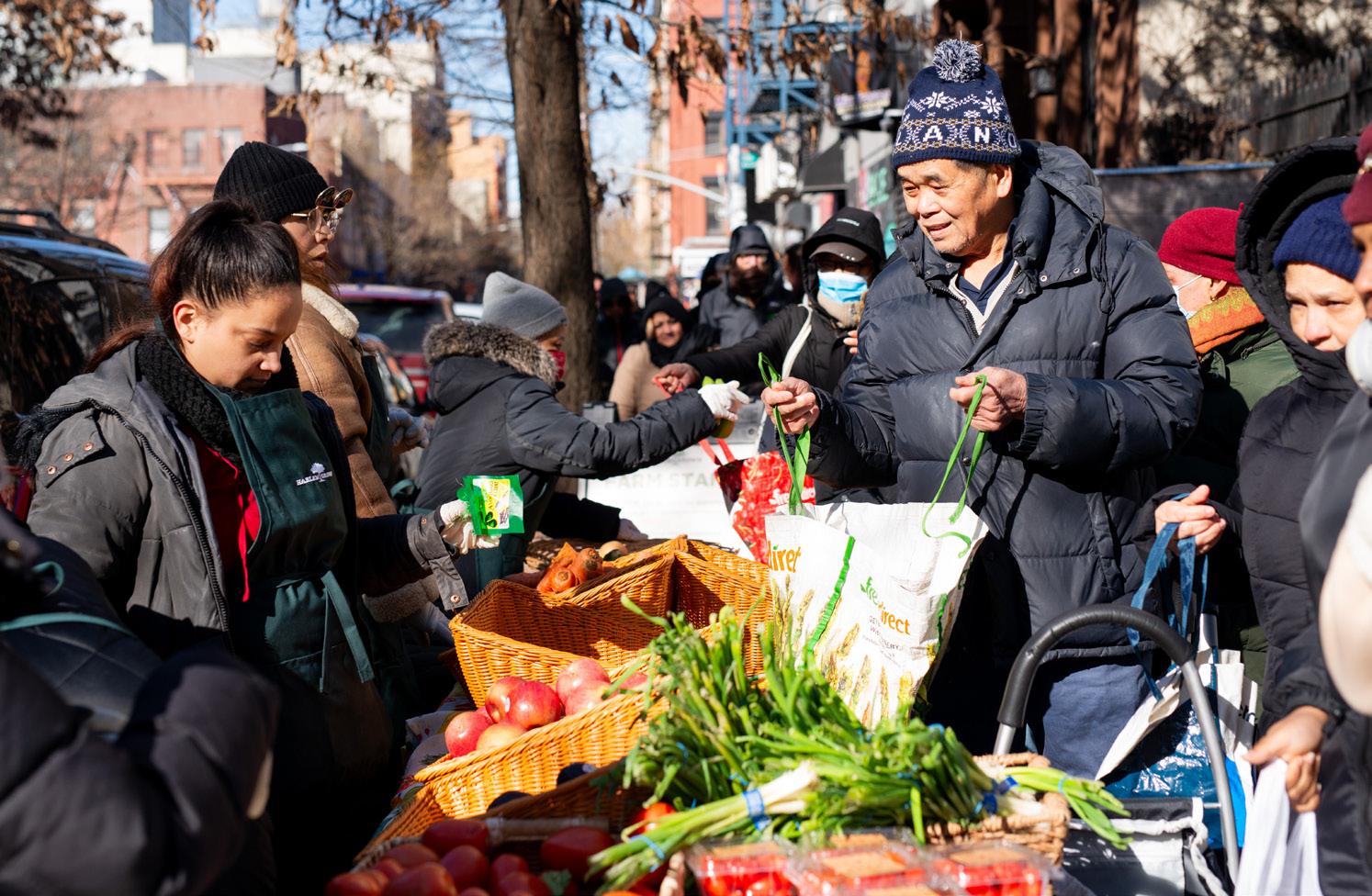
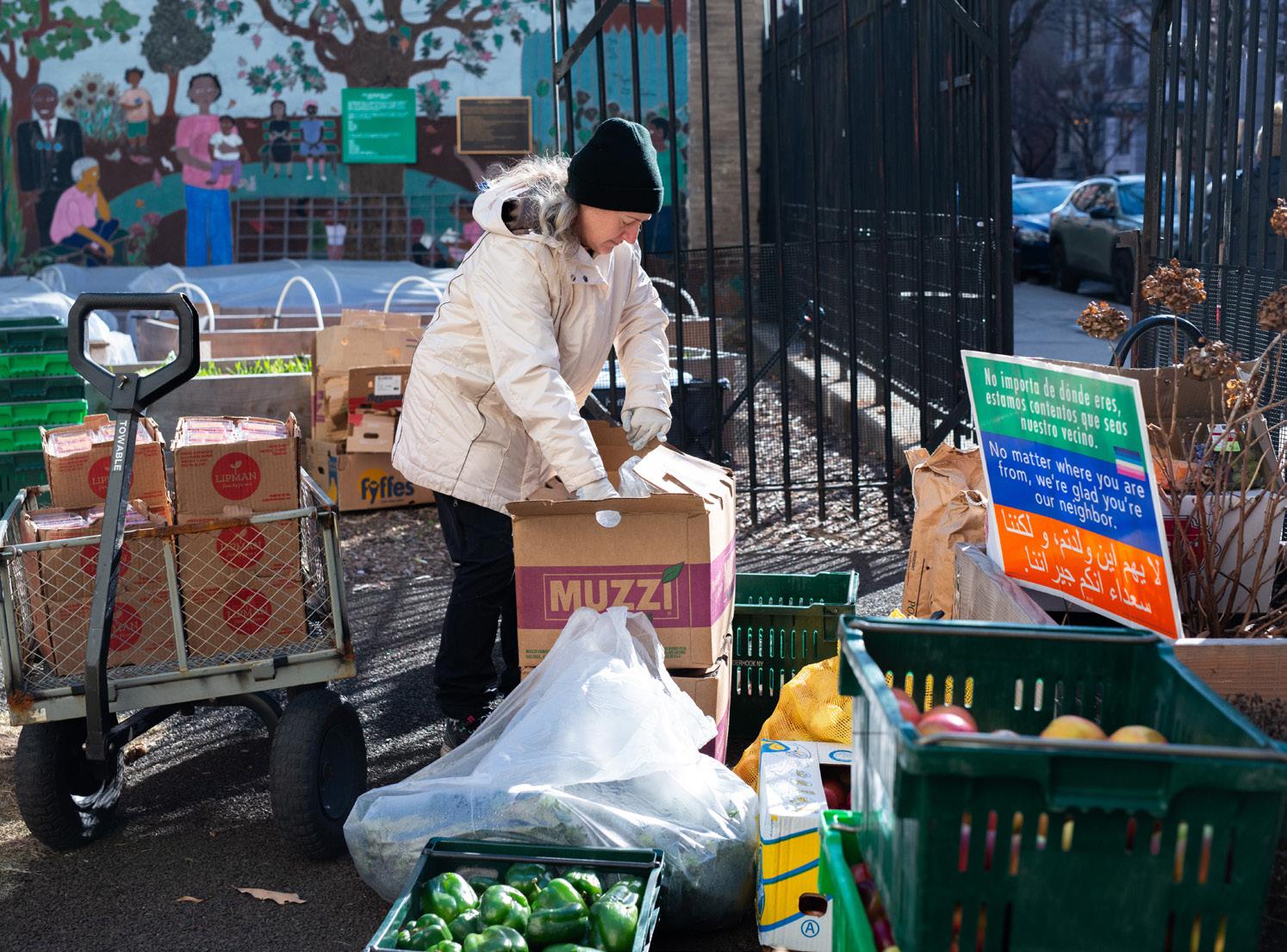
The Black Panthers started a free breakfast program in 1969. While a national feeding program for students existed nationwide, it had its limits. The widely accessible lunch program was reduced-price, but not free.
The national breakfast program was limited to only a few schools.
The Panthers recruited mothers and solicited donations of money, food, and space to run the morning program. The model, which began in one church in Oakland, Calif., was replicated in 36 other cities by 1971. In a 1969 U.S. Senate hearing, even the National School Lunch Program administrator claimed that the Black Panthers fed more poor students than the entire state of California.
The FBI saw the party as a threat. A combination of party in-fighting and statesponsored raids and assassinations nearly dissolved all chapters — and their breakfast programs.
duce from the farmstand approached her as she refreshed the box of free seeds. “Do you take volunteers? How do I sign up?” he asked Assanah, Harlem Grown’s agricultural director.
“I’ll get you a card,” Assanah replied with a smile.
This is a typical scene at the Harlem Grown farmstand at their 127th Street location every Wednesday morning. People from all walks of life line up along the street, waiting for a bag of fresh produce, either grown from Harlem Grown’s urban farming operations (which include mushroom incubators, chicken coops, and hydroponically grown produce) or donated by one of their community partners.
According to their estimates, they help feed 150–200 people a week on average — and sometimes well more than 200 people during the summer.
Harlem Grown began in 2011, when the nonprofit’s founder, Tony Hillery, spent a few years volunteering at a local elementary school on 135th and Lenox Avenue. The school was directly across the street from a common occurrence in New York City: an abandoned lot.
“All of the children referred to it as the haunted garden — they didn’t want to walk past it. It was essentially being used as the block’s junkyard: People were dumping garbage in there,” said Safiya Raheem, Harlem Grown’s director of external affairs.
Where kids and their families saw a dumping site, Hillery saw an opportunity. He made a few calls to the NYC Parks and Recreation Department, and cleaned up the site. It was Assanah’s daughter, an elementary school student at the time, who suggested they grow something on the empty lot. Hillery promptly went to a store and began building the bones of a garden.
The mutual aid efforts weren’t all for nothing, though. In 1973, the U.S. government increased funding for its free and reduced lunch program and expanded the breakfast program to all schools.
The practice of mutual aid lives on and has had a resurgence in popularity since the pandemic. Be it pantry fridges, financial aid for missed rent, or free childcare, the practice lives on in neighborhood nonprofits and ad-hoc neighborhood groups alike.
On a Wednesday morning at 127th Street and Malcolm X Boulevard, Latonya Assanah speed-walked back and forth from the Harlem Grown Farm and a makeshift farmstand on the sidewalk.
“Free seeds! Free seeds!” she yelled to the growing crowd of people lining down the street. “You can grow your own food, too!”
An older man with a full bag of fresh pro-
Assanah, who was a parent volunteer when she started, said the idea for the farmstand was a natural offshoot of Harlem Grown’s expanding program offerings and diversifying production into hydroponics. Not only was the original 135th Street site an outdoor classroom to teach children about food systems and nutrition, but in a few years, it was also a fully productive urban farm.
Since they already had Saturday programming, they began to give away the food they were growing, first to their student families, then to the neighboring community. “We already had a Saturday program, so we said, ‘Let’s set out a table, and let’s [put] the produce that we’re growing on this table for anyone to come and take it and have,’” recalled Assanah.
The popularity of the farm stand skyrocketed during the pandemic. “COVID happened. Then it was, ‘How can we all connect?’ And this food is still growing,” said Assanah. That’s when the nonprofit began seeing those averages of 150–200 people attending their farmstand every week — and those numbers have remained steady ever since.
And as the need grew, so did the number
See HARLEM GROWN on page 31

IN ONE BROOKLYN NEIGHBORHOOD, A TRANSIT COP DEVOTED HIS LIFE TO SERVICE — LONG BEFORE HE MADE THE ULTIMATE SACRIFICE KEEPING HIS LEGACY ALIVE

In the 1980s,=ïÜÉå=oçÄÉêí=bK=sÉå~ÄäÉ=ï~ë=~=óçìåÖ=ã~åI=ÜÉ=ï~ë=ïçêâáåÖ=~ë=~=íÉ~ÅÜÉêÛë=~áÇÉ=áå=~=Ç~ó Å~êÉ=ÅÉåíÉê=áå=íÜÉ=`áíó=iáåÉ=åÉáÖÜÄçêÜççÇ=çÑ=_êççâäóå=~í=íÜÉ=nìÉÉåë=ÄçêÇÉê=~åÇ=íÜÉ=_êççâäóåJnìÉÉåë=bñéêÉëëï~óK ^í=íÜ~í=íáãÉI=áí=ï~ë=çåÉ=çÑ=íÜÉ=ÅáíóÛë=ÑçêÖçííÉå=ÇáëíêáÅíëI=é~êíáÅìä~êäó=íÜÉ=é~êâ=~Åêçëë=íÜÉ=ëíêÉÉí=Ñêçã=Üáë=ïçêâéä~ÅÉK qÜ~í=é~êâ=ï~ë=äáííÉêÉÇ=ïáíÜ=íê~ëÜI=çîÉêÖêçïå=ïáíÜ=ÄìëÜÉë=~åÇ=ëíêÉïå=ïáíÜ=ìëÉÇ=ÇêìÖ=é~ê~éÜÉêå~äá~K=qÜÉ áåÑê~ëíêìÅíìêÉ=Ñçê=Ä~ëâÉíÄ~ää=çê=çíÜÉê=ëéçêíë=ï~ë=ÉáíÜÉê=Ç~ã~ÖÉÇ=çê=åçå=ÉñáëíÉåíK sÉå~ÄäÉ=ï~ë=ÇÉíÉêãáåÉÇ=íç=Çç=ëçãÉíÜáåÖ=~Äçìí=áíK=eÉ=êÉÅêìáíÉÇ=íÉÉå~ÖÉêë=Ñêçã=íÜÉ=Åçããìåáíó=~åÇ=çíÜÉê ~ÄäÉJÄçÇáÉÇ=îçäìåíÉÉêë=íç=ÜÉäé=Üáã=ÅäÉ~å=ìé=íÜÉ=ãÉëëI=Åìí=Ä~Åâ=~åÇ=íÉåÇ=íç=íÜÉ=ëÜêìÄÄÉêó=~åÇ=êÉëíçêÉ=çê=êÉéä~ÅÉ ëéçêíë=ÉèìáéãÉåíK=sÉå~ÄäÉ=å~áäÉÇ=ìé=íÜÉ=Üççéë=Ä~ÅâÄç~êÇ=ÜáãëÉäÑ=~åÇ=~ÑÑáñÉÇ=íÜÉ=êáã=~åÇ=åÉíK=eÉ=~åÇ=Üáë=ÅçÜçêíë é~áåíÉÇ=íÜÉ=ÅçåÅêÉíÉ=ëìêÑ~ÅÉ=ïáíÜ=íÜÉ=íê~Çáíáçå~ä=ã~êâáåÖë=çÑ=~=Ä~ëâÉíÄ~ää=ÅçìêíK=jçëí=áãéçêí~åíäóI=ÜÉ=çêÖ~åáòÉÇ ~=Öêçìé=íç=ÜÉäé=Üáã=ãçåáíçê=íÜÉ=é~êâÛë=ÅçåÇáíáçå=~åÇ=ã~âÉ=ëìêÉ=íÜÉ=éêÉãáëÉë=êÉã~áåÉÇ=ÅäÉ~å=~åÇ=ëÉÅìêÉK oçÄÉêí=sÉå~ÄäÉ=~äï~óë=ï~ë=~=ÅçããìåáíóJëéáêáíÉÇ=ÅáíáòÉåI=ïÜáÅÜ=ï~ë=çåÉ=çÑ=íÜÉ=êÉ~ëçåë=ïÜóI=áå=NVUQI=ÜÉ ÄÉÅ~ãÉ=~å=kv`=qê~åëáí=ÅçéK=qÜÉ=àçÄ=ÇáÇåÛí=ëíçé=Üáã=~åÇ=Üáë=íÉÉå~ÖÉ=íÉ~ã=Ñêçã=âÉÉéáåÖ=ìé=íÜÉáê=ã~áåíÉå~åÅÉ=çÑ=íÜÉ é~êâI=~åÇ=~ë=~å=çÑÑáÅÉê=ÜÉ=ÄÉÅ~ãÉ=~=ÅçìåëÉäçê=áå=~=ÇêìÖ=éêÉîÉåíáçå=éêçÖê~ãK=få=Üáë=ëé~êÉ=íáãÉI=ÜÉ=~êê~åÖÉÇ=ëéçêíë ÉîÉåíë=~åÇ=ÉñÅìêëáçåë=Ñçê=íÜÉ=ÅçããìåáíóÛë=óçìíÜ=~åÇ=ÜÉ=ïçìäÇ=éÉêáçÇáÅ~ääó=ÅÜÉÅâ=íÜÉáê=êÉéçêí=Å~êÇë=Ó=åçí=Ñçê=íÜÉáê Öê~ÇÉë=Äìí=Ñçê=íÜÉáê=~ííÉåÇ~åÅÉ=êÉÅçêÇëK=eÉ=Å~êÉÇ=åçí=~Äçìí=Üçï=ëã~êí=íÜÉó=ïÉêÉ=Äìí=Üçï=Ü~êÇ=íÜÉó=ïÉêÉ=íêóáåÖ=íç ÖÉí=~å=ÉÇìÅ~íáçåK=^=ÖççÇ=~ííÉåÇ~åÅÉ=êÉÅçêÇ=ïçìäÇ=ãÉ~å=~=ãÉ~ä=~í=jÅaçå~äÇÛë=çê=ëçãÉ=çíÜÉê=íêÉ~íK=qç=íÜÉ=åÉáÖÜ ÄçêÜççÇ=óçìíÜ=~åÇ=çíÜÉêë=áå=íÜÉ=ÅçããìåáíóI=oçÄÉêí=sÉå~ÄäÉ=ï~ë=~=ÜÉêç=ÉîÉå=ÄÉÑçêÉ=ÜÉ=ÄÉÅ~ãÉ=~=éçäáÅÉ=çÑÑáÅÉêK qÜÉå=Å~ãÉ=íÜÉ=åáÖÜí=çÑ=pÉéíK=OOI=NVUTK=sÉå~ÄäÉ=ï~ë=ëä~íÉÇ=íç=ïçêâ=áå=éä~áåÅäçíÜÉë=~ë=é~êí=çÑ=~=íÉ~ã=íê~åëéçêíáåÖ éêáëçåÉêëK=^ë=ÜÉ=Ü~Ç=ÇçåÉ=ãçëí=ÉîÉåáåÖëI=ÜÉ=Å~ääÉÇ=Üáë=UJóÉ~êJçäÇ=Ç~ìÖÜíÉê=g~åì~êá=íç=íÉää=ÜÉê=ÜÉÛÇ=ÄÉ=ä~íÉK=aìêáåÖ íÜ~í=åáÖÜíÛë=íçìêI=sÉå~ÄäÉ=~åÇ=ëáñ=çíÜÉê=qê~åëáí=Åçéë=áåíÉêêìéíÉÇ=íÜÉ=éêáëçåÉê=íê~åëéçêí=íç=êÉëéçåÇ=íç=~=Å~ää=çÑ=~å ~êãÉÇ=ã~å=çå=åÉ~êÄó=máíâáå=^îÉåìÉK=qÜÉó=ïÉêÉ=ëÉ~êÅÜáåÖ=íÜÉ=~êÉ~=ïÜÉå=íïç=ÖìåãÉå=Äìêëí=çìí=çÑ=~=ÄìáäÇáåÖ=~åÇ çéÉåÉÇ=ÑáêÉK=sÉå~ÄäÉ=ï~ë=ëíêìÅâ=áå=íÜÉ=ÜÉ~ÇK=eÉ=ï~ë=êìëÜÉÇ=íç=íÜÉ=Üçëéáí~äI=ïÜÉêÉ=ÜÉ=ÑçìÖÜí=ìåíáä=Üáë=Ñáå~ä=ÄêÉ~íÜK eÉ=ï~ë=PR=óÉ~êë=çäÇK
f=ï~ë=íÜÉ=ä~ëí=çåÉ=áå=íÜÉ=Ñ~ãáäó=íç=í~äâ=íç=ÜáãIÒ=g~åì~êá=sÉå~ÄäÉ=êÉãÉãÄÉêëK=eÉ=ë~áÇ=ÜÉ=Ü~Ç=~å=~êêÉëí=ëç=ÜÉ ï~ë=ÖçáåÖ=íç=ÄÉ=ÜçãÉ=ä~íÉK=eÉ=ë~áÇI=Údç=íç=ÄÉÇÛ=ÄÉÅ~ìëÉ=f=ìëÉÇ=íç=ï~áí=ìé=Ñçê=ÜáãKÒ qÜÉ=âáääÉêI=ïÜç=ïáää=ëççå=ÄÉ=ìé=Ñçê=é~êçäÉI=Ü~Ç=ÄÉÉå=çìí=çÑ=éêáëçå=çå=é~êçäÉ=Ñçê=àìëí=QO=Ç~óë=ïÜÉå=ÜÉ=ÅçããáííÉÇ íÜÉ=ãìêÇÉêK

lÑÑáÅÉê=sÉå~ÄäÉÛë=ÇÉ~íÜ=ÇáÇ=åçí=ëéÉää=íÜÉ=ÉåÇ=çÑ=íÜÉ=ÉÑÑçêí=íç=ã~áåí~áå=íÜÉ=é~êâK=få=Ñ~ÅíI=Üáë=ëÜáåáåÖ=Éñ~ãéäÉ áåëéáêÉÇ=íÜÉ=Åáíó=ÖçîÉêåãÉåí=íç=ÖÉí=áåîçäîÉÇK=få=NVUVI=íÜÉ=m~êâë=aÉé~êíãÉåí=ëéÉåí=ANKQ=ãáääáçå=íç=êÉÑìêÄáëÜ=íÜÉ=ëáíÉ Ó=ÄçìåÇÉÇ=Äó=_Éäãçåí=^îÉåìÉI=pìííÉê=^îÉåìÉI=pÜÉêáÇ~å=^îÉåìÉ=~åÇ=dê~åí=^îÉåìÉ=Ó=~åÇ=çÑÑáÅá~ääó=å~ãÉÇ=áí=oçÄÉêí bK=sÉå~ÄäÉ=m~êâK=fí=åçï=Ü~ë=çéÉåáåÖ=~åÇ=ÅäçëáåÖ=Üçìêë=~åÇ=áë=êÉÖìä~êäó=ëí~ÑÑÉÇ=Äó=m~êâë=aÉé~êíãÉåí=éÉêëçååÉäK lÑ=ÅçìêëÉI=íÜÉ=ÉñíÉåÇÉÇ=sÉå~ÄäÉ=Ñ~ãáäó=~äëç=êÉã~áåë=ÇÉÇáÅ~íÉÇ=íç=íÜÉ=é~êâÛë=éêÉëÉêî~íáçåK=tÉ=Ü~îÉ=~ää=îçïÉÇ íç=îáëáí=íÜÉ=é~êâ=~ë=çÑíÉå=~ë=éçëëáÄäÉ=~åÇ=ãçåáíçê=áíë=ìéâÉÉéIÒ=ë~óë=g~åì~êá==sÉå~ÄäÉK=^åÇ=áíÛë=~äï~óë=áãã~Åìä~íÉKÒ

By ARIAMA C. LONG Amsterdam News Staff
New York City turns 400 years old this year and centuries of literal blood, sweat, and tears have gone into making the city what it is — a titan of industry, a bastion of culture, a tiny archipelago with millions of people, and a place that has always been home to immigrants of all kinds.
The latest census data shows that about 36% of the city’s 8.2 million population is “foreign-born.” It’s a hard pill for many New Yorkers to swallow that anti-immigrant hate is prevalent in not only the country in 2025, but a city literally built by enslaved African labor and currently captained by the city’s second Black mayor.
Since the very beginning immigrants have been a part of the foundation of what would be New York City, according to the state’s New York Quadricentennial Committee. Juan Rodriguez (possibly Rodrigues) was the first “non-indigenous inhabitant” who arrived on a Dutch ship and opted to stay in 1613. He worked for the first Dutch fur trading post. He was of Portu-
guese and West African descent, but born in Santo Domingo, Hispaniola (now known as the Dominican Republic). Little is known about his life, but he is considered representative of people within the African diaspora at the time who traveled “the Atlantic world” out of bondage.
The colony started out as Dutch settlements on Nutten (now Governor’s) Island, populated with predominantly French colonizing families in 1624. The land was stewarded by the indigenous tribes of the Lenape Native Americans for thousands of years prior to that. In 1625, Fort Amsterdam was constructed on Mannahatta (now Manhattan) at the southern tip of the island where the Alexander Hamilton U.S. Custom House is. By 1626, the Lenape “bartered” with the Dutch for the rights to use Manhattan for the colony of New Amsterdam.
Between 1626 and 1627, a Dutch slave ship brought the first enslaved Africans to the colony, according to the Schomburg Center for Research in Black Culture. There were 11 men and women from the Congo, Angola, and the island of São Tome. About 18 years later, the men had petitioned the Dutch for their freedom and were given land in exchange for food contributions to the colony. Their wives were freed, too, but their children remained enslaved. When the colony was taken over by the British in 1664, it was composed of people
with many nationalities, including Dutch, English, Welsh, Irish, Scottish, German, French Huguenot, Sephardic Jewish, and African.
As the colony expanded into a city so did the “aggressive increase” in the slave trade, leading to the opening of an official slave market in 1711 on Wall Street. By 1730, about 42% of the population owned African and Caribbean men, women, and children, whose labor built the city and was the “engine” that made its economy run.
When people think of the archetypal immigrant arriving in New York City with a bag, no money, and a dream, Ellis Island and the Statue of Liberty are usually somewhere in the backdrop. The processing center on Ellis Island for those newly arrived, mostly from Europe, saw more than 12 million immigrants from 1892 to 1954. Passenger logs indicate that plenty of famous and influential leaders in literature, art, and science also came through Ellis Island over the years, including renowned poet and writer Claude McKay.
“The rich culture and strength of New York City neighborhoods stands on the shoulders of Black immigrants like Pierre Touissant, Arturo Schomburg, Celia Cruz, Claude McKay, Shirley Chisholm, and Lamuel Stanislaus,” said former Assemblymember Bronx Michael Blake. “There is no New

York City without immigrants from the African diaspora. We are business owners, police and firefighters, nurses and scientists, and the curators of a culture that makes New York the greatest city in the world.”
McKay was born in Jamaica in 1889 as Festus Claudius McKay. His first arrival to the U.S. was in 1912, where he studied agriculture at the Tuskegee Institute and Kansas State Agricultural College. He began his writing career as he travelled the country working as a Pullman porter and dock hand. His works led him to be one of the first leading figures in the Harlem Renaissance, authoring novels, manuscripts, and poems about the Black experience and the human condition. He also travelled the world, including trips to Europe and the Soviet Union.
Of course, New York City’s Harlem was not only responsible for hosting the world’s most influential immigrant artists. The “Black Mecca,” as it was called, was a platform for some of the most radical and provocative thought leaders of the time.
Marcus Mosiah Garvey Jr., who was also from Jamaica, developed philosophies that would go on to inspire the Nation of Islam, the Black Power movement, the Rastafari movement, and others. A staunch Pan-African nationalist, he founded the Universal Negro Improvement Association (UNIA) in Jamaica in 1914. He pushed support for his Black-owned ship line, which eventually led him to
be charged with fraud, and controversially believed in racial separatism rather than integration. Garvey was deported from the U.S. in 1927, but continued his organization in his native country. He was pardoned posthumously by former President Joe Biden last month.
Generations to Come
Perhaps the most significant part of immigrants’ contribution to the city’s makeup is the second, third, and fourth generations of artists, doctors, lawyers, business owners, and political powerhouses that chose to stay here and make America great.
“The resilience of the African Diaspora is evident in every step we take forward, despite the injustices that have tried to hold us back,” said Khari Edwards, a candidate in this year’s race for Brooklyn borough president. “When my wife and I visited Ghana for the first time, standing inside the dungeons of Elmina and Cape Coast Castles, we witnessed the haunting reality of what our ancestors endured — ripped from their homeland, beaten, raped, separated from their families, and tortured, only to be forced onto slave ships to build a society that still, to this day, refuses to see their full humanity. Yet, more than 400 years later, we see the extraordinary strength and accomplishments of their descendants.” World-renowned civil rights
See BLACK IMMIGRANTS on page 27



on March 1
faith, and anchor organizations launch a solutions-based series for positive change
By KAYLYN KENDALL DINES
Special to the AmNews
If you value public safety, care about policing, and want to participate in a sustainable, equity-driven movement for change, there’s a program for you coming up on Mar. 1.
Law enforcement executives, educators, business leaders, policymakers, and students will kick off a series of programs about public safety and policing with a symposium at Kean University (Union, N.J.) on Saturday, Mar. 1, from 10:00 a.m. to 3:00 p.m., as part of a series on such topics. Lamont O. Repollet, Ed.D., a member of Phi Beta Sigma Fraternity, Inc., is the 18th university president.
A representative of the N.J. Office of the Attorney General will present opening remarks. Marc H. Morial, president and CEO of the National Urban League and a member of Alpha Phi Alpha Fraternity, Inc., will present a keynote address. Other speakers include New Jersey Assemblywoman Shavonda E. Sumter, City of Paterson, N.J., chair of the NJ Legislative Black Caucus; Adrian O. Mapp, mayor of the City of Plainfield, president and chair of the New Jersey Urban Mayors Association, and a member of Phi Beta Sigma Fraternity, Inc.; Cumberland County Prosecutor Jennifer Webb-McRae, of Vineland, NJ, who is a member of Alpha Kappa Alpha Sorority, Inc.; and Rev. Dr. Charles Boyer, pastor of Greater Mount Zion A.M.E. Church of Trenton, who co-founded Salvation and Social Justice with his wife, First Lady Rosalee Boyer.
Also on the program are Jerome Hatfield, senior vice president of Integrated Health, Safety, and Response Services at Kean University. Joseph Youngblood, II, Ph.D., a senior vice president of Transformational Learning and External Affairs at Kean University and a member of Alpha Phi Alpha Fraternity, Inc., will be moderator of the event.
The New Jersey Chapter of the National Organization of Black Law Enforcement Executives (NOBLE NJ), Positive Com-

munity, New Jersey Urban Mayors Association, and John S. Watson Institute for Urban Policy and Research at Kean University are presenting this event, which is free and open to the public.
“Collectively, as host organizations, we are planning this event because we believe in taking action. Action speaks,” said Barbara George Johnson, M.P.H., J.D., vice president of external affairs and urban policy and research at Kean University and a member of Alpha Kappa Alpha Sorority, Inc. “This is a solutions-orientated series that will bring together thought leaders, policymakers, community advocates, and scholars. Together, we will explore and advance innovative strategies that address critical issues in policing and public safety. Participants attending these interactive sessions will identify actionable solutions to foster sustainable, community-centered, and equity-driven approaches to public safety.”
Although the event title is “Let’s Talk About Public Safety and Policing,” participants can expect to do more than talk. Breakout session discussions will explore real-life experiences, solutions, best practices, and innovative ideas. Results and outcomes from each event in the series will be reviewed, analyzed, and translated into community action plans by public policy experts at the John S. Watson Institute for Urban Policy and Research at Kean University.
The institute is a nonpartisan resource for decision-makers in New


Jersey. Its motto is “Linking People to Policy,” which it does through supporting the development and implementation of solutions to many societal issues. Legislators and policymakers look to the institute for insights and data for navigating a variety of complex societal issues.
Some of the topics the series will cover are:
• Strengthening relationships between law enforcement and the communities they serve;
• Policy and oversight reforms for public safety agencies;
• Social determinants of health and community well-being;
• The role of technology and social media in shaping public perceptions of policing and safety; and
• Urban violence prevention strategies and equity-centered solutions. According to Jiles H. Ship, chapter president of NOBLE New Jersey,
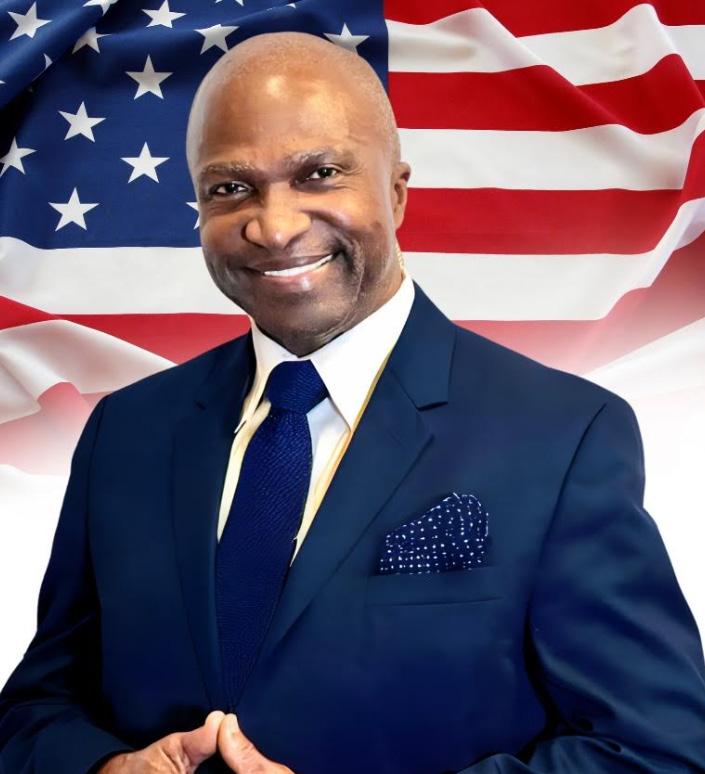
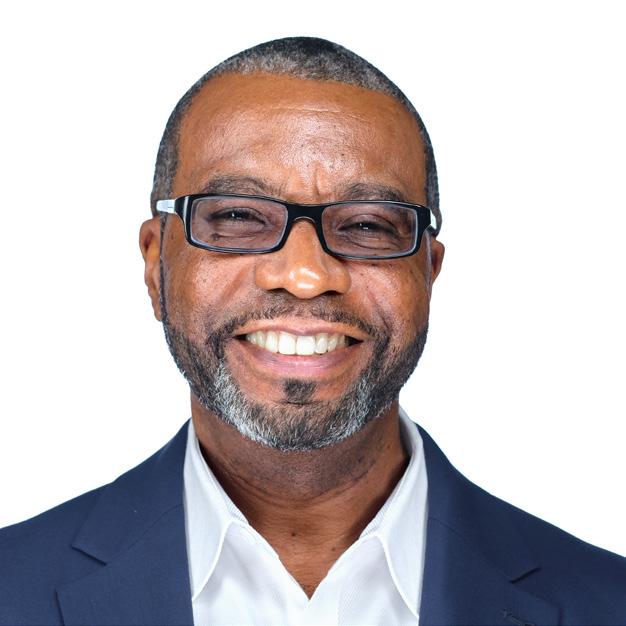
a commissioner of the New Jersey Police Training Commission, and a member of Omega Psi Phi Fraternity, Inc., the second session in the series will take place on Apr. 15 in Atlantic City. Ship believes in addressing policy change and advocating for community-driven solutions to public safety and policing issues. Register for the first session at https://bit.ly/PublicSafetySeriesRegistrationForm. For more information, send an email to watson@kean.edu.
The Divine Nine News column highlights the service and achievements of members from the National PanHellenic Council’s fraternities and sororities. Ideas for coverage of community-service initiatives, personal accomplishments, and upcoming events may be sent to: https://amsterdamnews.com/d9news and d9@amsterdamnews.com.
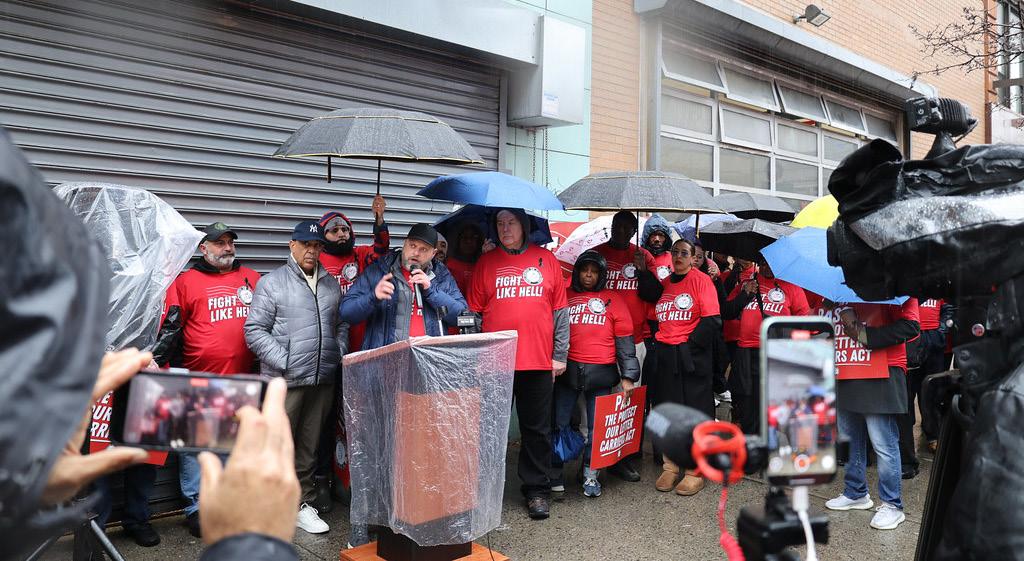
By KAREN JUANITA CARRILLO Amsterdam News Staff
Members of the National Association of Letter Carriers (NALC) recently held a rally in front of Harlem’s Manhattanville Post Office on West 125th Street.
NALC members joined with residents and local politicians to speak out about the increase in assaults against U.S. postal workers and how it is affecting their lives and work.
“It was cold and just pouring down rain, but it was a good turnout,” said national NALC President Brian Renfroe in an interview with the AmNews. “We were right there in front of the Manhattanville Station Post Office. And we’ve done events like this over the last, I’d say, year and a half all over the country. The reason we do them is just to raise community awareness about these issues that are happening.”
NALC, which represents 295,000 active and retired mail delivery workers, has been coordinating these rallies to draw attention to increasing incidents of assault and other crime against the country’s uniformed
letter carriers. Last year, the U.S. Government Accountability Office (GAO) reported that “cases of serious crime [against letter carriers] have increased almost every year from fiscal years 2017 through 2023. This is largely due to an increase in robbery cases, which increased nearly sevenfold from fiscal years 2019 through 2023.
GAO’s review found that these robberies have generally targeted letter carriers, increasingly involved firearms, and targeted the universal keys which USPS employees use to access mailboxes.”
There have been more frequent cases of New York City mail carriers getting robbed at gunpoint and occasionally assaulted for their mailbox keys. There have also been instances of criminals prying open mailboxes to steal checks and credit cards. And last month, Ray Hodges, a 36-yearold postal worker, was tragically stabbed to death while in uniform and on duty, reportedly after stepping in front of his assailant to place an order at a Harlem deli.
“The murder of Ray Hodges was horrific,” said Renfroe. “In addition to that, we’ve had several armed robberies, so the idea
of raising community awareness among the people in the community, the people that we serve, is important. They 100 percent support us being safe, that almost goes without saying. But the more they are aware –– the more the public expresses concern about this –– it really has a dual benefit for us.”
NALC is calling for the passage of the Protect Our Letter Carriers Act, a bipartisan bill that would give the U.S. Postal Service the funding to, in the span of five years, update their lock and key system for securing postal mailboxes and standardize sentencing guidelines for assaults on letter carriers.
“That legislation,” said Renfroe, “would also designate a prosecutor in every U.S. Attorney’s Office to prioritize these crimes, and it would modify the sentencing for these crimes. Currently – and I by no means am an attorney or an expert on federal sentencing guidelines, I just know we’ve had some really pretty wild inconsistencies and some very light sentences. So it would modify the sentencing guidelines so that they would be the same for a similar crime committed against a federal law enforcement officer. It’s really
all just designed to deter people from committing these crimes.
“You know, the Postal Service has been around for 250 years. And until just a few years ago, there was just sort of a mindset, I think, among the public that a letter carrier was a public servant, they’re part of the community [and] they’re a federal employee. And even in what otherwise would be considered the most dangerous neighborhoods, nobody bothered the letter carrier. But that’s changed. And what we’ve seen there in Harlem over the last couple of months is, you know, really, really strong evidence of that.”
NALC plans to continue holding rallies across the country to support passage of the Protect Our Letter Carriers Act. The next rally should take place in Philadelphia and organizers are trying to settle on a date and time for the event.
“We as a union are going to ‘Fight like hell,’” added Renfroe. “That’s been the mantra to get this legislation done and be sure the community is aware of this and be sure the people that commit these crimes are held accountable.”

By MARIELLE ARGUEZA Special to the AmNews
Woodlawn Cemetery is an unmissable landmark. Located at the end of the four-train, the Bronx cemetery, which began as a small plot in 1868, has now expanded to 400 acres — half the size of Central Park — with 17 miles of paved, walkable roads.
Even a fresh layer of January snow can’t hide the rolling hills lined with uniform rows of simple headstones or the interspersed ornate memorials, mausoleums, and statues that could be in a museum. In a way, it is a museum — or at least, it’s just as culturally important.
“We are a large, publicly accessible space,” said Meg Ventrudo, executive director of the Woodlawn Conservancy. “Students and graduate students can come and research these notable individuals that are here, and we do tours, so we’re not a museum per se, but people can come on these tours to have a cultural experience. It is more than a notable burial ground, but it is a tourist destination for all of our neighbors to just wander through.”
Ventrudo and her team have been making the case for Woodlawn as a historically important and culturally relevant destination for years. In addition to being an active burial ground and crematorium, Woodlawn attracts approximately 100,000 visitors from around the world each year.
From newspaper magnate Joseph Pulitzer and investigative reporter Nellie Bly to the ultra-wealthy Astors and women’s rights advocate Elizabeth Cady Stanton, Woodlawn Cemetery is the final resting place of many famous New Yorkers. It was one of the only major non-sectarian cemeteries at the time when mixed-race or interfaith marriages weren’t even allowed.
“Woodlawn never discriminated,” said Ventrudo. “There was no sectioning. There was no African American section, no Jewish section, no Italian section.”
These policies, which continue today, have resulted not only in the largest collection of funerary art in the nation but also in one of the
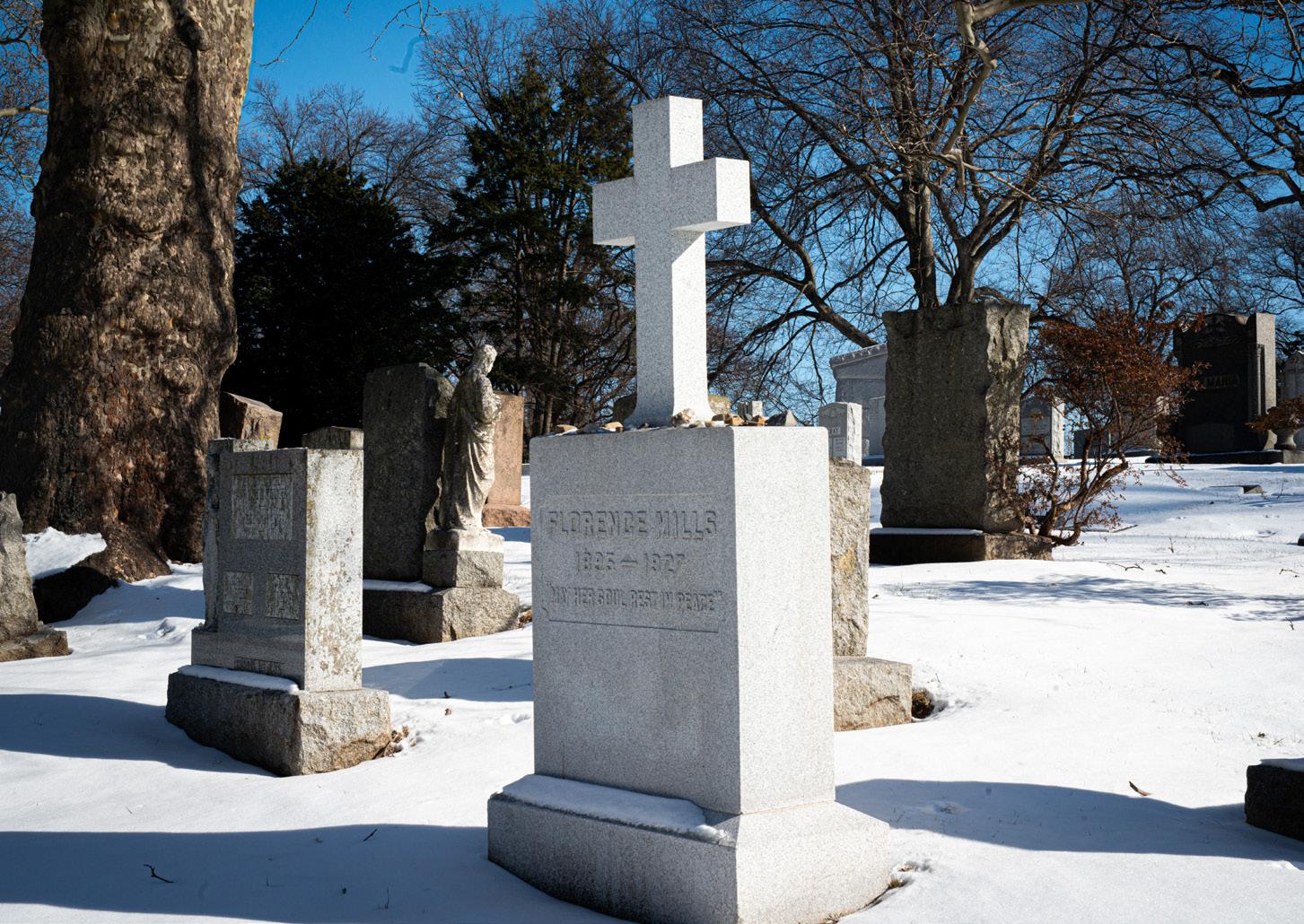
most accurate archives of New York City through major industries and social and cultural movements.
This includes being a popular burial site for prominent Harlem Renaissance figures. Although most visitors know about names like trumpeter and composer Miles Davis (his massive headstone is hard to miss, standing taller than most grown men), vaudeville entertainer and “Queen of Happiness” Florence Mills, or self-made millionaire and arts patron Madam C.J. Walker, lesser-known or completely unknown contributors are there, too.
The latter are the contributors that Ventrudo and her team want to find next in their newest project: Where Harlem Rests. The interactive walking tour of Woodlawn Conservancy, which will include an historical booklet, map, and new exhibition signs, is funded by a $50,000 grant from the African American Cultural Heritage Action Fund.
Last year, Woodlawn Cemetery was one of a handful of sites that received a grant from the Action Fund, which was the National Trust for Historic Preservation’s response to the 2017 protests in Charlottesville, Virginia, and the subsequent national debates about glorifying and memorializing the Confederacy. Since its creation, the Action Fund has raised $150 million to help preserve 304 historical sites significant to Black culture that would otherwise have been underfunded and overlooked, such as John and Alice
Coltrane’s Philadelphia home and Nina Simone’s childhood home in Tryon, North Carolina.
According to Brent Leggs, executive director of the Action Fund, the preservation movement historically centered on the accomplishments of white men through a Eurocentric historical lens — but that’s changing.
“More recently, the preservation movement has evolved [to] where we are more committed to telling the full history of our nation and increasing diverse representation, beyond architecture, beyond a white male history, into stories that inspire all Americans,” Leggs said.
Although Woodlawn is already a well-known cultural site for notable Black figures, Where Harlem Rests will go beyond that, said Susan Olsen, head historian of the Conservancy.
“I was born here,” she joked. Despite working for the nonprofit for 24 years, she is still discovering the stories and people contributing to local history. The Action Fund grant, she said, will allow them to do the necessary historical digging to piece together a more complete history of the Harlem Renaissance.
Their project was inspired by the work of historian Eric K. Washington, who wrote “Boss of the Grips,” the biography of James H. Williams, the nearly forgotten yet influential chief porter of Grand Central Station. Williams wasn’t a musician or
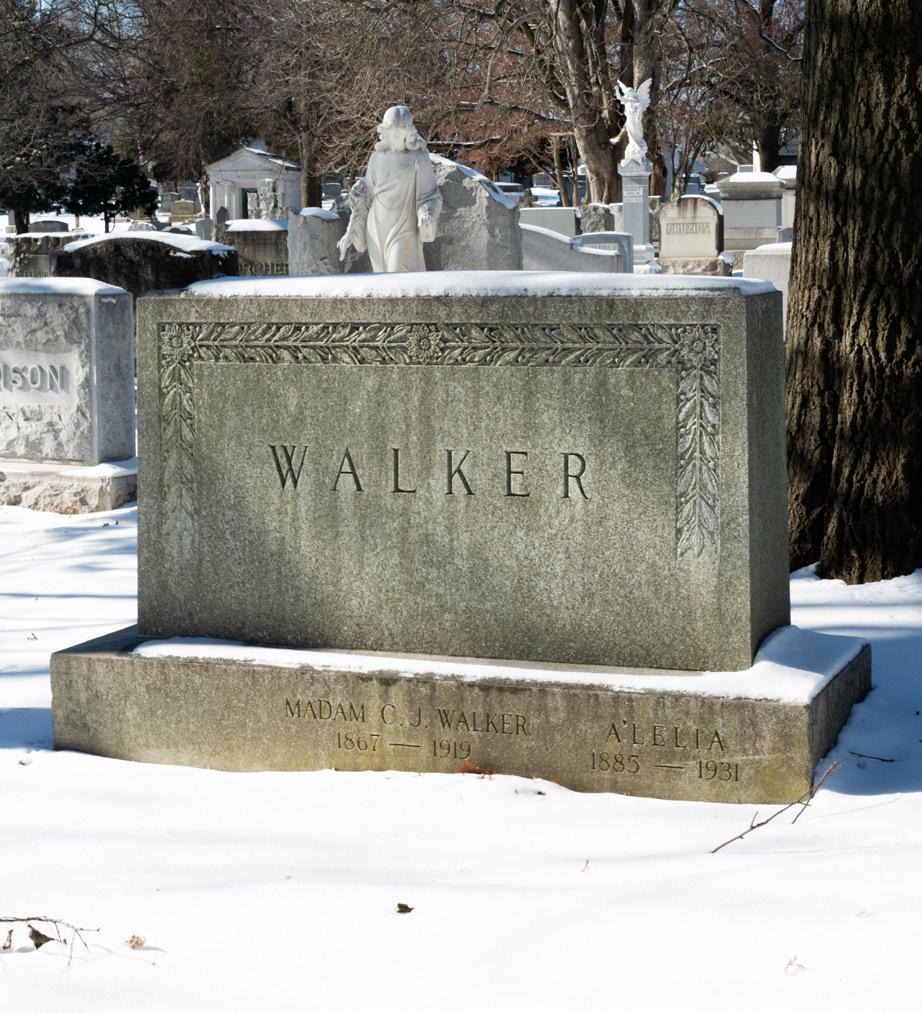
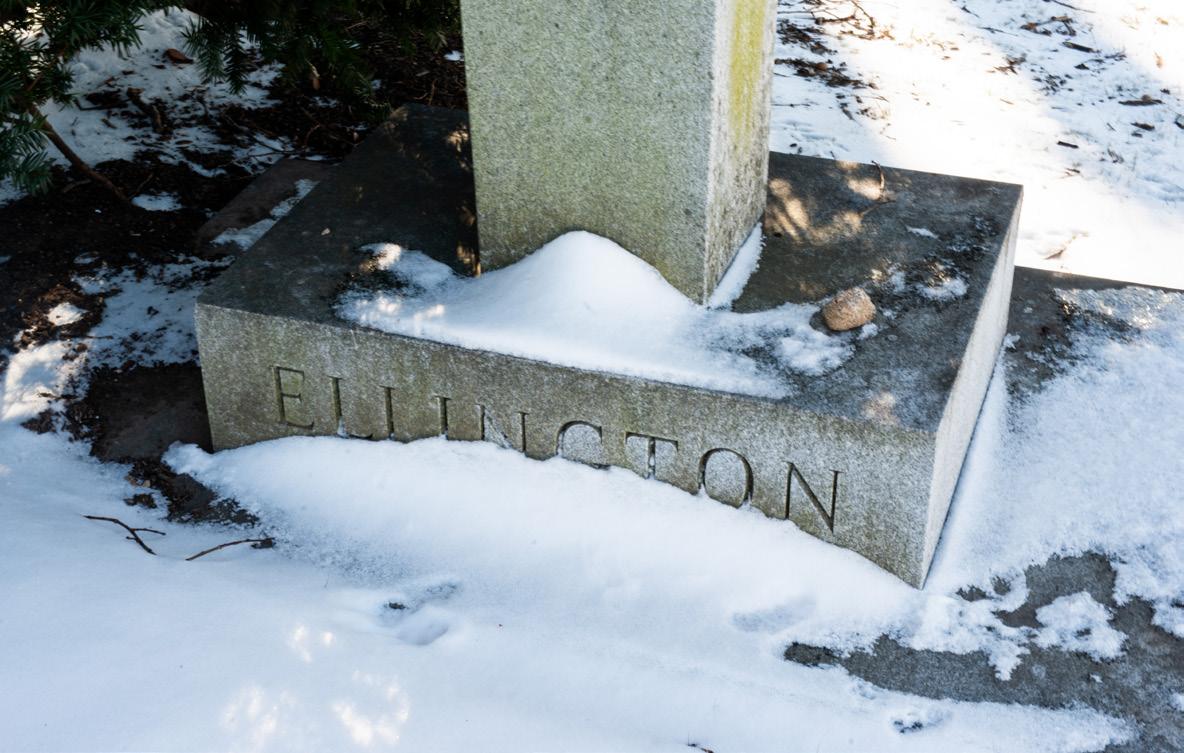
entertainer, but was one of the few Black men with the power to hire, organize, and lead other Black men during the burgeoning travel industry in the early 1900s.
“The fact that [Eric] was able to find all these folks and things … all of a sudden, we realized maybe we should be telling some other stories besides ‘here’s Duke Ellington and here’s Florence Mills’ … we have the Harlem Renaissance greats, but we didn’t know we had the owner of the Marshall Hotel, where all the gathering starts,” said Olsen.
“It’s this very interesting story,” said Ventrudo. “Who were the Black funeral directors? Were there funeral directors? Who were the Black nightclub owners and Black civil service folks? We don’t know, but we’re finding out.”
Washington has been hired as
the consulting historian for the Where Harlem Rests tour. With a team of volunteer historians, they scour archives and historical records for other notable figures whose words may not be enshrined in novels or whose music may not have lived on. Washington then verifies all sources. From there, the Conservancy can ideally connect a person with a burial site or even an unmarked grave and add them as an official part of the tour.
“There has been a tremendous amount of work to find people who should be recognized,” said Olsen.
The grant will also allow the Conservancy to partner with Bronx International High School and the city’s Summer Youth Employment Program, where students will learn how to care for the gravesites that will be featured on the tour.
As Malcolm and Martin might say – let the marches bloom!

As this story is filed on Feb. 18, it is a reminder that on this date in 1965, Malcolm X delivered his final public address at Barnard College, three days before he was assassinated at the Audubon Ballroom. Barnard College is only a few blocks from Riverside Church where Dr. King, two years before in 1967, delivered one of his most memorable speeches. The geographical proximity of these great leaders, two years apart, has greater irony when you consider that the war in Vietnam, brotherhood, and unity were important topics for both speakers.
Of deeper significance is the growing rapprochement between them, particularly on Malcolm’s part with his presence on three occasions at events where Dr. King was a featured speaker or attendee. Malcolm may have voiced some sarcasm about the historic March on Washington, calling it a “farce on Washington,” but nonetheless, he was there. When Dr. King returned from Oslo, Norway after receiving the Nobel Peace Prize, an event honoring him was held in Harlem at the 142nd Street Armory. Malcolm showed up and sat next to Andrew Young, who left the stage to greet him.

Martin Luther King, Jr. and Malcolm X meet before a press conference. Both men had come to hear the Senate debate on the Civil Rights Act of 1964. This was the only time the two men ever met; their meeting lasted only one minute. (United States Library of Congress’ Prints and Photographs division photo)
The third occasion was more deliberative when Malcolm journeyed to Selma, Alabama and spoke at Brown Memorial Chapel. At that time, Dr. King and Rev. Ralph Abernathy were in jail, but Malcolm met with Mrs. King, who had been coaxed by Andrew Young to meet with Malcolm. According to Mrs. King, Malcolm told her that he had Dr. King’s “back.” From this moment, she gained a better understanding of who Malcolm was and began convincing her husband of this newfound respect.
Malcolm and Martin only met once, and that was in the nation’s capital where both were there to witness the senate discussion on the Civil Rights Act. The photo of them together has been published numerous times. What was said has never been reported. But there is every indication that an accord and a mutual respect was taking shape between them.
By SAKINA JORDAN
During rush hour at Penn Station, a man was on the ground, foaming at the mouth. People hurried past, but I stopped. To just walk by would have betrayed my beliefs about community and human decency.
My eight-year-old son witnessed the man’s distress, the crowd’s apathy, and my intervention. He saw me call 911 and stay by the man’s side until help arrived. This moment was more than an act of kindness; it was a lesson for the next generation about the power of community.
Growing up, Harlem was a place of joyful celebrations, where we looked out for one another and elders were respected. It’s this spirit that we need to rediscover to stand together and overcome the challenges we face. As we celebrate Black History Month, let’s remember that this is a proud opportunity to nurture and continue to build healthier communities together.
Strength in unity
Raised in Harlem, I was immersed in a hub of African American culture, rich in music and art. Unfortunately, over time, this has been replaced by drugs and violence. When I began my career in social work, my mission was clear: to serve Harlem and extend my efforts to communities facing similar struggles. My definition of community evolved over time and now includes anyone underserved and grappling with systemic issues. Even though I am just one person, I know that every small act counts.
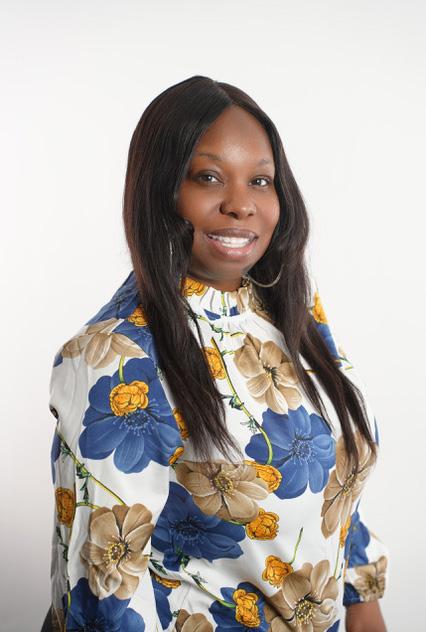
Elinor
R. Tatum:
Publisher and Editor in Chief
Damaso Reyes: Executive & Investigative
Editor
Kristin Fayne-Mulroy: Managing Editor
Cyril Josh Barker: Digital Editor
Siobhan "Sam" Bennett: Chief Revenue Officer and Head of Advertising
Wilbert A. Tatum (1984-2009):
In this centennial year of Malcolm’s birth, his unflinching resolve and challenge of racism, white supremacy, capitalism and imperialism, to say nothing of a similar stance taken by Dr. King, are more needed than ever. As we commemorate the lives and legacies of these two valiant warriors, their lives snuffed out at 39 years of age, let us join the increasing outrage against the Trump administration and its authoritarian rule. We are excited to see that a critical mass of protest is slowly emerging. Let it spread and grow!
The drug epidemic has created a type of community bonded by shared struggles. As a peer specialist, I engage directly with individuals battling addiction, some of whom I’ve known since childhood. They recognize and trust me, which facilitates meaningful interactions where I can offer practical help — checking their insurance, suggesting rehabilitation options, pointing them to food pantries or places to shower. These interactions show that recovery and a return to a supportive community environment are possible.
Rebuilding communities demands an onthe-ground, hands-on approach. My career began by engaging directly with underserved populations. These firsthand experiences taught me the value of empathy and active participation.
At MetroPlusHealth, I lead a team of 13 certified peer support specialists who draw on their personal battles with mental health and substance abuse to aid our members. These specialists, having achieved and maintained sobriety, continue to engage in their recovery by attending AA meetings and practicing ongoing self-care. This authenticity creates a profound connection with our members, making our approach more effective than conven-
tional methods. By sharing their journeys, our team members validate their understanding of the challenges our members face, enhancing the support they provide. As a community, we need to understand the specific, everyday challenges people face to develop effective overall strategies. By actively engaging and committing to understanding each person’s story, we can make significant changes and provide care that connects and heals.
Culturally competent care is necessary
A significant challenge in addressing mental and substance abuse issues is the prevailing stigma about seeking help. Many in the Black community still frown on the idea of speaking with a therapist. This, coupled with a lack of awareness about available resources, deters those in need from seeking help. To overcome this, culturally competent engagement is crucial. By establishing a presence in familiar community settings (churches, barbershops, block parties), we make proactive care more accessible and ensure individuals understand their options for help long before a crisis.
This Black History Month, let us draw from the strength and unity of our ancestors and remember that every act of kindness helps in rebuilding the strong community we once were. Let’s remind one another that we are needed and help others feel part of a community — a key aspect of what Black History Month truly stands for.
Sakina Jordan is the behavioral health peer specialist team lead at MetroPlusHealth. With 13 years of experience in mental health and substance abuse support, she is dedicated to empowering individuals and families in NYC.
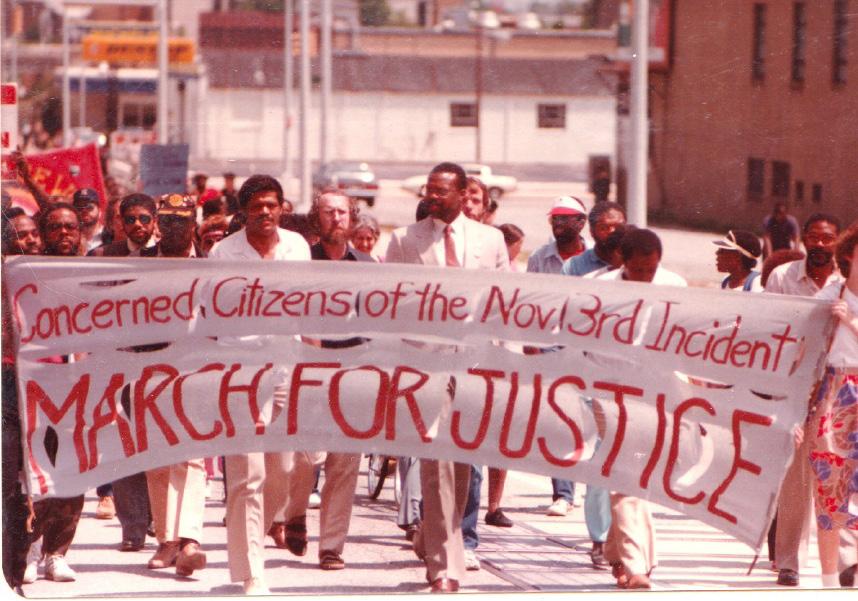
By HERB BOYD Special to the AmNews
Given the current reactionary political firmament, the activist community suffered a serious setback recently with the deaths of Rev. Nelson Napoleon Johnson, 81, in Greensboro, N.C., and Marika Sherwood, 86, in England. Johnson was a Black man and Sherwood a white woman, and although geographically separated by an ocean, they shared a stream of revolutionary commitment.
As a Jewish refugee from Budapest living in Australia and working as a young woman in New Guinea, Sherwood was introduced to the concept of racial discrimination. It wasn’t long before she was fully involved in the Aborigines’ struggle. She was further enlightened when she intervened in a fight between Black and white children. “I had to step in and separate them,” she recounted, “and I told myself the Black kids had to learn of their parents’ contributions …” She told the Black kids, “You have to fight with knowledge and not your fists.”
Sherwood took her own advice and began to delve deeper into Black history in England and throughout the diaspora. Her first book, “Many Struggles: West Indian Workers and Service
Personnel in Britain, 1939–1945,” was published in 1985. It was her “Malcolm X: Visits Abroad, 1964–65,” published in 2011, however, that gained her a permanent place in the hearts and minds of global freedom fighters.
The book is an indispensable addition to the Malcolm X canon, including almost day-by-day, eventby-event coverage of Malcolm’s presence in France, England, the Middle East, and Africa during his yearlong travel to those parts of the world. She, along with Hakim Adi, was the co-founder of Black and Asian Studies Association. Among her many entries in dictionaries and encyclopedias was one about Claudia Jones, the communist and journalist.
For all their commonalities, I doubt whether Sherwood and Johnson ever met, but knowing of Sherwood’s universal interest in the plight of Black people, there’s a good chance she was aware of Johnson’s fight for Black liberation. His leadership in Greensboro, particularly the march against the KKK in 1979 that led to a massacre, was widely reported. Four people were killed and several wounded when they were attacked by the KKK in protest against the klan and its promotion of white supremacy.
This wasn’t the first time Johnson
had been involved in a demonstration that led to someone being killed. A decade before, when he was still a high school student, he led a protest after one of his classmates won a senior race for class president but was denied the honor because of accusations that he was a radical. Violence ensued and one protester, Willie Grimes, was killed. Johnson was arrested.
Unlike the school uprising, Johnson was wounded in 1979, but continued working in various organizations to halt the spread of white supremacist ideology. Whether as a member of the Communist Workers Party, Workers Viewpoint Organization, Greensboro Association for Poor People, or African Liberation Support Committee, he was a bellwether for social justice. Even after the more radical phase of his fight for equal rights and independence was over, he continued to campaign for a Truth and Reconciliation Commission. Practically to the end of their lives, these two octogenarians refused to be stymied by the forces of reaction and adversity, and the legacies they leave, I hope, will inspire a multitude of marchers for freedom and justice to meet head-on the atrocities fomented by the Trump administration.
Let’s get focused on the

I know you might be distracted by the dumpster fire that is American politics right now. I know it might be difficult to hold several political events in your mental bandwidth at once. Many people I know are still processing November 5, January 20, and the hellscape that has been unleashed on millions of Americans since DJT 2.0 has returned to Washington, D.C., for their “Grift and Destruction Tour.” But here we are and we must chew gum while walking, as they say.
The framers of American democracy constantly debated about the true essence of democracy and many argued that it could best be found in local politics. The debate continues, and even as barely 60% of Americans bother to turn out for presidential elections, the numbers for local elections are even more bleak. In modern history, New Yorkers have had closer to 60% choose not to participate in municipal elections. Sometimes barely a quarter of the voting-eligible population bothered to turn out.
In the next few months, I will be writing a lot about the importance of voting in local elections. There are so many important political offices on your ballot; some ranked choice, some not. Election Day is June 24, and New Yorkers will have a chance to vote for mayor, comptroller, public advocate, city council members, borough presidents, and district attorneys, depending on where you live.
My podcast FAQ.NYC has already begun interviewing mayoral candidates. I am also a part of the NY Editorial Board, a
group of journalists who are interviewing mayoral candidates and releasing the transcripts and audios of them in the hot seat for an hour. TheCity.NYC has lots of resources for those interested in learning more about ranked choice voting and issues facing the city.
Several other outlets and podcasts are interviewing folks running for elected office. There are also several forums each week in various boroughs where you can see the candidates in person and hear their platforms and plans for affordable housing, policing and public safety, education and specialized high schools, sanctuary city status, and so much more.
A lot is being asked of us emotionally and intellectually, but we will only achieve the democracy we deserve if we stay engaged and participate in elections — especially crowded primaries. If you have questions about issues, candidates, or the process, I will be writing about it all quite a lot these next few months leading up to June 24. Until then, start doing your own research about the candidates in your district and those who are running citywide. We cannot afford to abstain from these important local elections.
Christina Greer, Ph.D., is an associate professor at Fordham University; author of the books “How to Build a Democracy: From Fannie Lou Hamer and Barbara Jordan to Stacey Abrams” and “Black Ethnics: Race, Immigration, and the Pursuit of the American Dream”; and cohost of the podcast FAQNYC.
By BERT WILKINSON Special to the AmNews
This is not the first time that influential Americans, and even regional influencers, have suggested that U.S. leaders and Congress should pay more attention to the Caribbean. Fears are increasing that any further lapses will create more space for emerging superpower China to win friends and influence governments in America’s backyard.
As leaders gather this week in Barbados for the first of their two main summits this year, a concerned group of American congressional representatives has asked the Trump administration to switch to regional leaders or China will eventually be the dominant player in the Caribbean. The group has written to new Secretary of State Marco Rubio urging Washington to send a highlevel delegation to engage Caribbean prime ministers and presidents formally during their three-day summit, which starts on Wednesday.
The letter comes amid growing concerns in the U.S. about the speed at which China is winning friends in the Caribbean, with its state and private sector corporations investing billions in various areas, from commercial offshore oil production to state contracts from several governments in the 15-nation bloc.
The congressional representatives
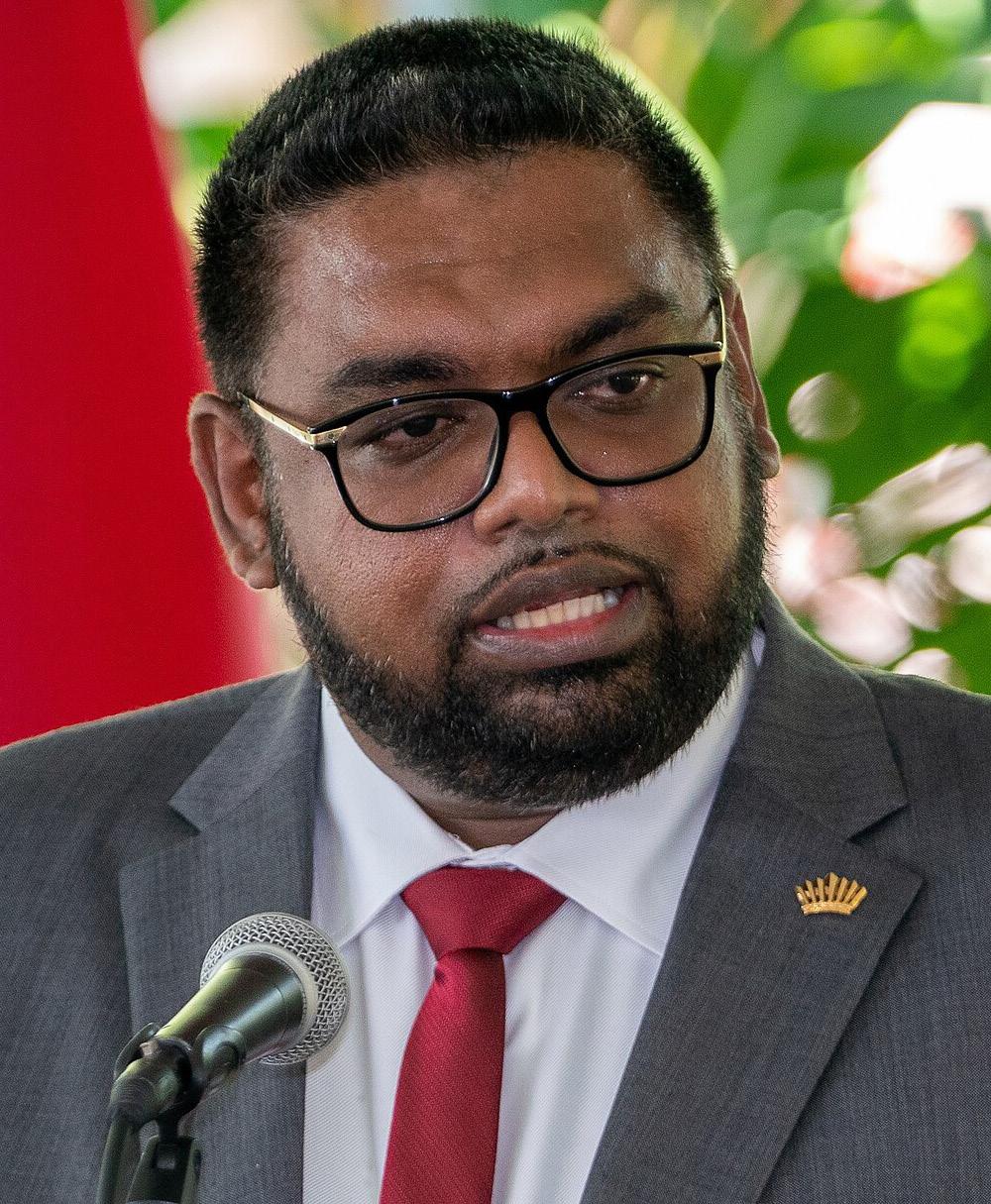
Guyanese President Irfaan Ali. (commons.wikimedia.org/wiki/ File:Irfaan_Ali_in_2020)
say time is running out for the U.S. as China moves in, and the way to beat back this is to engage the region formally and at a high-enough level.
“Continued U.S. support for eco-
nomic development, natural disaster resilience, and democratic governance is crucial to provide an alternative to China’s pernicious model in the Caricom area, during
a year with six national elections — including in two Taiwan-allied states — in the region,” the letter stated. “The meeting will provide the United States the opportunity to deepen its commitment to our mutually beneficial diplomatic, energy, economic, and security ties with partners in the Caribbean region.”
The missive to Rubio was initiated by members of Congress Joaquin Castro, a House Foreign Affairs Subcommittee on the Western Hemisphere; Gregory Meeks, a member of Foreign Affairs; Yvette Clark, cochair of the Congressional Caribbean Caucus; and Stacey Plaskett.
The concerned lawmakers appear to be reminding Washington that the Caribbean is right in the U.S. backyard — just off Florida — and should attract the type of attention it deserves because of trade, security, and other matters.
“The Caribbean is a key pillar of U.S. national security,” stated the letter. “As the third border of the United States, the Caribbean plays an indispensable role in addressing regional challenges, from countering illicit drug trafficking to curbing irregular migration and human smuggling. The Caribbean is essential to U.S. trade and energy security, serving as a crucial hub for shipping lanes and a strategic partner in diversifying energy sources.”
As the work week began and preparations heightened for the
summit, it is unclear who will lead an American delegation, if any. For its part, the U.S. has engaged the region at the highest levels over the decades, from President Reagan in the 1980s to Clinton in 1997 to Obama in 2009 and others. Former Secretary of State Antony Blinken also met leaders, as did Hillary Rodham Clinton and others, but the current fear of the Congress representatives appears to be linked specifically to China’s growing influence in the region while the U.S. is otherwise engaged.
“It is a region where the United States remains the number-one trading partner and welcomes millions of U.S. citizens annually, while a vibrant Caribbean diaspora here in the United States solidifies our economic and cultural bridges. Bolstering cooperation with, and the capacity of, our Caribbean partners through high-level engagement serves as a force multiplier for the litany of U.S. national security and economic priorities in the region. Sustained highlevel U.S. engagement is necessary to keep coercion at bay.”
Regional leaders like Guyanese President Irfaan Ali have suggested that China and its business owners are much more aggressive than Americans: They are snapping up most of the billion-dollar project opportunities in the region while governments struggle to get the attention of Washington and Congress.

KORNER
I recently asked AI to define the word “stupidity.” The response was strikingly accurate: “Stupidity is the lack of good judgment, intelligence, or common sense in a given situation. It can refer to foolish behavior, ignorance, or the inability to think critically about consequences. While everyone can make mistakes, repeated poor decisions or a refusal to learn from experience are often considered signs of stupidity.”
That definition perfectly encapsulates the mindset of many immigrant voters who support-
ed and voted for Donald Trumpeto and his sidekick Elon. Now, as their family members and friends face deportation under his administration or are running scared of ICE, the reality of their foolish action is hitting hard. Take Miami, Fla., for example. In November, Cuban and Venezuelan voters celebrated Trump’s victory in the streets, but just weeks into his administration, the cheers have turned to dismay as deportation fears grip their communities. This is especially true for Venezuelan immigrants, many of whom depended on Temporary Protected Status (TPS) to remain in the U.S.
Trump has already reversed the Biden administration’s TPS order for Venezuelans, meaning pro-
tections for more than 300,000 Venezuelans will end in early April. Another 250,000 Venezuelans with extensions through September also face uncertainty. The same Venezuelans who helped hand Trump a win in Miami-Dade County are now feeling “betrayed.”
As Adelys Ferro, director of the Venezuelan American Caucus, told the Miami Herald: “Beyond betrayed. They used us.”
To that, I say — no, you weren’t “used.” You were simply foolish. Trump has made his stance on immigrants clear since 2016. He told you exactly what he planned to do. You just assumed you and your loved ones were so special that you would be exempt.
Meanwhile, in Richmond Hill, N.Y., home to the Indo-Guyanese
community often called “Little Guyana,” a similar reckoning is unfolding. Last year, many in this community supported Trump, buying into fake promises of economic prosperity and a toughon-crime agenda. Now, less than a month into his term, they’re pleading for mercy as his immigration policies take effect.
Businesses in the area, once thriving, are suffering, and the once-bustling streets are now eerily quiet. Restaurants and bars are struggling without undocumented workers who once filled essential roles.
“We didn’t think it would happen to us,” one community member, requesting anonymity, told the Village Voice. “We’ve been here for 20, 30 years. We own homes, busi-
nesses; and send our kids to school here. We thought we were safe.” Dr. Martin Luther King Jr. once said, “Nothing in all the world is more dangerous than sincere ignorance and conscientious stupidity.”
Sadly, the consequences of this ignorance are now unfolding before our eyes. The rest of us — those who saw the danger from the start — are left to watch as these voters of color, who fell for Trump and his Musketeer sidekick, now scramble to escape the very policies they helped enable.
Felicia J. Persaud is the publisher of NewsAmericasNow.com, a daily news outlet focused on positive news about Black immigrant communities from the Caribbean and Latin America.
SAN JUAN, Puerto Rico
(AP) — Haiti’s children are increasingly caught in the crossfire of gang violence and forced to carry weapons, spy on police and rival gangs, and run errands for gunmen, according to a report released Wednesday by Amnesty International.
One of 51 children interviewed by the human rights group said he was constantly pressured by a gang to fight alongside it. “They killed people in front of me and asked me to burn their bodies, but I don’t have the heart for that,” the unidentified boy was quoted as saying.
An estimated 30% to 50% of gang members are now children, according to UNICEF.
Amnesty International said the children “had no choice, and their involvement was predominantly out of hunger or fear.”
Nearly 2 million people are on the verge of starvation in Haiti, and more than one million children are estimated to be living in gang-controlled areas, with 85% of the capital of Portau-Prince under their rule.
One unidentified boy, 16, said he’s paid to run errands for a gang. “(The gangs) are in control. And there is nothing you can do about it,” he was quoted as saying.
If children refuse to follow a gang’s orders, they or their families would be killed, according to the report, which relied on 112 interviews and research done from May to October last year.
Children are not only in danger of gangs, but of vigilantes and police officers who believe they are working for them, according to Amnesty International.
Girls and young women


also have been collectively raped by gang members and infected with sexually transmitted diseases, often ending up pregnant in a country where health care is extremely limited.
One teen was raped by six men, and her sister by five others. “There was so much blood,” the unidentified younger sister said in an interview.
Another teen said she drank bleach to try and kill herself after having a baby after being raped by three men who then left her naked in public. “People found me on the
street and put a dress on me,” she said.
Amnesty International said many of those interviewed “scoffed at the idea of reporting their attacks to authorities.”
A 16-year-old girl who was abducted and raped by several gang members said, “Are you kidding me? It’s not possible … There is no police … The only chief in town are the gang members.”
The violence also has led to injury and death.
One girl, 14, recounted how a ricocheting bullet pierced her lip in September 2024. Three
months before that, her 17-year-old brother died from a stray bullet.
“I lost a huge presence in my life. Since then, I don’t know how to be happy,” the girl said.
The violence is especially punishing on children with disabilities, with some saying they had to leave crutches and wheelchairs behind during sudden gang attacks in their neighborhoods.
Amnesty International called on the Haitian government to better support children, restore education, provide mental health services,
and resume court proceedings against children suspected of ties to gangs who are being held without charge.
It also said more resources, including training and security, are needed to help reintegrate children into society.
“The international community cannot continue to make empty promises,” the report said. “The country needs immediate and sustained technical and financial assistance to rescue a generation of boys and girls from being lost to repeated cycles of gang violence.”
In 2023, 128 children were reported killed, according to the U.N. While the figure wasn’t available for last year, more than 5,600 people were reported killed in 2024, the organization found. Haiti’s National Police, which is severely underfunded and understaffed, is working alongside a U.N.backed mission led by Kenyan police to help quell gang violence. However, the mission lacks funding and personnel, and the U.S. and other countries have been pushing to transform it into a U.N.peacekeeping mission.
By CHRISTIAN SPENCER
Special to the AmNews
It was on Presidents’ Day, during a national day of protest, that Edafe Okporo, a candidate for City Council in District 7, seized the moment to declare his commitment to countering the influence of President Donald Trump’s policies in New York City.
Under a gray winter sky, the crowd gathered at Union Square on E. 14th St., joining other demonstrations nationwide as they opposed a political narrative rooted in exclusion and division.
“I’m running for City Council because New York needs leaders who will do more than just talk about immigrant rights — we need leaders who will fight for them,” Okporo said. “This event is why I’m in this race: to make sure no one seeking safety is met with fear, no one struggling to survive is met with punishment, and no New Yorker is treated as disposable. District 7 — and all of New York — deserve real leadership that puts people first.”
The protest was fueled by growing discontent over the Trump administration, now being channeled through Elon Musk’s Department of Government Efficiency (DOGE).
Critics also took aim at Mayor Eric Adams’ allyship with Trump’s border czar, Tom Homan, which prompted four of his

deputies to sign a joint letter of resignation in correlation to the Department of Justice dropping his corruption charges.
“Adams is following the Trump playbook — spreading fear and punishing those who need protection. We need bold policies that do the opposite. That means fully funding legal services for asylum seekers, ending the 30/60-day shelter limits, expanding municipal IDs to ensure undocumented people can access city services, and halting ICE collaboration in all city agencies,” Okporo said.
Many believe there was a quid pro quo arrangement between Adams and the Trump administration, where influence over New York City was exchanged.
Organized by a coalition of advocacy groups – Moveon, Indivisible, Five Calls –proclaiming anti-fascism LGBTQ plus inclusion and support for immigrant rights and unified diversity, the opportunity to speak for Okporo was timely.
In the chilling winds, from Union Square to Flatiron down to Washington Square Park, the crowd shut down Broadway and Fifth Avenue , rallying peacefully for more than three hours.
Amidst the sea of sophomoric signs and chants, Okporo’s professional yet relatable presence noticeably got one the loudest reactions that day.

New York is source of beads for New Orleans artist Demond Melancon, who blends tradition with contemporary art to elevate Black Masking Culture globally.

By EDEN HARRIS Special to the AmNews
For Demond Melancon, a master bead artist and big chief of the Young Seminole Hunters in New Orleans, the art of beading is more than craft; it’s a sacred tradition and historical archive. And it connects him to New York City. While New Orleans is the heart of his inspiration, an unexpected lifeline has emerged from a place far from his home: New York’s historic Bead District. The vast selection of materials and the city’s art scene have helped Melancon elevate his work and expand the reach of Black Masking Culture into the contemporary art world.
According to a spokesperson, Melancon “goes on bead-buying trips to NYC, and this has helped advance his art form. [He] has a deep connection with Carl Schimel of CJS Sales, a bead wholesaler in New York, on Fifth Avenue. [He] has bought more than 500 pounds of beads from CJS Sales on his bead-buying trips to New York to use … in his artmaking.”
For New Yorkers planning a trip down South, Melancon work has been on display as of Feb. 7, 2025. It will be on view for a year at the Gibbes Museum in the historic city of Charleston, S.C., where Melancon received the 2024 Society1858 prize for Contemporary Southern Art. Visitors can observe “Hatshepsut,” which celebrates a former Egyptian woman ruler during the 1400s, at the museum.
The former Joan Mitchell fellowship recipient, is challenging long-standing gender dynamics in this exhibit and sparking a deeper conversation about the resistance to female leadership

across cultures.
“I’ve always told my tribe members that woman is God on Earth and men have problems with women in power. This is the reason to tell her story with my needle and thread,” Melancon told the AmNews. Melancon explained the role New York plays in his art in a Q&A with the Amsterdam News
AmNews: How has NYC’s art scene influenced your work compared to your roots in New Orleans?
Demond Melancon (DM): NYC’s art scene influenced my work because when I experienced it, I knew my work belonged there, too. I started traveling to NYC to see art shows about eight years ago, when I began my contemporary art practice. My wife and I had the honor of meeting Toyin
Ojih Odutola at one of her exhibitions at the Jack Shainman Gallery, and we’ve stayed in touch with her since. NYC really inspired me, and still [inspires] me, to take my art to another level — to bring my art to a broader audience through the contemporary art world, allowing my work to be recognized as contemporary art rather than being limited or reduced to other categories.
AmNews: Have you drawn inspiration from NYC’s diverse cultural landscape? If so, in what ways?
DM: The diversity and creative energy of NYC resonate with me — it’s a place where different cultures, histories, and narratives intersect, much like New Orleans. There’s a longstanding connection between NYC and New Orleans. Our greatest jazz musicians have been traveling to and play-
ing in NYC for over 100 years. The landscape of NYC also allows me to connect with a wider audience who may not be familiar with the Black Masking Culture, but can experience a connection to it through the language of my beadwork.
AmNews: Are there specific galleries, museums, or neighborhoods in NYC that have shaped your artistic vision?
DM: Harlem carries a deep legacy of Black artistry and culture, and I’ve always been inspired by its history, from the Harlem Renaissance to today’s artists pushing boundaries. I love what the Studio Museum in Harlem does and represents.
AmNews: What do you hope people take away from your work, particularly when it’s showcased
in major art hubs like NYC?
DM: I want people to understand that Black Masking Culture is an art form that deserves recognition in the global contemporary art world. My work is about resilience, survival, beauty, and love — it honors the struggles of our ancestors while celebrating our ability to create, innovate, and thrive. It reminds us of the pains of our past while showing us the promise of our future. I hope that when people see my work, they see more than beadwork; they see history, identity, and an unbroken lineage of Black artistry and excellence.
AmNews: Are there any upcoming projects or exhibitions you’re excited about?
DM: I’m currently working on my most ambitious Black Masking Suit yet, inspired by the Amistad rebellion. It will debut in 2026. It will be the culmination of over three years of work and nearly 8,000 hours of sewing. My Ashanti Mask series and Spirit Suit, Mother Yemaya, are included in my first solo museum exhibition, “As Any Means Are Necessary,” which will be opening at the African American Museum in Philadelphia in March 2025. I’m excited about ongoing conversations with institutions and having my work placed in their permanent collections.
AmNews: How do you see your work connecting African artistic traditions with contemporary storytelling?
DM: My work is a direct continuation of African artistic traditions. For example, my new Ashanti Mask series is inspired by the masks of the Akan tribe in modern-day Ghana. These masks were revered for their transformative power to create a conduit for dialogue between the spiritual realm and the physical realm. I seek to honor their power by bringing life to them through my beadwork so they live forever.
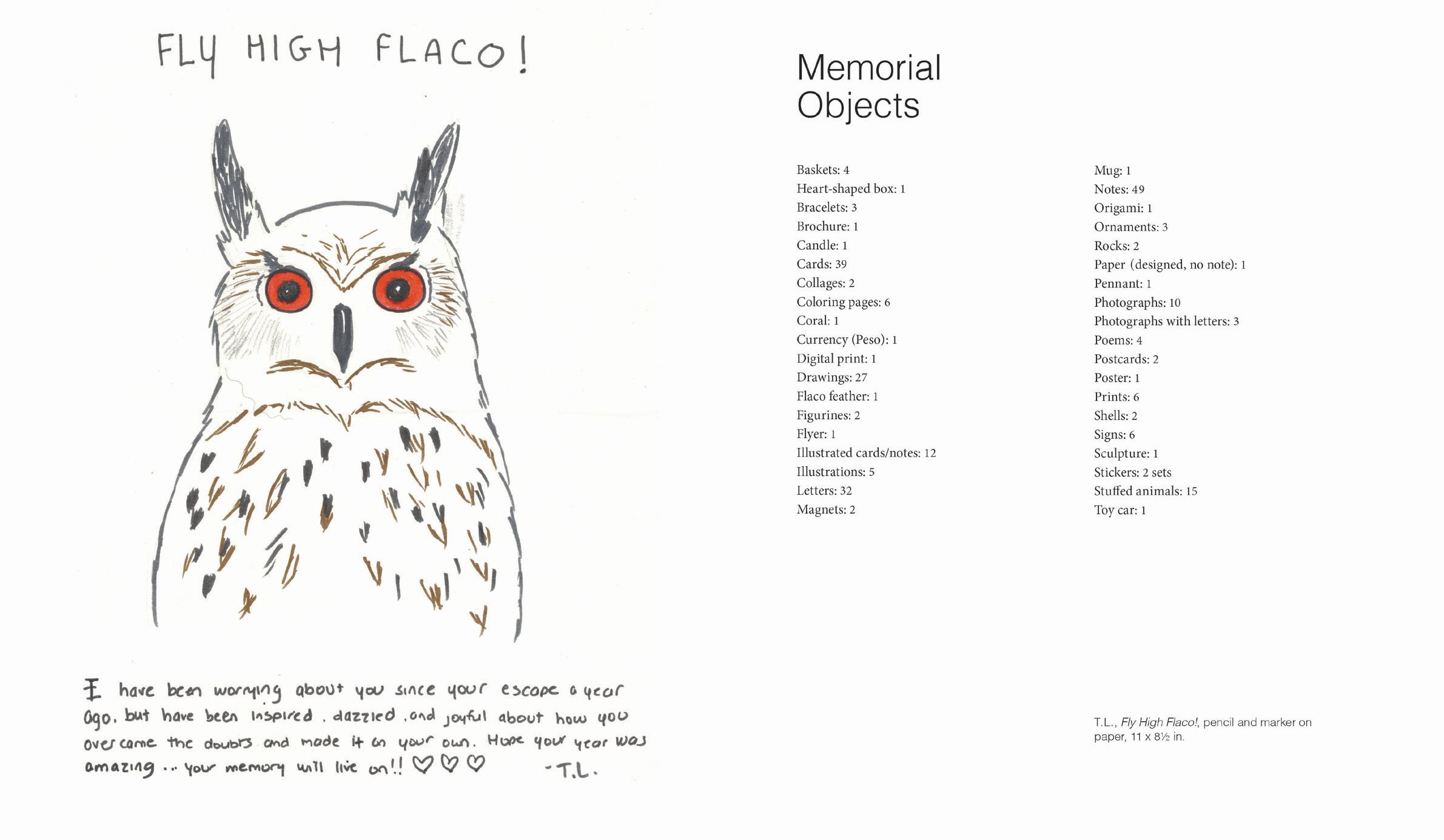
By TANDY LAU
Amsterdam News Staff, Report for America Corps Member
Super Bowl weekend was a “superb owl” weekend at the New York Historical for the opening of “The Year of the Flaco.” Roughly a year since the famous bird’s passing and two years since his escape from the Central Park Zoo, the exhibit and several books, including Jonathan Hollingsworth’s “FLACO: The Owl Who Escaped Captivity and Won the Hearts of the World,” recount the New York City phenomenon.
Flaco, a Eurasian eagle-owl, arrived in the Big Apple almost immediately after hatching in North Carolina on March 15, 2010. He remained in a zoo enclosure until Feb. 2, 2023, when an unknown individual released him. Flaco spread his wings to fly freely for the first time of his life.
After eluding several recapture attempts, the owl spent the next year learning to soar and hunt around Manhattan before his sudden death from flying into an Upper West Side building on Feb. 23, 2024. Postmortem testing revealed underlying conditions from eating wild pigeons and exposure to rodenticide, which probably would have killed him independent of the collision.
“Freedom is the source component of [Flaco’s] story,” said Hollingsworth. “He was released, he got out, [and] he wasn’t captured … The other component is untaming
himself and learning how to be a wild owl because up to that point, he didn’t know how to. The element of living according to your own nature and your own instinct for individuals is really powerful because most people are going through their lives and having a private dialogue with themselves of ‘what is it that I have to do to survive and what is the kind of life that I want to be living.’
“Flaco went from the two extremes of living for other people to living for himself and doing exactly what he wanted and experiencing the world on his own terms for the first time.”
After following the story in the news and over social media, Hollingsworth embedded himself with a small group who dubbed themselves the “Friends of Flaco” while documenting objects left at the owl’s memorial under a favored oak tree by 104th Street. Hollingworth was always drawn to personal effects, previously publishing books with photos of belongings from those who died crossing the United StatesMexico border from the Sonoran Desert. “Oftentimes, those objects were all that was left to identify this individual,” he said. People have dropped off everything from artwork to a note written on a Cuban peso. They penned 32 letters thanking the bird for helping them get through various personal trials, like a law school application and a breakup. Under a pencil-and-mark-
er drawing of the owl with the words “Fly High Flaco!,” one mourner simply known as “T.L.” expressed anxiety-turned-gratitude: “I have been worrying about you since your escape a year ago. But have been inspired, dazzled, and joyful about how you overcame the doubts and made it on your own. Hope your year was amazing … your memory will live on!!”
The memorial reached 257 items. Friends of Flaco also came into contact with Rebecca Klassen, New York Historical’s curator of material culture, who began visiting the memorial collection late last May and received a green light for the exhibit in June.
“Exhibitions often come together with the help of community members, but given the short lead time for this one, the knowledge and connections provided by this small group were essential,” said Klassen by email. “They had also already done a fair amount of legwork, whether it was generating photo documentation of all of the memorial objects or conducting research on Flaco and other Eurasian eagle owls.”
Many of the objects delineated in Hollingsworth’s book are on display. While excerpts address conservation efforts, including relevant concerns about the H5 bird flu, the heart of the exhibit grapples with the impression an owl native to Europe, Asia, and North Africa left on a city in transition.
“People were able to look up and find him
in the park and see something of tremendous beauty [and mystery],” said Hollingsworth. “He was here in the city, he stayed here and he was accessible, and he returned to the same spots again and again, so people were able to build relationships with him and he was something kind of magical, and who doesn’t need that in it in a rather bleak time?”
“Through Flaco and this exhibition, I’ve become a superfan of owls and birds in general,” added Klassen. “They are all special, and we are lucky to live among them. This may sound strange, but Flaco is like a gateway to collectively envisioning a future in which we can all find resourcefulness, courage, and the realization of our fullest potential. That, in a sense, is the spirit of New York.”
“Year of Flaco” runs through July 6 at the New York Historical.
“FLACO: The Owl Who Escaped Captivity and Won the Hearts of the World” was released on Monday, Feb. 11 and can be purchased at the museum’s gift shop. For more info, visit nyhistory.org.
Tandy Lau is a Report for America corps member who writes about public safety for the Amsterdam News. Your donation to match our RFA grant helps keep him writing stories like this one; please consider making a tax-deductible gift of any amount today by visiting https://bit.ly/amnews1.

By DERREL JOHNSON Special to the AmNews
The Schomburg Center for Research in Black Culture (135th and Lenox Avenue) recently announced a year-long centennial celebration at a press conference in the national landmark. Congressmember Adriano Espaillat, City Councilmember Dr. Yusef Salaam, New York Public Library (NYPL) President Tony Marx, and Schomburg Center Director Joy Bivins joined Aysha Schomburg, NYPL trustee and the great-granddaughter of the center’s founder, Puerto Rican-born scholar Arturo Schomburg, at the event. They made remarks after a procession of three Afro Cuban percussionists led by the Last Poets member Baba Don Babatunde.
Salaam opened the event with a quote from Schomburg: “The Negro has been throughout the centuries of controversy an active

collaborator, and often a pioneer in the struggle for his own freedom and advancement.”
Espaillat evoked the names of
the two men who previously represented Harlem in the seat he currently occupies: Adam Clayton Powell Jr., who was in office
from January 3, 1945, to January 3, 1971, and Charlie Rangel, who was in office from January 3, 1971 to January 3, 2017.
“The Schomburg Center is a beacon for what we stand for and what we aspire to: preserving, serving, exhibiting, and creating Black history, which is at the very core of the history of this nation, so I’m going to go off script,” said Marx. “We live in a moment when the history of the essential peoples of America, including, so essentially, the African American people, is being denied. Black History Month is being pushed aside. When our commitments to diversity and equity and inclusion are being threatened, let me be as clear as I possibly can: The history of African American people is a history of America. America is not understandable without that history. We will celebrate. We will bring forward that history to remind everyone what the realities of the history of this country are. We cannot accept the notion of pushing that aside and we will not.”
The Schomburg Center initially opened as the Division of Negro Literature, History, and Prints, and houses more than 11 million items and will turn 100 on May 8, 2025. For more information, visit www. nypl.org/locations/schomburg.







By EDEN HARRIS Special to the AmNews
The Africa Center, New York, has named a high-profile new CEO who intends to also focus efforts on “connection” beyond its established artistic programming.
Martin Kimani, Kenya’s former permanent representative to the United Nations, said that connection is needed now more than ever, and he wants to help provide a sense of security for New Yorkers amid political discourse.
“To have a center that is able to build inclusive conversations, and out of those inclusive conversations spark initiatives that are to increase the autonomy, the dignity and the prosperity of Africans and people of African descent is probably more necessary now,” Kimani said. “It’s always been for some time. It’s always been necessary, but right now, it’s more urgent. There are so many wars, there’s so much conflict, there’s so much political division.”
The political division in America between Republicans and Democrats can’t be ignored, with President Donald Trump closing down federal agencies like the United States Agency for International Development (USAID). That agency provided critical funding and development assistance to countries in Africa. It also assisted Ukraine, among other countries. The news of the agency being shut down sent shockwaves throughout the world, prompting Democrats to write a letter to the acting administrator, Jason Gray, to express their disapproval.
In spite of that move, Kimani also said the purpose of the center is to serve as a sanctuary and safe haven for Africans and those of African heritage, fostering collaboration to pursue personal aspirations and community betterment.
Despite the current political climate in the United States and abroad, Kimani said building effective global partnerships starts with strengthening internal bonds with African communities and their diaspora.
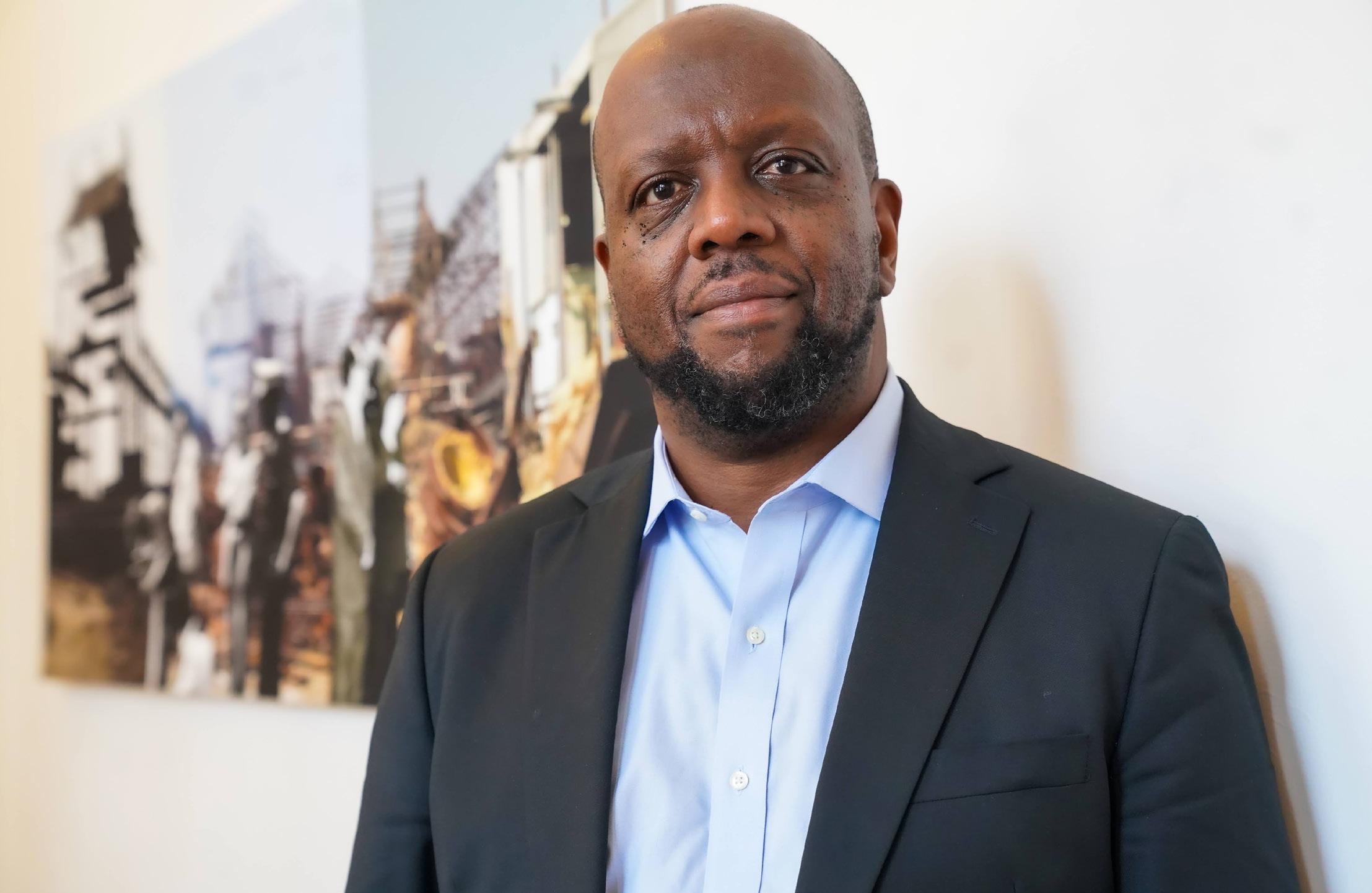
According to Kimani, this historical pattern of unity and resistance can be seen in different eras. “If you look at the Marcus Garvey of the late 19th century and the beginnings of Pan-Africanist thought, there’s a conceptual, philosophical, and I think, deeply emotional and psychological drive to unite these attempts to seek greater freedom and greater autonomy.”
Asked if he will involve African ambassadors, creators, and the global community to help fulfill the center’s mission of greater connection, Kimani said, “My ability to reach out and involve the UN African permanent representatives and heads of mission is definitely going to be one of the things that I bring to the Africa Center.”
Kimani plans to further his plans by engaging community, as well: “From the church leadership, whether it’s the 125th Street Mosque, whether it’s the Abyssinian and other religious institutions, to city council members, to elders in the community, I’m looking to have conversations and to really listen.”
“I think the first and most important connection is between Africa and its diaspora, African countries, African communities, African changemakers with the diaspora,” he said. “African people have been at their very strongest in terms of asserting their autonomy and their freedom.”
Attracting more visitors to the center, particularly locals, is a key connection point and priority for Kimani amid the growing political divide.
“We need to sharply raise the number of visitors we have here, especially from New York City, but of course, New York has people from all over. To do that, we need to have a lot more programming, and programming that is very attractive and pulls people in. To have that programming, we need more financial resources ... and that’s why I was hired.”
Kimani noted that “beyond financial support, increasing visitor engagement is also crucial for our growth. The other metric is we need the traffic into the building to increase. We’re on the top of the Museum Mile; just a few hundred yards away are the huge museums with their multi-billion-dollar budgets, and they get millions of visitors.”
On Feb 5, the Africa Center started hosting a community offering that runs through Apr. 27, 2025, called “In Between Nostalgia & Dreams,” an exhibit by Ethiopian-American photographer Yusuf Ahmed, who explores the interplay between memory, heritage, and identity.
Kimani draws support from local leader
One New York arts and culture leader weighed in on Kimani’s new role at the Africa Center.
“I think it’s amazing and wonderful that another African brother has come to bring their gifts, talents, intelligence, and vision to a center like the [Africa] Center in New York City,” said Bobby Digi, CEO of the Canvas Institute, a New York nonprofit committed to the arts and culture and civic engagement.
“I am praying for his success in following Pan-Africanism like Marcus Garvey and [Ghana’s former president] Kwame Nkrumah’s philosophy. I’m definitely looking forward to providing him support in whatever ways he needs, because the success of the [Africa] Center is a success of each of our Black- and Brown-led and -owned institutions.”
This appointment marks the second New York residency for the former senior diplomat, who has expressed not only his desire for driving connection but his admiration for the city.
“I love New York. It’s always been my favorite place to be,” Kimani said.
By EILEEN BARETT Special to AmNewsFOOD
I got a head start on my 2025 New Year’s resolutions: A few months before the new year began, my sister and I were joking about how we were going to “age backward.” That playful conversation inspired us to make some lifestyle changes: We revamped our diets, added hot yoga to our fitness routine, adopted a new skincare regimen, and even started making juice shots to fight inflammation.
Not long after, I had the opportunity to interview Dr. Ian Smith, a New York Times bestselling author, about his newly released book, “Eat Your Age: Feel Younger, Be Happier, Live Longer.” It felt like serendipity — I’m all about aging gracefully!
I received an advance copy of the book and read it carefully as I prepared to interview Smith. It feels like a comprehensive guide to living your best life, filled with case studies, meal plans, and medical advice. As Smith describes, the book is designed to help readers defy the effects of aging and enhance their quality of life.
When I was first assigned the interview, I have to admit I was nervous. Smith is a renowned physician and was a longtime contributor to the “Rachael Ray Show.” However, my nervousness quickly turned to excitement as I dived into the book. The health and wellness market is already crowded, so I was curious about why Smith chose this particular approach. Why structure the book as a guide to wellness through different decades of life, starting in your 30s? I also absolutely needed to know more about the 15 key ingredients in his recipe for “Glorious Aging.”
As a chef and nutrition educator, I’m all about a great recipe and strongly believe in food as medicine. Yes, food is delicious, indulgent, and fun, but at its core, it’s fuel — and it has the power to heal.
Smith believes that too many people approach aging with the wrong mindset, associating it with fear and decline. Instead, he advocates for viewing aging as an opportunity, saying, “You can harness the positive energy of aging and have a really productive life well into your 80s and 90s.”

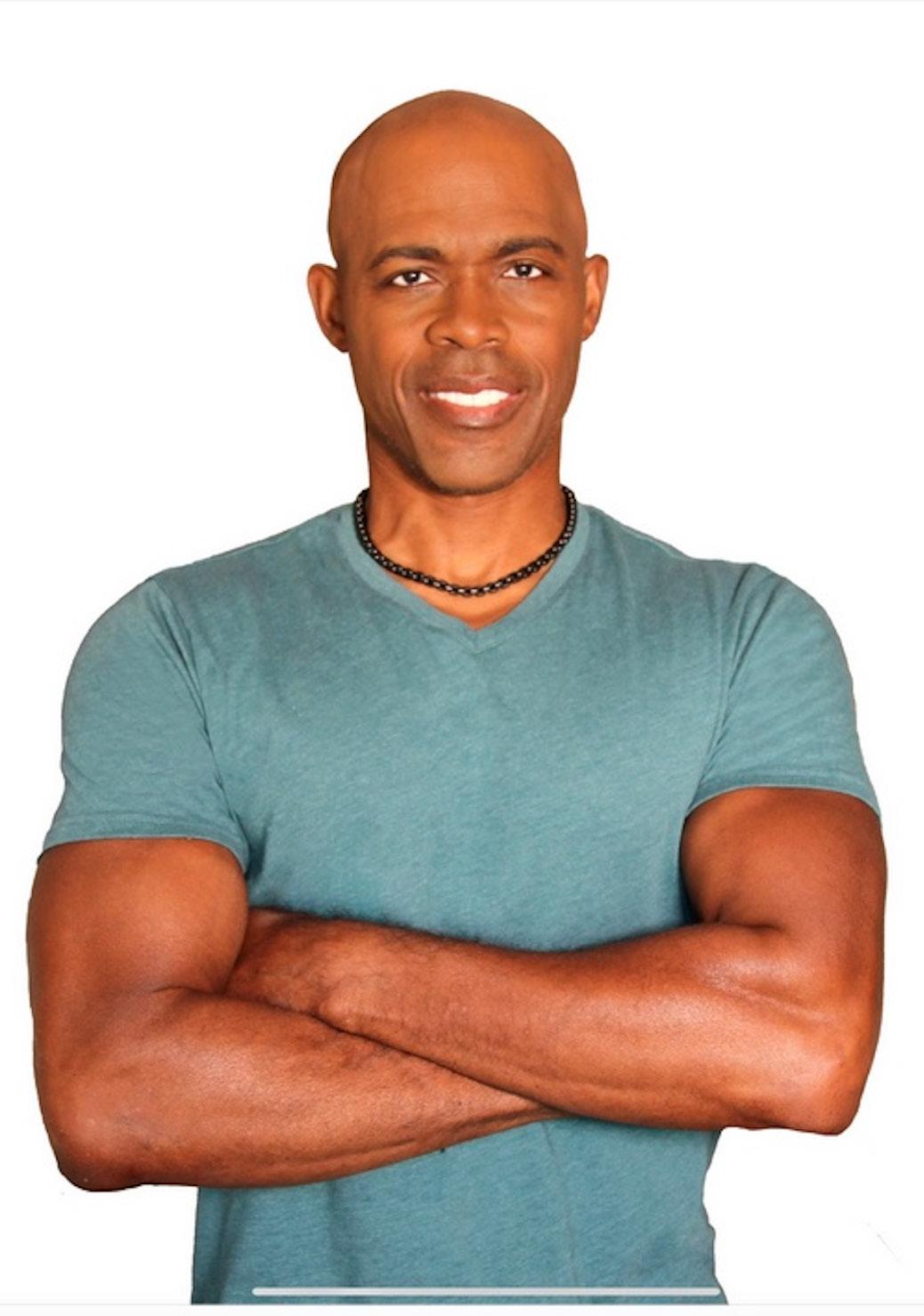
be more strategic about how we eat.
“There are ways to eat healthy food that are affordable and delicious,” he explained. “Yes, fried foods are flavorful because there’s flavor in fat, but we need to open our minds and palates to try foods we haven’t embraced before.”
If you’re looking for a way to start the New Year on the right foot, “Eat Your Age” by Dr. Ian Smith deserves to be a part of your plan. The book breaks down each decade of life, offering a road map for living well, from the nutrients you need and potential hidden health concerns to the most effective exercises for your stage of life. It’s an approachable, non-intimidating guide to achieving wellness and embracing glorious aging.
I’ve already shared this book with my sister and parents, and it’s been a game changer. Dr. Ian also released a companion recipe book, “Eat Your Age,” based on the TASH method: Tasty, Affordable, Simple, and Healthy.
Smith explains that eating your age is the “sense that you are eating foods that are most beneficial for your decade of life.”
He says that while this won’t reduce your chronological age, it can lower your biological age — essentially allowing you to age backward. Apparently, my sister and I were onto something! By making small, mean-
This philosophy ties directly to his recipe for “Glorious Aging.” According to Smith, wellness is multifaceted — it’s not just about diet and exercise. It also encompasses a positive mindset, the people you surround yourself with, and having a sense of purpose. Studies show that these elements contribute to longer, happier lives. Naturally, some components of his recipe reflect classic medical advice: Stay hydrated; reduce salt and stress; and increase your intake of water, vegetables, vitamin C, and antioxidants. What’s remarkable is that this recipe applies throughout all decades of life, and it’s never too late to start incorporating these habits.
ingful changes as suggested in the book, you can help your body feel younger and improve your quality of life. I could barely contain my excitement — Yes! Absolutely yes!
The book offers something for everyone, but I wanted to know if Smith had a specific message for the Black and Brown communities in Harlem. He began by expressing his deep affection for the neighborhood, which he once called home and still visits frequently. His advice was clear: We need to
Smith’s new book is available and his virtual boot camp, which began earlier this January, is free. To join, email eatyourage@ gmail.com.
Here’s to good health and glorious aging in the new year!
Eileen Barett is a private chef, culinary teacher, and owner of Aromas Boutique Bakery in Harlem. She writes about health, nutrition, and how to eat with intention.
Questions, comments, requests, feedback, invitations! Email us at AmNewsFOOD@ SCHOPnyc.com. Follow us on Instagram and Facebook @NYAmNewsFOOD.

By JULIAN MICHAEL CALDWELL Special to the AmNews
Journalist Lee Hawkins details the eyeopening discoveries revealed during his search to fill in the gaps of his family history in the new memoir “I Am Nobody’s Slave,” which was released on Jan. 14 through HarperCollins Publishers. Hawkins recently spoke at the Museum of the City of New York during an event titled “Roots and Rise” that also included panel discussions on African burial grounds, film screenings, and performances.
In the book, Hawkins, a 2022 Pulitzer Prize finalist and former reporter with the the Wall Street Journal dives into the impact of tracing his ancestry back to an ancestor who was enslaved, learning more about his parents’ upbringing, and meeting white cousins he never knew he had. He also learned that since 1837, a member of his family had been murdered in every generation before him.
Hawkins’ efforts to learn more about his lineage began in 1991 in Alabama, when he and his father interviewed the author’s uncle, then in his 90s. That uncle talked about his grandmother, but failed to mention that she was enslaved for the first 30 years of her life. In 2014, Hawkins, yearning to find out more about her and connect with other relatives, took a DNA test.
“I am hoping to encourage more Black Americans to do that because for a long time, we were put under the impression that somehow our family lineage is forever lost if we have any kind of enslavement in our past, and that’s not true at all,” Hawkins explained in a conversation with the AmNews
The test revealed 80% African ancestry, while the other 20% traced back to white family members in Virginia and Alabama. Hawkins then connected with white cousins for the first time, who were also deeply interested in learning their family history.
“Of course it surprised me, but also what surprised me was how warm, kind, and loving they were,” Hawkins reflected. “We all know the political context of what was happening at that time [of enslavement in the U.S.], but my goal at that time was not to pass judgment on anybody; it was more to identify as much information as I could.”
Hawkins grew up in Minnesota in the 1970s and ’80s, in a place and time where there weren’t many other Black people around. In “I Am Nobody’s Slave,” he recalls getting screamed at by his mother and beaten by his father at 5 years old for going to a birthday party that one of his white classmates invited him to, without his parents or the parents who owned the house
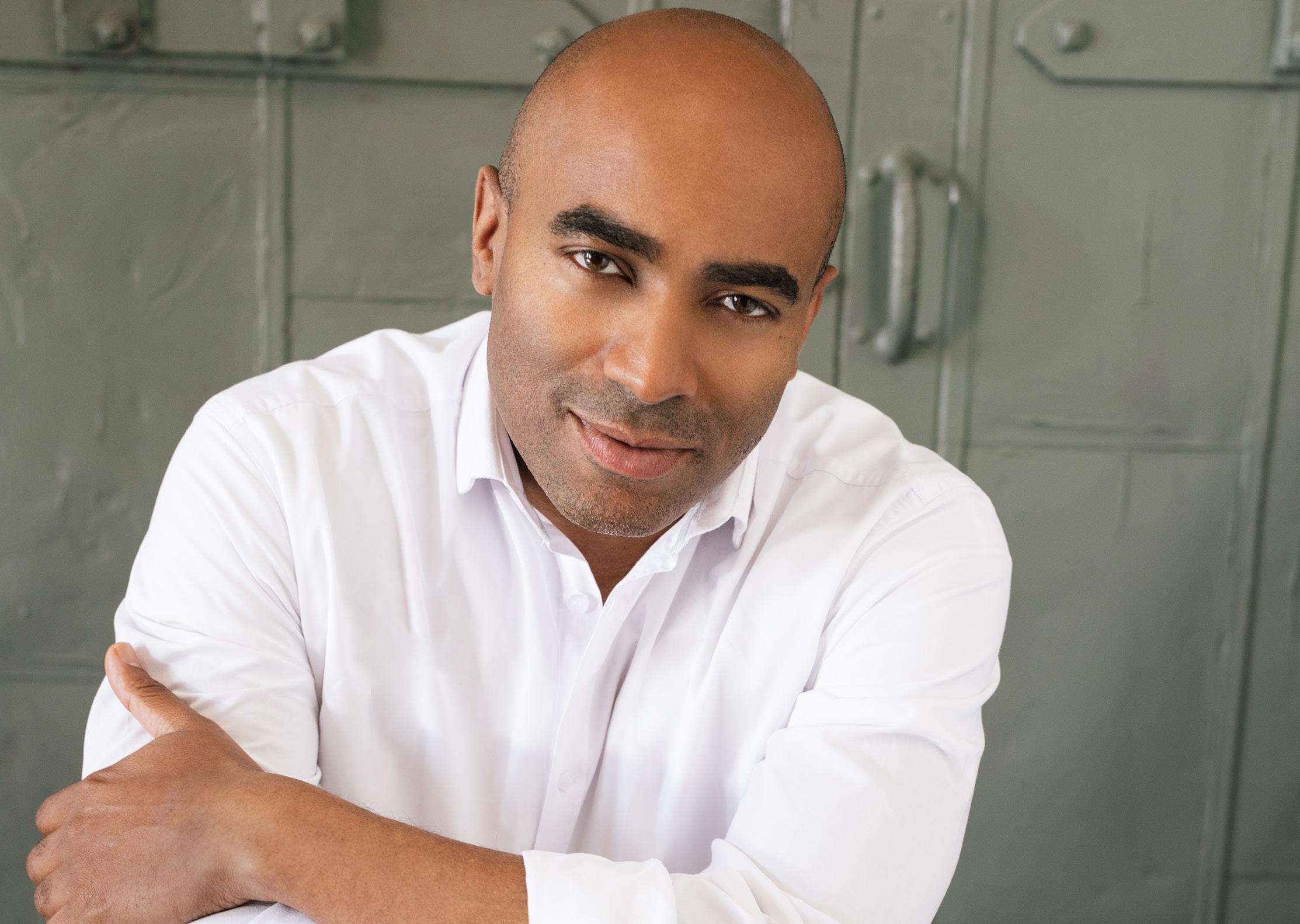
knowing beforehand. The experience led Hawkins to write in the book, “I longed for a mom who wanted me to go to a birthday party and have a joy-filled time.”
“What my parents were trying to do was teach me all the multitudinous number of rules that Black boys have to follow, as quickly as possible,” Hawkins said further in an interview. “That statement was me
mourning that childhood that I knew was never going to happen. I had to become an adult pretty quickly, and by the time I was eight years old, I really was expected to operate as an adult would operate.”
Hawkins writes at length about the belt as a familiar means of corporal punishment and a symbol of trauma passed on in Black families through generations, highlighting its semblance to how enslavers administered punishment to enslaved Black Americans. As an adult, Hawkins began having nightmares about the beatings he received as a child, similar to nightmares Hawkins learned his father had of his upbringing in Jim Crow Alabama.
“It would be unfair for me to singularly characterize my parents as these cruel, abusive people, when a lot of things that they did were things that were done to Black people for centuries, and internalized by our families over time,” Hawkins said. “Some Black families, including my
parents themselves, believe that Black children could endure more pain, or that the pain that we endure is a necessity and it’s better than being killed. That was really hard for me to process, because I know that my parents loved me, and I know that most of the Black parents who falsely believe they need to do this to protect their children love their children.”
That created a complicated relationship, particularly between Hawkins and his father, who doled out most of the physical punishment. Hawkins now calls his father his “best friend” and recalls his father’s apology to him and his sister 21 years ago as a pivotal moment in their relationship.
“It meant everything to me and my little sister,” Hawkins said. “When an elder does something as radical or revolutionary as to listen, and to humble themselves to say, ‘I was wrong. I mistreated you,’ that means the world. And I think that my sister and I didn’t need more than that, and our father gave us that, and it was beautiful.”
In the memoir, Hawkins introduces terms he created himself, like the “Original Baby Daddy” theory he uses to describe enslavers like the one who impregnated his greatgreat-grandmother centuries ago, who “had multiple children with Black women who they sexually assaulted, who they weren’t taking responsibility for.”
As Hawkins explained, “It was something that occurred to me when I was looking through the will of my great-great-grandmother, and I was thinking, I wonder how many of these kids are his [her enslaver’s] kids. I think I’ve tried my best in writing this book to be critical of myself and look at the ways white supremacy has been internalized in my own mind.”
When speaking to readers and audience members at events like “Roots and Rise,” Hawkins often meets people dealing with similar familial struggles, but usually much earlier in their journey to find answers. He encourages Black families to use genealogy as a means of bringing family together, healing trauma, and celebrating the accomplishments of their ancestors.
“I think most of the feedback that I’ve gotten that makes me feel the warmest inside are the people who say, ‘Thank you for deciphering this for me and inspiring me to have these conversations in my family and to research my family,’” Hawkins said. “I would say that’s the most gratifying part I’ve found on the book tour — I’ve been able to meet so many people and listen to their stories about themselves and give them advice on how to push through.”
“I Am Nobody’s Slave” is available via Barnes & Noble online and in-store, as well as other online retailers.
By MAGRIRA Special to the AmNews
As the 2025 Oscar Academy Awards® season approaches, “Sing Sing” is emerging as a major contender, earning an impressive 97% Rotten Tomatoes score from both critics and audiences. The film recently earned three Oscar® nominations — for Best Original Song, Best Adapted Screenplay, and Best Actor for Colman Domingo, further solidifying his status as one of Hollywood’s most compelling performers.
Stepping into the momentum of the 2025 award season, Domingo was recently honored with the Montecito Award at the 40th Annual Santa Barbara International Film Festival (SBIFF), which was held at the historic Arlington Theatre. The award recognizes artists whose careers have left an indelible mark on cinema.
The evening was a tribute to Domingo’s artistry, career-defining roles, and dedication to meaningful storytelling. Oprah Winfrey presented the award, praising Domingo’s ability to bring depth and humanity to every character he portrays.
Domingo’s career is built on perseverance and mastery. Reflecting on his journey, Domingo spoke candidly about the resilience that has defined it. “I just kept going and believed that the love I was seeking would also be seeking me. I just always believed that,” he said. His determination has led him to amass an extraordinary list of achievements, including multiple Academy Award nominations, a BAFTA® nomination, a Tony® nomination, Critics Choice® nominations, Independent Spirit Award® nominations, and multiple prestigious wins at the Emmys®, NAACP Image Awards®, and AAFCA® Awards. With a career spanning theater, television, and film, Domingo has cemented his place as one of the most versatile and powerful performers of his generation.
SBIFF Executive Director Roger Durling described Domingo as “one of the most extraordinary talents in the small screen, in theater, and in film, and he makes it all seem effortless. His work in ‘Sing Sing’ is unforgettable.”
His presence in film and television is a testament to his ability to transform into characters who challenge, inspire, and reveal com-
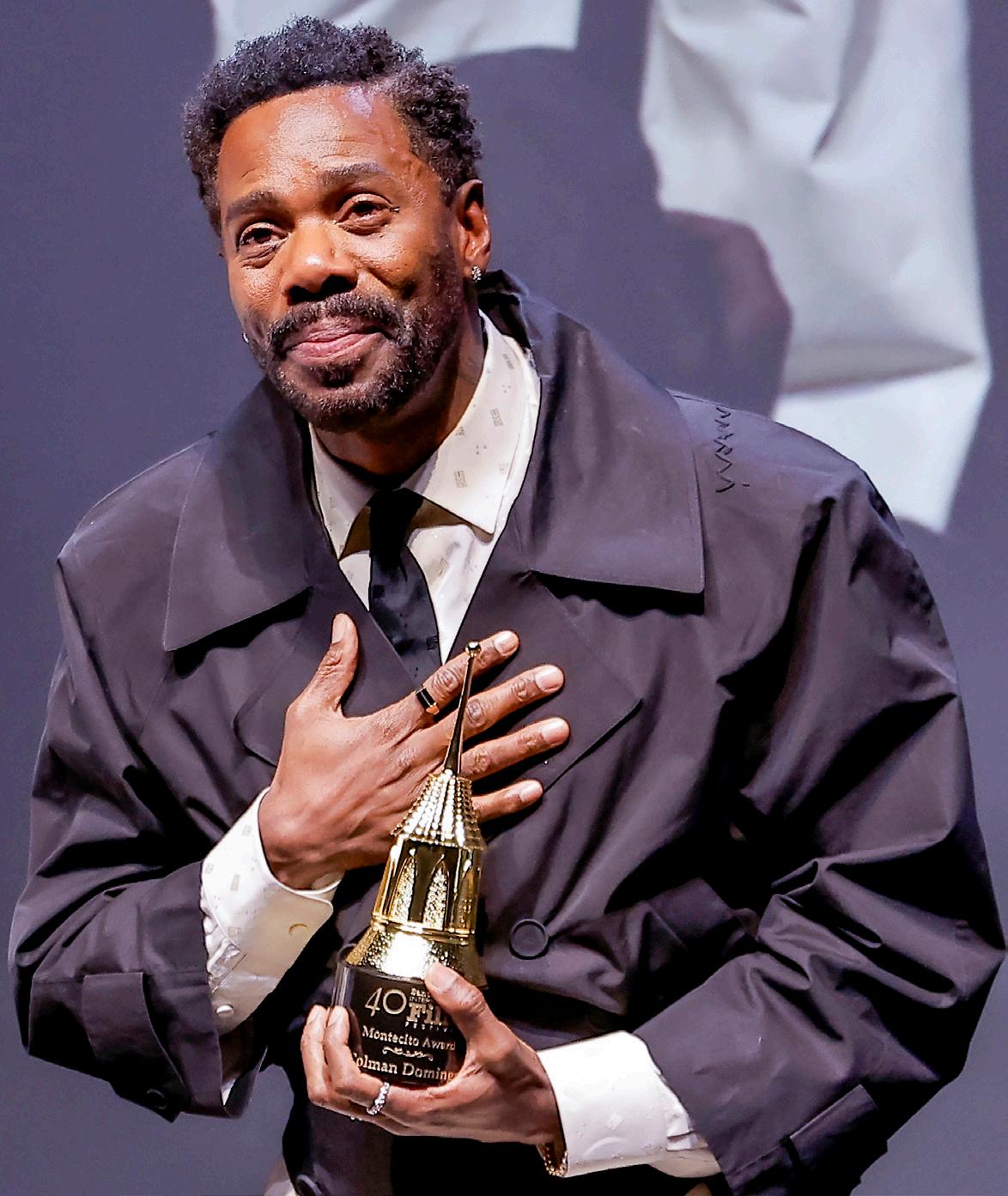
plex human truths. In “Selma,” he immersed himself in the history of the Civil Rights Movement. “The most beautiful thing about that film [is] when you get to have an audience with these civil rights leaders. We were able to meet with a lot of people who did this work. You get to know them; how they were outside of the history book.”
In “If Beale Street Could Talk,” Domingo worked with director Barry Jenkins to craft a character deeply embedded in family strength. “Barry and I talked about how Joseph Rivers is such a feminist and lives in a house full of strong women. He loves that he is in this hustle with strong women in the 1970s, and it doesn’t make him less of a man at all.”
Domingo’s television work has been equally lauded, including his Emmy®-winning portrayal of Ali in Euphoria. “Ali is the moral compass of Rue. But he has a complicated history. I like the idea that he is not there to judge her. He is just there to present her with options and opportunities.”
In “Fear the Walking Dead,” he brought depth to Victor Strand, a character whose motivations were constantly in question. “Victor had
Oscar® nominee Colman Domingo at Montecito Award®
(Photo courtesy of SBIFF)

a complicated moral compass. It is a show about survival. I loved that there were questions about him, and I wanted to lean into these questions.”
Domingo pushes the boundaries in his work. In the film “Rustin,” he took on the challenge of portraying civil rights icon Bayard Rustin, a role that required immense historical and emotional depth. “It felt like we were in alignment — that Rustin’s journey and my journey were meeting at the exact moment, and I was the actor to help pull this Black, queer, civil rights revolutionary out of the shadows of history, while I was being pulled into new history.”
His portrayal of Mister in “The Color Purple” challenged expectations. “It’s easy to think of Mister as a villain and as an abuser,” Domingo reflected, “but what is complicated is finding the heart of an abuser — why hurt people hurt other people.”
In “Zola,” Domingo embodied the volatile and manipulative X, balancing charm and menace. “He was using language to control a room, so for me, it was all elements of control. I played the character with a lot of charm and finesse, and it could turn on a dime.”
Domingo’s performance in A24’s
Kanye West and Bianca Censori are denying they are heading for divorce. Talent Management firm Tarantula told the Hollywood Reporter that the rapper/clothing designer and architect are still going strong. Tarantula told the outlet on Feb. 13, “Ye and Bianca are in Los Angeles, about to enjoy Valentine’s Day together. Announcements about their private life will come from them directly, not unsourced rumors in the tabloid press. Is this the fifth or is it the sixth time the press has wrongly reported that Ye and Bianca are separating? I’ve lost track.” On Feb. 2, on the Grammys’ red carpet, Censori dropped her full-length mink coat and revealed a sheer nude dress that left nothing to the imagination. Then, the couple left before the awards began. Kanye was a nominee. They later showed up at a Grammy after-party where Censori wore a see-through leotard.
Edwin Lee Gibson, who portrays the role of Ebraheim, the mysterious cook in “The Bear,” has been announced as one of the presenters at the 2025 Writers Guilds Awards in Los Angeles at the Beverly Hilton. In its third season, “The Bear” continues to be a fan favorite on Hulu as Gibson’s character now runs the Italian Beef window, serving sandwiches while concealing deep emotions rooted in his hidden past......
The Wayans family — Keenen Ivory Wayans, Damon Wayans,
powerful, thrice Oscar-nominated “Sing-Sing” has been widely celebrated. He portrayed Divine G, a character whose story is one of quiet resilience and humanity. “It’s a quiet act of revolution. I have such loving relationships with the men in my life. We are holding each other and touching each other, and I want more of that.”
His commitment to meaningful storytelling was evident as he spoke about the impact of the film. “It’s about putting myself on the line in
Sr., Marlon Wayans, Shawn Wayans, Kim Wayans, and Damon Wayans, Jr. — who, through film, TV, sketch, and stand-up comedy, have both entertained and created countless jobs both on and off camera in the entertainment industry, will be inducted into this year’s NAACP Image Awards Hall of Fame on Feb. 22 at the 56th NAACP Image Awards, which will air live on BET and CBS from the Pasadena Civic Auditorium in Pasadena, California. Past NAACP Hall of Fame inductees include Oprah Winfrey, Aretha Franklin, Eddie Murphy, Spike Lee, and Stevie Wonder...... Summer Chamblin’s new haircare product, Summer Hope Beauty, which hit the market on Feb. 1, is an amalgamation of her name, which her mother, fashion maven June Ambrose gave her, and Hope, which Summer needed when stress and pain caused her to lose her confidence and her hair. The new hair oil was created when she suffered daily migraine headaches, which caused doctors to try various medications to ease the pain. The Summer Hope Beauty brand is dedicated to empowerment, recovery, and reclaiming strength. Says Summer, “My hair is my crown, my strength, and a source of pride, and it is my hope that this brand inspires others to honor their crowns and face life’s challenges with confidence and grace.” …
every single way as an artist. If I’m going to have an impact, if I’m going to do this work that I think is meaningful and can really change lives … I think a film like ‘Sing Sing’ is really changing lives. It’s actually doing work. So I have to give everything.” With the Montecito Award, Domingo joins an elite list of past recipients, including Angela Bassett, Penélope Cruz, Daniel Day-Lewis, and Oprah Winfrey. Domingo’s presence in this esteemed group is well deserved.
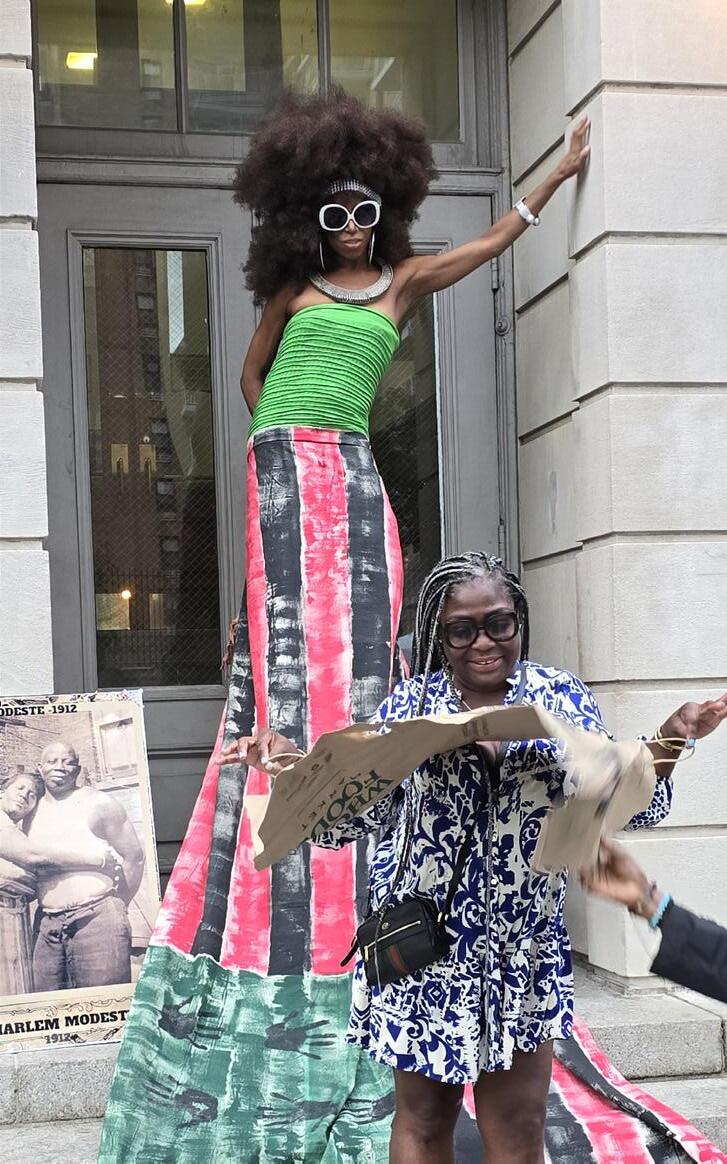
Sista Zock
(Photos courtesy of the artist)



Longtime Harlem resident and well-known performer Sista Zock brings the storied Minton’s Playhouse (206 W. 118 Street) to life with her perspective on the music that made the club a national shrine, from its stimulating bebop creativity to its sizzling jam sessions.
On Feb. 23, from 6:30 p.m.–8 p.m., Sista Zock will take you on a journey of musical and cultural expression. She will be accompanied by an ensemble with such notables as guitarist Bruce Edwards, trumpeter Sharif Kales, bassists Lonnie Plaxico and Stanley Banks, baritone saxophonist Jason Marshall, trombonist Frank Lacy, and drummer Russell Carter, with poet Baba Don and special guests saxophonist Patience Higgins and drummer Victor Jones.
Sista Zock is an expressive dancer who plays a role in keeping the jazz heartbeat of Harlem alive. Join her, along with her large ensemble, as they embark on a journey of living theater where music and storytelling converge in celebration of Black History Month (year). For tickets, visit mintonsnyc.com or call 212529-3397.
The bassist, vocalist, composer, and songwriter Esperanza Spaulding is an intriguing artist whose creativity revels in a swinging persistence of awareness that explores all aspects of this music. Her boundless, ever-

exploring work entwines various combinations of instrumental music, improvisation, singing, composition, poetry, dance, therapeutic research, and storytelling.
The inventive artist and multi-Grammy Award winner, with her many musical facets, will be in residency at the Blue Note Jazz Club (131 W. 3rd Street) from Feb. 18–Mar. 2, with two shows each night (8 p.m. and 10:30 p.m.).
As of this issue, her featured guests or band info was not available, but be assured that each night will be a lively endeavor.
In 2024, Spaulding released a collaborative album, “Milton + Esperanza,” with Brazilian singer Milton Nascimento. That same year, she was featured on the “Odyssey” album by the London-born saxophonist and composer Nubya Garcia, who also believes in boundless travel.
In 2021, her “Formwela 12” paid tribute to dancer and choreographer Carmen de Lavallade and the Dance Theatre of Harlem — the song’s release was accompanied by a short film that featured Spaulding’s band, a quartet of dancers, and de Lavallade, who contributed as choreographer and dancer. During that
period, Spaulding also collaborated with composer and jazz improviser saxophonist Wayne Shorter on his operatic work “Iphigenia” (his interpretation of the ancient Greek myth), which premiered in 2021 — she wrote the libretto. Through her Songwrights Apothecary Lab, Spaulding continues to collaborate with practitioners in various fields relating to sound, healing, and cognition to develop music with enhanced therapeutic potential.Through her many varied projects, from acoustic to fusion, opera to healing, we can be sure new music will be in the making.
For reservations, visit bluenoteny.com or call 212-475-8592.
The 2025 celebration of Black History Month and International Reggae Month also celebrates the centennial of one of America’s most defiant civil rights activists: novelist and playwright James Baldwin.
On Feb. 21 (7:30 p.m.), the Apollo Stages at the Victoria (W. 125th Street) will present a premiere screening of Horace Ové’s short documentary “Baldwin’s Nigger,” which captures a vigorous conversation between

Baldwin and Dick Gregory, who resigned from his comedy career to become a fulltime activist in civil rights. Together, they engage a group of West Indian students in London, discussing a range of topics from the state of the 1960s Civil Rights Movement to the perils of false consciousness. Ové was a Trinidadian-born British filmmaker based in London, England, who earned a somewhat controversial reputation documenting racism and the Black Power movement in Britain through photography and in films such as “Baldwin’s Nigger” (1968), “Pressure,” and “Dream to Change the World” (2003).
This documentary illustrates that, as author, lecturer, and educator bell hooks noted, “America’s white supremacist patriarchy” under the current administration is quickly shifting to a chartered dictatorship with only a frazzled frame of democracy for reference. The current political crisis reflects the continued relevance of Baldwin’s concepts and complete understanding of this country we call America. Baldwin’s works, such as “Nobody Knows My Name,” “Notes of a Native Son,” and “The Fire Next Time,” have remained a reality of truth for Black America in this 21st century. The activist never saw America as a land of milk and honey, but more of a complacent racist society that refused to admit its wrongs or make substantial improvements. As the native of Harlem stated, “Not everything that is faced can be changed. But nothing can be changed until it is faced.”
After the screening, there will be a conversation with Baldwin scholar and historian Dr. Rich Blint.
For tickets, visit apollotheater.org.
in the future among Black electeds throughout the city and state. Part of Stevens’ inspiration for the document came from Hudson’s Black agenda, which she initially put out during her campaign for city council in 2021. “One thing the public advocate always says is you can’t confuse Black persons doing well with Black people doing well,” said Hudson. “It is important to understand that while representation does matter, when we as a people and as a community are not seeing material changes then clearly something is not connecting. We’re missing something. And I think a lot of that has to do with political will.”
Fostering local support
In addition to creating a more unified front among Black electeds, advocates and lawyer groups at the conference spoke about what can be done to defend Black and Brown voters at the local level. The panel included New York Dems Voter Protection, the New York Democratic Lawyers Council (NYDLC), National Association for the Advancement of Colored People (NAACP), Generation Vote, and New Yorkers for Inclusive Democracy.
Lurie Daniel Favors, executive director of the Center for Law and Social Justice, said that the danger in not protecting democracy and the right to vote leads to a gutting of social safety nets, programs, and a blunt desegregation agenda as seen in Trump’s Project 2025 180-day playbook.
Continued from page 3
of intersections to create visibility — as a starting point.
“Around senior centers, there’s been a lot of this investment [in] daylighting and other traffic-calming measures, narrowing car lanes so that cars are less likely to speed, creating more physical foundations at intersections and at corners,” said Garcia. “All these things have seen a lot of improvement, so we know that the infrastructure solutions are there. They’re proven. They’ve worked in cities of the same scale all over the world. They are working here. We just need more of them.”
Last year, 253 people died overall from traffic crashes in New York City, according to the TransAlt report, which uses NYC DOT data.
Children killed in traffic-related incidents tied record highs in the decade of Vision Zero, with 16 (matching 2022), according to the TransAlt report. For reference, 11 children were killed during the program’s first year of implementation.
“Last June, a truck driver ran over my daughters Jael and Leslie as they walked home from their last day of school,” said Woodside mother Maria Sumba in a statement. “Our 16-year-old Jael was killed, and our 8-year-old Leslie survived with serious physical injuries and

“What we’re really talking about is the dismantling of integration, and I need us to be clear about that because this has happened before,” said Favors, speaking about the country’s post-Reconstruction Era. “After that decade was concluded, as a result of political compromise, we saw the complete dismantling of the 13th, 14th, and 15th Amendment[s] as to [their] effectiveness for enslaved Africans to fully realize their participation in the body of politics.”
The panel advocated for legislation like same day voter registration, automatic voter registration, the Civil Rights Act of 1964, the John R. Lewis Voting Rights Act of New York (2022), the state’s Equal Rights Amendment, the Student Voter Empowerment Act, preclearance, access
the psychological trauma of watching her beloved older sister die in front of her. My family will live with this horrific, previously unthinkable loss and pain for the rest of our lives.”
The report also pointed to excessive traffic violation offenders, with 132 vehicles receiving 100 or more speedcamera tickets last year. Two vehicles received more than 500, meaning their owners probably incurred at least one traffic violation a day.
Garcia pointed to last year’s implementation of Sammy’s Law, which reduces speed limits in select areas. He said public safety concerns often prevail the most over violence on public transportation because people see traffic fatalities as isolated accidents.
“These are preventable deaths,” he said. “If people think it’s an accident, they’re like, ‘This is a shame that this happened.’ [They] wish that this didn’t happen to this family, but no one thinks there was something systematically [or] structurally that could have been changed in this intersection corridor that would have prevented this life being taken.”
Tandy Lau is a Report for America corps member who writes about public safety for the Amsterdam News. Your donation to match our RFA grant helps keep him writing stories like this one; please consider making a tax-deductible gift of any amount today by visiting https://bit.ly/amnews1
to ballots and poll sites, and voter protections for the incarcerated without convictions. But above all, they called attention to the need for civic organizing around the coming U.S. Senate and House midterms in 2026 as well as reinforcing the U.S. Census count in 2030.
The census in particular, which notoriously undercounts Black and immigrant neighborhoods, allocates funding based on population. Jeff Wice, fellow and distinguished adjunct professor of law at the New York Law School, concluded that there will likely be an attack around race and ethnicity and immigration status in the coming census count. He also suggested creating a census office within the state, a state census commission, and a grant program to conduct


outreach and education well ahead of 2030.
“As we are watching DEI be eviscerated in Washington D.C.,” said Assemblymember Latrice Walker, who sponsored the panel, in a statement. “We are seeing the attacks on our voting rights, we are watching as the attacks and the relitigation of our civil rights happen each and every day right before our eyes … But we must remain committed to our goals as a Caucus.”
Lastly, most speakers advocated for more innovative ways to bring in students and younger voters, promoting New York City’s Civics for All (CFA) curriculum for grades K through 12 throughout the state as a tool to spark substantive conversations around democracy outside of social platforms.

New York Labor Law requires a "manual worker" be paid their wages weekly and not later than seven calendar days after the end of the week in which the wages are earned.
If you are a manual worker and are paid bi-weekly or semi-monthly, you may be entitled to significant compensation for every instance that you were paid late.
The Romero Law Group PLLC represents employees who are subject to discrimination, retaliation and/or
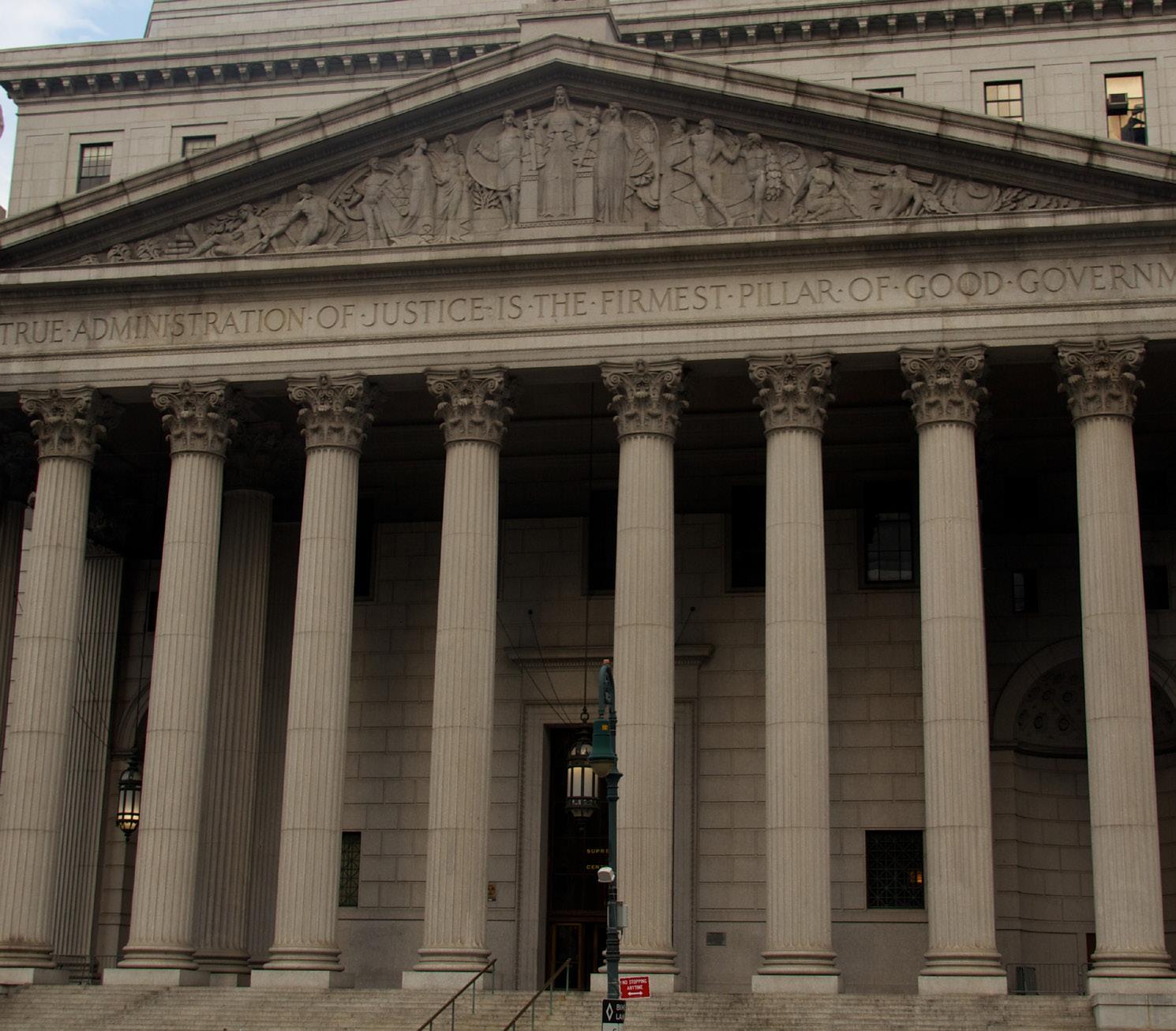

By HERB BOYD
to the AmNews
“Klute” (1971), a film starring Jane Fonda and Donald Sutherland, opens with a scene where actor Nathan George, playing a detective, is explaining an incident, and this is the extent of his appearance. While he has more expansive roles in several other films, George is still missing in various accounts of Blacks in film, including Nelson George’s “Blackface” and Donald Bogle’s “Hollywood Black.”. In “One flew Over the Cuckoo’s Nest” and “The Taking of Pelham One Two Three,” George’s thespian chops are more manifest.
George was born July 27,1936 but his place of birth, like his early years, remains unknown. We do know that after a brief military stint he began studying acting and impressed a number of producers and directors. From an assortment of stage performances, beginning in the late sixties and early seventies, he earned a Drama Desk Award and an Obie that he shared with Ron O’Neal, in 1970 for his role in Charles Gordone’s Pulitzer Prizewinning play, “No Place to be Somebody.”
A review of the play by Clive Barnes in the New York Times provides some insight into George’s role. He portrays Johnny, “a small-time crook — a little pimping for the most part — and his activities are seriously curtailed by the Mafia,” Barnes wrote.. “He dreams of the day when an old gangster, Sweets Crane, a father figure to him, will be released from the pen, so that they can make bad together in the big time. Sweets is released, but the old spirit has gone, and he is reduced to a little token pickpocketing. But Johnny
perseveres and decides to take on the Mafia alone.
Eventually he is put down by bad luck, a crooked judge, police corruption and Mafia hoodlums.
“The play holds the interest, but what is really rewarding is the vigor of the writing and language,” Barnes continued.. “Witty, salty and convincing, the dialogue brings Johnny’s West Village bar to vivid life, and Mr. Gordone can create characters. Johnny
— played superbly well by Nathan George as an object study in uptight relaxation and unflinchingly tragic destiny — emerges as someone completely credible, and so does Gabe Gabriel, the narrator and link-man of the story.”
George reverted back to his policeman roles in “Serpico” (1973) as Lt. Nate Smith and as a cop in “The Taking of Pelham One Two Three” (1974). He portrayed a different character in
“One Flew Over the Cuckoo’s Nest” (1975), playing an orderly. In 1977, he had one of the leading roles in “Short Eyes.” Meanwhile, with the film roles limited, he continued to perform on stage. He concluded his film career with “Brubaker” (1980); “Night Falls on Manhattan” (1996); and “Harsh Light” (1997).
“Madigan” (1972); “To Kill a Cop” (1978); “The Equalizer” (1985); “A Man Called Hawk” (1989), only
There are not too many places to suggest where to find out more, but reviews and notices in Hollywood publications offer a tad more information, though not of his early years.
Along with his comingof-age years, it would be nice to learn more about his military experience.
George was basically born between the World Wars and matured during the late 1950s and mid-1960s.
one episode, and “On Seventh Avenue” (1996) comprised his appearances on television.
As a director, George helmed Ron Milner’s “Who’s Got His Own,” at Center Stage in Baltimore in 1970. For the U.R.G.E.N.T. Theater in New York in 1973, he directed “Cummings and Bowings,” a play based on the poems of e.e. cummings. He was 80 when he died on March 3, 2017 in New York City.
Feb. 16, 1957: Actor LeVar Burton was born in Landsthul, Germany.
Feb. 17, 1963: Basketball great Michael Jordan was born in Brooklyn, N.Y.
Feb. 19, 1940: Soul singer Smokey Robinson was born in Detroit, Mich.
leader Shirley Chisholm was the first Black woman elected to Congress in 1968, and the first woman and Black person to seek the Democratic presidential nomination in 1972. Born in Brooklyn in 1924, she was the oldest of four daughters of immigrant parents. Her father was a factory worker from Charles St. Hill in Guyana, and her mother was a seamstress from Ruby Seale St. Hill in Barbados.
Her motto of “unbought and unbossed” has continued to be a rallying cry for Black women and men throughout the country. Plenty of children of immigrants in the city have followed in her footsteps by pursuing a career in politics.
“I’m from Haiti and came here. Knowing that I was not born here but am included in the process, I’m a part of the fabric of New York City. And I could fight and represent my community,” said Brooklyn Councilmember Mercedes Narcisse, who immigrated to the U.S. as a high school student. “Not just the Haitian community here but the community at large that I represent. All. Everyone, I represent everyone.”
“As a child of Jamaican immigrants, I have firsthand knowledge of the deep commitment and sacrifices made by new Americans to our great city,” said Blake, who’s also running for mayor. “Immigrants care for and teach our children, serve in the
military, and anchor the moral fabric of our communities as faith leaders — all things I’ve witnessed in my family alone.”
Senator Zellnor Myrie, who is running for mayor this year, was born and raised in Brooklyn. His parents came to New York from Costa Rica over 40 years ago. When asked who he’d highlight as a local figure of immigrant background that shaped the city, he went outside the box and chose Constance Baker Motley, a trailblazing lawyer and civil rights activist.
“We had the honor of having a national treasure, a proud daughter of immigrants… who broke so many barriers who has set such a strong legacy,” said Myrie. “First as a lawyer for the NAACP she was instrumental in the landmark cases that were argued during the height of the civil rights movement, including Brown versus Board of Education. While we honor and praise Thurgood Marshall, and he deserves every word of it, it was her work in the background and daily that helped make those cases what they were but then she didn’t stop there.”
She became the first Black woman elected to the New York State Senate.
Myrie gushed about how Motley continued to achieve even more as she went on to become the first female borough president of Manhattan and broke a federal barrier by becoming the first Black woman federal judge in the Southern District of New York in Manhattan.
“So this proud daughter of immigrants not only is an example of why that con-
tribution to our city is so important,” said Mryie. “It is truly an example of what can happen when we invest in this community, and when we let people flourish and be great as they were intended to be.”
One of Narcisse’s biggest local inspirations is former Councilmember Dr. Una Clarke, who is the first Caribbean-born woman to be elected to the New York City Legislature.
Narcisse herself attended Tilden High School in Brooklyn, where she learned to speak English. She became a registered nurse, was an incredibly active member and president of local political clubs while running a small business, and raised her four children. She is the first Haitian-born person to represent the 46th City Council District in Brooklyn. She credited her growing up with her grandmother back in Haiti for sparking her love of community engagement and politics. Her grandmother was an organizer who fought for better pay equity for farm workers.
“As a kid, I was 5 years old, they would wake me up to go to the farm to help out,” said Narcisse. “To carry water every summer.”
Many aspiring leaders from immigrant backgrounds Amsterdam News reached out to also attributed their love of civics and community to growing up with loved ones that were fierce advocates.
Hassan Bakiriddin, who runs the Unified Political Association (UPA), highlighted Public Advocate Jumaane D. Williams,
who is famously proud of his Grenadian heritage; Patricia Reddock, president of the 67th Precinct Community Council in East Flatbush; and his wife, Joan Bakiriddin — who was the first Vice President of the Brooklyn NAACP.
Edwards’ mother was a vocal leader for the New York State Association of Minority Contractors (NYSAMC) and advised countless elected officials. She relentlessly fought for minority businesses to have equal footing, funding, and access to opportunities that were historically reserved for white contractors, he said.
“For me, this resilience is best embodied by my mother, Elenora P. Bernard. Like so many before her, she migrated to the United States seeking opportunity, not just for herself but for her community,” said Edwards.
“She shattered barriers, becoming the first African American and Caribbean American Vice President at Episcopal Health Services, where she led the construction of the Bishop Hercules Nursing Home in Bed-Stuy — an opportunity she ensured included minority contractors who had long been shut out of such projects.”
“Her life’s work was a testament to what the African Diaspora has achieved in the face of oppression,” continued Edwards.
“From the horrors of slavery to the fight for economic justice, she embodied the unbreakable spirit of our people. Her legacy is not just one of personal success, but of creating pathways for others, ensuring that the sacrifices of our ancestors were not in vain.”
By HEATHER M. BUTTS, JD, MPH, MA Special to the AmNews
The Amsterdam News recently interviewed Samantha Banerjee, executive director of PUSH for Empowered Pregnancy, which has a mission of reducing the incidence of preventable stillbirth in the United States, after the organization helped support a virtual press conference with the Mobilize Maternal Health Coalition on Feb. 4, 2025, to announce the “Empowering Reproductive Justice Campaign.” The campaign will address maternal healthcare issues in New York, with a focus on legislative measures such as the Paid Leave after Stillbirth, to support equitable healthcare for all. The event included reproductive justice organizations, public officials, and advocates. Invited guests included New York City Public Advocate Jumaane Williams, Bronx borough President Vanesa Gibson, Banerjee, and other experts. This interview has been edited and condensed for clarity.
AmNews: Please tell our readers about how you got involved with this work and in this community?
Samantha Bannerjee (SB): I am a stillbirth mom. My daughter Alana was born still in 2013, two days before her due date, after [I had] a totally normal and healthy pregnancy. [We] walked into the hospital thinking we would be bringing home our baby girl, the first grandchild on both sides of our family. I was told throughout the entire pregnancy that it was textbook and low risk and all the good things, only to be told that she no longer had a heartbeat, so we were completely blindsided.
I was not an uninformed pregnant person, but I never even heard the word stillbirth outside of a Victorian context, had no idea it was happening to anyone in this day and age, let alone that it could happen to me. That was how I found myself here in this community. I am now the executive director of Push for Empowered Pregnancy. We are a New York-based national 501c3 public charity dedicated to ending preventable stillbirth. Push was started in 2021 by parents like me across the U.S. who experienced potentially preventable stillbirths. We said we are coming together and we are going to take big, bold action on a national scale to make sure that other parents know this is happening and how to lower the risk of it happening to them, and to make sure more importantly that our public health system acknowledges this crisis,which is claiming the lives of
65 children every single day in this country.
AmNews: Please describe the “Empowering Reproductive Justice Campaign” virtual press conference on Feb. 4, 2025.
SB: This event was to announce the Empowering Reproductive Justice Campaign through the Mobilized Maternal Health Coalition (MMHC). We had several advocates from all different aspects of maternal health explain the state of maternal health, maternal mortality, and stillbirth in New York State and why it’s necessary for this coalition to exist. We had a variety of speakers talk about the different bills and issues that this coalition is going to be advocating for together. We had advocates and families directly from the communities come on to share their personal experiences.
AmNews: What thoughts would you like to leave with our readers?
SB: Black moms are twice as likely to experience a stillbirth due to systemic racism, implicit bias, structural factors, [similar to what] we see with maternal mortality. Both of these issues are caused by a lot of the same root causes, which means that the prevention methods are also very much aligned. Most of that is listening to parents, respecting us when we report that there’s something wrong with our pregnancies, taking it seriously, and generally equipping people with the information they need to advocate for themselves.
We work closely with a lot of the leading Black maternal health organizations. Here in New York, we [work with] Speak! Move! Change! Coalition, which is run by the Arya Foundation; Dr. Shalon’s Maternal Action Project and the Tatia Oden French Memorial Foundation; and individuals from the communities like doulas, birth workers, researchers, and doctors — people coming together to say we need improved pregnancy outcomes for Black, Brown, and Indigenous people who are at the highest risk.

“Trump’s hateful rhetoric and anti-immigrant policies never really left — we see them echoed in City Hall today. This rally isn’t just about resisting a man; it’s about resisting the normalization of cruelty. LGBTQ+ immigrants like me came here seeking safety, and instead, we are met with exclusion and hostility. Standing here today is about saying: “We refuse to go backward,” Okporo told the Amsterdam News.
An asylum seeker who arrived in the United States fleeing prosecution, Okporo’s story of being refuted as a gay immigrant and having to cast defiance resonated with hundreds that gathered that day.
And while he reminded people of when the election starts, he mentioned that the resistance is a daily routine so long as Trump, Musk, and Adams are in opposition to migrant- and LGBTQ-focused policies, like the insurance of the city being a sanctuary city or the erasure of gender identities.
“Resistance happens in our neighborhoods, in our workplaces, in our city’s policies. We resist Trump’s agenda by ensuring New York lives up to its promise as a sanctuary city — not just in name, but in practice. That means expanding immigrant protections, stopping Adams from criminalizing asylum seekers, and holding local officials accountable. Resistance isn’t a one-day event —
Many that day expressed their vulnerabilities, but through Okporo’s speech, the crowd’s spirited energy echoed through that historic square.
Accompanying the city council candidate was Jay W. Walker, an activist and organizer involved in various resistance groups. He is a co-founder of the Reclaimed Pride Coalition, Stop the Coup, the Queer Liberation March, Rise and Resist, and serves as the President of Gays Against Guns. Walker draws from his experiences as a gay man in his activism.
Walker told Amsterdam News that he opposes Musk’s technocratic relationship with Trump, adding that it threatens to undo the progress that gay activists have fought for.
“We are here to say that the American people will not stand for Donald Trump turning our federal government over to Elon Musk and his tech pros to essentially destroy about 100 years, 150 years of progress that has taken place in our federal government. It’s disgusting, it’s un-American, it’s unpatriotic, it’s fascist, it’s Christian nationalist, and it must be stopped,” Walker said.
People from all walks of life protested against Trump, Musk, and Adams, with prominent poet and poetry slam artist Bob Holman lending his voice to the movement. Holman is a champion of spoken word as an art form, engaging dynamically with audiences through WNYC and PBS for decades. He also mentors a new generation of artists to help preserve the arts at
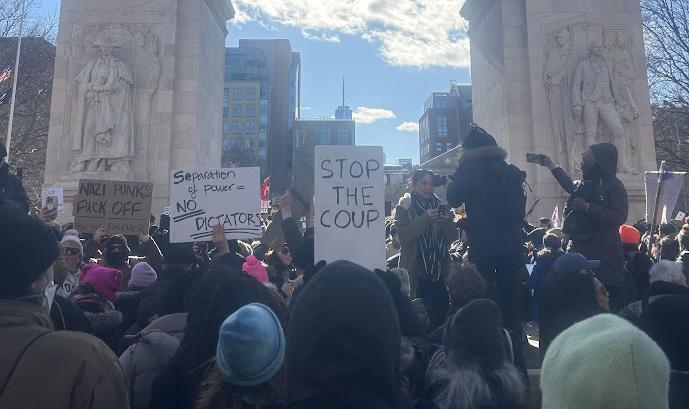
However, on Feb. 17, during his performance at Union Square Park near the equestrian statue of George Washington, Holman’s spoken words were more explicit than usual.
“Well, you know, for me, I’m an artist, so it comes from... It comes out of the art. Art is... Is the freedom I have. Freedom to be a poet. You know, I have a freedom to ... to speak. But now if that’s going... That’s going away. I’m not going to let that happen. It’s happened to my friends in Ukraine, and it happened to my friends in Russia. You know, we’re not going to let that happen. It’s happened in China, it happened in the
Okporo’s rallying cry comes from leadership that stems from lived experiences, such as the struggles for justice, equality, and inclusion. His final message to the crowd was that it is time to act now.
“Protests make noise, but policy makes change. If elected, I will fight to expand legal protections for immigrants, secure housing and work permits for asylum seekers, and block Adams’ attempts to push immigrants deeper into precarity. The passion we feel today must be carried into legislation, into community organizing, and into the voting booth. We can’t
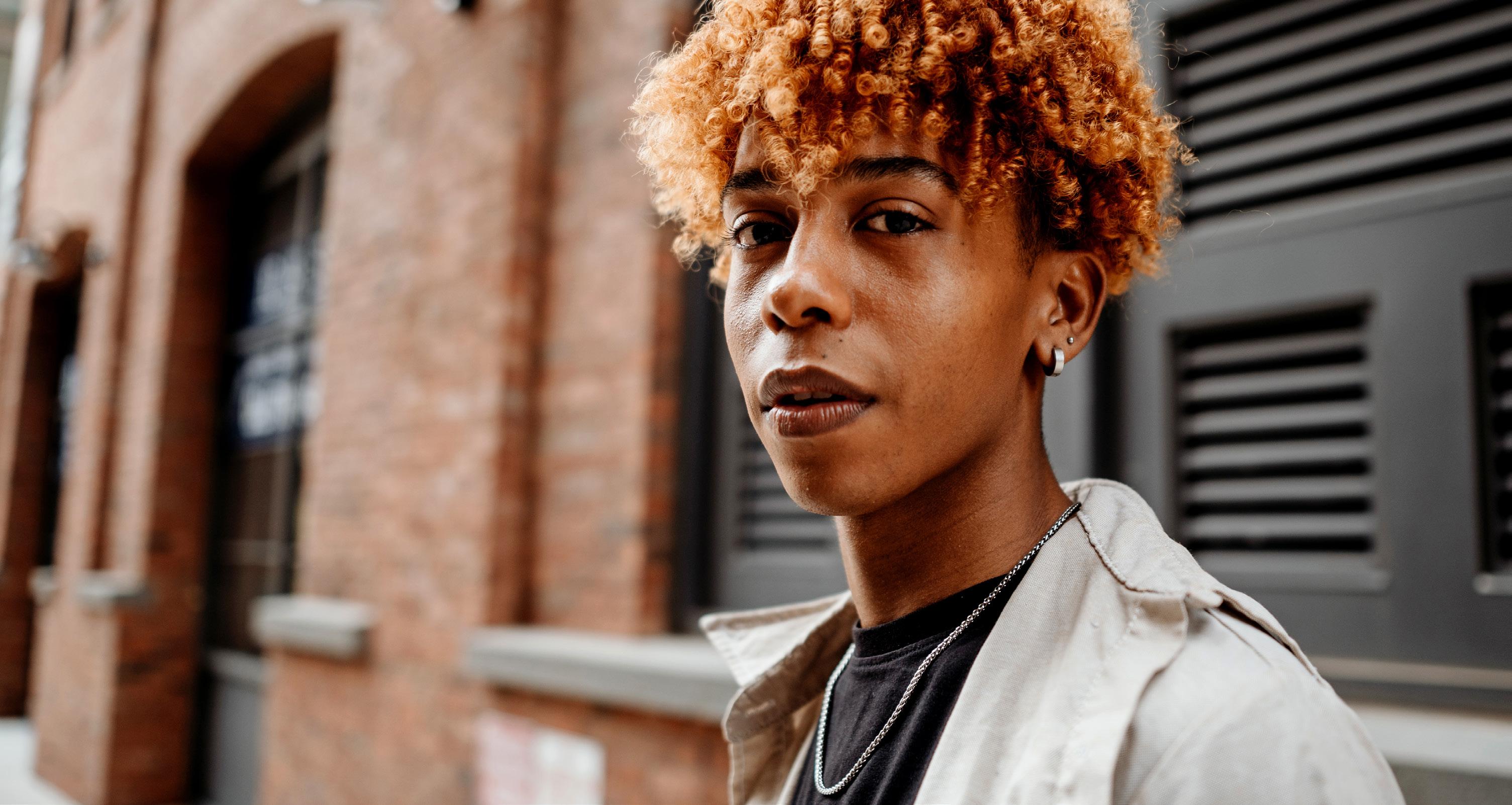
By ANNIE MA and JOCELYN GECKER AP Education Writers
COMPTON, Calif. — Math is the subject sixth grader Harmoni Knight finds hardest, but that’s changing.
In-class tutors and “data chats” at her middle school in Compton, California, have made a dramatic difference, the 11-year-old said. She proudly pulled up a performance tracker at a tutoring session last week, displaying a column of per fect 100% scores on all her weekly quiz zes from January.
Since the COVID-19 pandemic first shut tered American classrooms, schools have poured federal and local relief money into interventions like the ones in Knight’s classroom, hoping to help students catch up academically following COVID-19 dis ruptions. However, a new analysis of state and national test scores shows the average student remains half a grade level behind pre-pandemic achievement in both read ing and math. Students are even further behind in reading than they were in 2022, the analysis showed.
Compton is an outlier in making some of the biggest two-year gains in both subjects among high-poverty districts. There are other bright spots as well, along with evidence that interventions like tutoring and summer programs are working.

like tutoring. Now, schools must prioritize interventions that worked. Districts that spent federal money on increased instructional time, either through tutoring or summer school, saw a return on that investment, Kane and Reardon said.
Brawley said Compton hopes to maintain its tutoring programs using other funding sources. “The question is, at what scale?”
Elsewhere in the country, reading levels have continued to decline, despite a movement in many states to emphasize phonics and the “science of reading,” so Reardon and Kane called for an evaluation of the mixed results for insights into the best ways to teach kids to read. Schools must engage parents and tell them when their kids are behind, and continue to work with community groups to improve student attendance, the researchers said. The scorecard identified a relationship between high absenteeism and learning struggles.
Tutors
The Education Recovery Scorecard analysis by researchers at Harvard, Stanford, and Dartmouth allows year-to-year comparisons across states and districts, providing the most comprehensive picture yet of how American students are performing since COVID-19 first disrupted learning.
The most recent data is based on tests taken in spring 2024. By then, the worst of the pandemic was long past, but schools were still dealing with a mental health crisis and high absenteeism — not to mention students whose crucial learning had been interrupted.
“The losses are not just due to what happened during the 2020 to 2021 school year, but the aftershocks that have hit schools in the years since,” said Tom Kane, a Harvard economist who worked on the scorecard.
In some cases, the analysis showed school districts are struggling, even though their students may have posted decent results on state tests. That’s because each state adopts its own assessments, and those aren’t comparable to each other. Those differences can make it impossible to tell whether students are performing better because of their progress, those shifts are because the tests themselves are changing,
or a state has lowered its standards for pro ficiency. For example, Kane cited the analysis as showing that Wisconsin, Nebraska, and Florida seem to have relaxed their proficiency cutoff in math and reading in the last two years.
The scorecard accounts for differing state tests and provides one national standard.
Higher-income districts have made significantly more progress than lower-income districts, with the top 10% of high-income districts four times more likely to have recovered in both math and reading compared with the poorest 10%. Recovery within districts remains divided by race and class, especially in math scores. Test score gaps grew by both race and income.
“The pandemic has not only driven test scores down, but that decline masks a pernicious inequality that has grown during the pandemic,” said Sean Reardon, a Stanford sociologist who worked on the scorecard. “Not only are districts serving more Black and Hispanic students falling further behind, but even within those districts, Black and Hispanic students are falling further behind their white districtmates.”
Tutors in class, after school, and on Saturdays
Still, many of the districts that outperformed the country serve predominantly low-income students or students of color, and their interventions offer best practices for other districts.
In Compton, the district responded to the pandemic by hiring more than 250 tutors who specialize in math, reading, and students learning English. Certain classes are staffed with multiple tutors to assist teachers. Schools also offer tutoring before, during, and after school, plus Saturday and summer programs for the district’s 17,000 students, said Superintendent Darin Brawley. The district also now conducts dyslexia screenings in all elementary schools.
The low-income school district near downtown Los Angeles, with a student body that is 84% Latino and 14% Black, now has a graduation rate of 93%, compared with 58% when Brawley took the job in 2012.
Knight, the Compton sixth grader, said tutoring has helped her grasp concepts and given her more confidence in math. She has “data chats” with her math specialist that are part performance review, part pep talk.
“Looking at my data, it kind of disappoints me” when the numbers are low, said Knight, “but it makes me realize I can do better in the future, and also now.”
Brawley said he’s proud of the district’s latest test scores, but not yet content. “Truth be told, I wasn’t happy,” he said. “Even though we gained, and we celebrate the gains, at the end of the day, we all know that we can do better.”
That could be more difficult in coming years. Federal pandemic-relief money has ended; many schools used it for programs
In the District of Columbia, an intensive tutoring program helped with both academics and attendance, according to D.C. Public Schools Chancellor Lewis Ferebee. In the scorecard analysis, the D.C. ranked first among states for gains in both math and reading between 2022 and 2024, after its math recovery had fallen toward the bottom of the list.
Pandemic-relief money funded the tutoring, along with a system of identifying and targeting support at students in greatest need. The district also hired program managers who helped maximize time for tutoring during the school day, Ferebee said.
Students who received tutoring were more likely to be engaged with school, Ferebee said, both from increased confidence and because they had a relationship with another trusted adult.
Students were more confident in math because they were being validated by another adult, Ferebee said. “That validation goes a long way, not only with attendance, but a student feeling like they are ready to learn and are capable.”
Federal pandemic relief has ended, but in December, the city allocated $4.8 million to continue tutoring programs this school year.
Christina Grant, D.C.’s superintendent of education until 2024, said she is hopeful about seeing evidence emerging of what’s boosted student achievement. “We cannot afford to not have hope. These are our students. They did not cause the pandemic,” Grant said. “The growing concern is ensuring that we can ... see ourselves to the other side.”
By early 2024, Haynes and Robinson were suspended and placed on paid administrative leave amid yet another investigation into allegations against them, conducted by Carter Ledyard & Milburn LLP at the behest of the state. In the interim, RIOC operations were overseen by Chief Financial Officer (CFO) and Vice President Dhruvika Patel Amin and Assistant Vice President & Deputy General Counsel Gerrald Ellis, who ended up resigning in 2024.
In a governance committee meeting on Sept. 6, 2024, the subject of terminating Haynes “for cause” and Robinson “just because it didn’t work out” was broached publicly. Several members quickly said
of people who began to contribute their time and knowledge. Raheem and Assanah saw an outpouring of community support from Columbia University students, parents and grandparents with time on their hands, and eventually donations from nearby grocery stores and local growers.
Harlem Grown doesn’t just grow and give food. They also see Harlem — a neigh -
the subject should be discussed privately in executive session. Committee Chair Lydia Tang and Board Member Ben Fhala said it was not being addressed and called for the board to fully vote on the firings. Fhala insisted, in the meeting, that the legal fees, investigations, and leave costs couldn’t be sustained.
Fhala again broached the subject of firing Haynes and Robinson against protocol and had a heated exchange with board members at a meeting on Sept. 19, 2024. A few months later, in a special meeting of the RIOC Board of Directors on Nov. 19, 2024, the board moved to an executive session to discuss litigation and other matters involved in the removal of a person. No votes were taken. However, Fhala resigned shortly after that session.
borhood with an embedded Black community and immigrants — as a resource for their work as well. People with no gardening experience become selftaught urban farmers. Older folks are willing to learn new skills. Immigrants who may have grown up gardening or farming in their native countries share their experiences in growing and preserving/cooking cultural foods.
“We as a community have a lot more resources and expertise than we give ourselves credit for,” said Raheem. “How do we collect that willpower and that
Haynes and Robinson were officially dismissed on Nov. 22, 2024. They maintained that they were fired as a retaliation since no findings from the last investigation were released.
“It meant something to do the job and do the job well,” said Haynes. “[T] hrough my entire tenure as president, eight years total there [and] I did four years as chief operating officer, and not a single issue there. I became president and the whole world fell out. We were being attacked and investigated, and all this craziness, and still achieving record-breaking things that transformed the entire island.”
Robinson said she’s actively pursuing new opportunities, but has had difficulty. “It’s a very sobering situation to be here,” she said. “This is the first time I’ve
talent and that desire to be helpful to come together as a community to create healthier outcomes for ourselves?”
Although the group does face some challenges in recruiting for specific and specialized skills, Harlem’s ability to come together never ceases to amaze Assanah — volunteer turned urban farmer.
“We are a unit, you know? And that’s not just the old Harlem,” she said. “That’s what Harlem was. That’s what Harlem is. And some people may not see it, but if you’re not in it, you won’t know about it. That’s the Harlem I come from.”
ever been fired in my life. I’ve worked in government for 20-plus years. The irony is that a lot of people choose the government for job security and to do good work, and I feel very wronged in what has happened and how I’ve been treated. To be terminated without cause for doing my job is very, very uncomfortable. I have no insurance, no income coming in. I’m doing my best to make sure I don’t lose everything.”
Currently, Mary Cunneen is RIOC’s chief operating officer (COO), Aida Morales is chief of staff, and Amin is still CFO and vice president.
When the Amsterdam News asked Hochul’s office about the RIOC situation, they said they “couldn’t comment on pending litigation.”
The RIOC press office didn’t respond to a request for comment by press time.
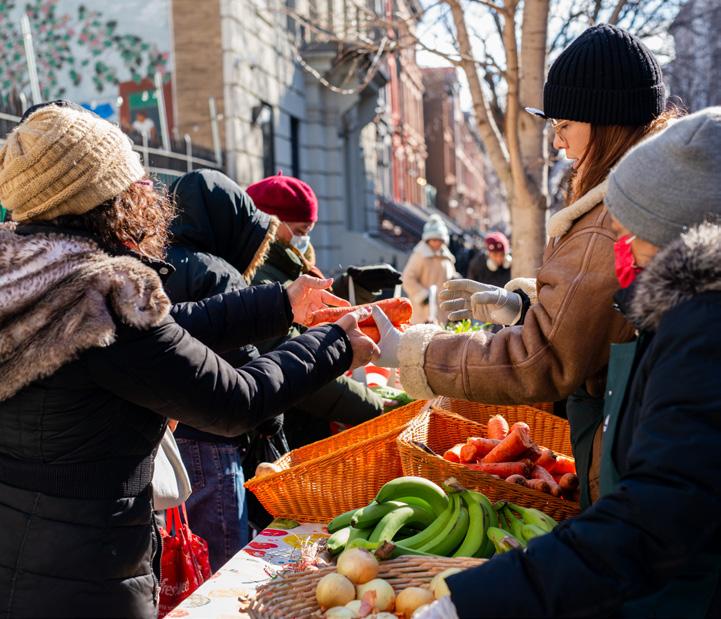

By HERB BOYD and CINQUE BRATH Special to the AmNews
“There can be no hesitation henceforth,” Sam Nujoma wrote in his autobiography, “Where Others Wavered” (2001), about the struggle for independence in Namibia, or Southwest Africa. “The course has been set. We have no alternative but to rise in arms and bring about our own liberation. The supreme test must be faced and we must at once begin to cross the many rivers of blood on our march towards freedom. And as sure as night follows day, victory will be ours.”
His prophecy of victory was indicative of his leadership and determination. The revolutionary died Feb. 8 in Windhoek, Namibia. He was 95.
Many activists and residents in New York were introduced to Nujoma by the late Elombe Brath via the Patrice Lumumba Coalition. In 2005, when Nujoma made his last address to the Harlem community, Brath covered the event. Nujoma saluted the assembly of members and organizations for their contribution to the fight for liberation in Namibia. “Namibia’s protracted liberation struggle was bloody and bitter,” Nujoma said. “It demanded untold suffering and sacrifices of our people inside the country and the rest of us who were forced to spend many decades in exile”; in his case, 29 years. His visit, Brath observed, was something the Harlem welcoming committee planned to honor his return, which began 44 years before. In his autobiography, , Nujoma explained the connection between Black nationalism in America and the anti-colonial fight in Africa. “Over the years we struggled hard and finally gained recognition, with observer status for SWAPO (South West Africa People’s Organization) in the general assembly. We were also able to address the General Assembly directly and there was even support, in the form of facilities, allocated to us. But before we were able to have our own representatives at the UN we were greatly helped by Marcus Garvey’s African Pioneer Movement …” He was probably referring to the African Nationalist Pioneer Movement founded by Carlos Cooks. Born Samuel Shafiishuna Daniel Nujoma on May 12, 1929, to a mother who was a princess by descent, he was the eldest of 11 children. Looking after his younger siblings and herding cattle occupied much of his youth. While his education was limited, he did com-
plete Standard Six, the highest Blacks could achieve at that time. He was still a teenager when he began working in Walvis Bay in 1946, which put him in touch with European soldiers during World War II.
Two years later, Nujoma began working as a cleaner for South African Railways (SAR).
“In 1957, at the age of 29,” he wrote, “I resigned from the SAR with the purpose of devoting my time to politics. However, I had to face the problem that, by law, an African not employed or in the service of a white man would not be allowed to live in Windhoek or elsewhere in the urban districts.
“My solution was to seek employment with the Windhoek Municipality doing some clerical work. But when I found myself doing the work of lazy Boers, with too little money as my salary, I resigned and found employment with Hurbert Davis, a subsidiary of a Cape Town company which supplied and fitted electric cables in new buildings. The manager liked my work, but other whites did not, so I left and moved to another job with Carsten Veld, a South African manufacturing representative and wholesaler.”
By this time, Nujoma had already begun to protest against the apartheid that restricted Black Africans. When the Andimba Toivo ya Toivo was arrested in 1959, Nujoma was further incensed and spurred to activism. “From April 1959 we could now petition as the Ovamboland People’s Organization (OPO),” he continued in his autobiography. “Though formed by a group of individuals, it already had a solid base among the Contract workers of the Windhoek area, in the Old Location and the Pokies Draal Compound. I was the founding President, with Louis Nelengani as Vice-President and Jacob Kuhangua as Secretary-General. To form the OPO Constitution, we adapted a copy of the OPC Constitution, changing it only slightly to suit the political conditions in South West Africa. I myself typed it out on a secondhand typewriter I had bought from an old German lady in Windhoek.”
There, he stated the revolutionary aims and objectives of the organization. A year later, SWAPO was formed, and Nujoma joined its executive committee, representing OPO.
After being arrested for his political resistance, it was decided that he should leave the country and operate outside of it. Nujoma met all the prominent African revolutionaries: Patrice Lumumba, Gamal Nasser, Frantz Fanon, et al. Kwame Nkrumah assisted his desire to travel to the U.S. and later to Liberia, where a case about South West Africa was being presented to the International Court of Justice. Later, in Tanganyika, he received support from

Julius Nyerere and established SWAPO’s provisional headquarters in Dar es Salaam. Five years later, SWAPO launched the first armed attack, thereby igniting the Namibian war of independence.
After the collapse of the Portuguese empire, Nujoma realized a change was necessary and moved the military base from Zambia to Angola. It would take a decade of struggle against the apartheid regimes in South Africa and Namibia, but by March 1989, a cease-fire agreement with South Africa was implemented via Security Council Resolution 435. In September, after nearly a generation in exile, Nujoma returned to his homeland. He arrived just in time to be elected Namibia’s first president and was reelected in 1994, bolstered by his land reform initiatives. (By 2007, some 12% of the total
commercial land was taken from white farmers and given to Black citizens.)
In the final pages of his autobiography, Nujoma said he was most proud of the nation’s constitution. “The Constitution of Namibia is, in many ways, a unique document,” he said. “The oppressed, the disenfranchised who at last won their struggle for freedom, argued for the enshrining of the fundamental human rights in the Constitution. These rights cannot be diluted. Further, ours is perhaps the only Constitution that commits the government to environmental protection. We are proud that our Constitution has been applauded all over the world by scholars and politicians alike, and we are proud that during the first ten years of independence Namibia has lived up to the letter of this supreme law.”
for them. There are specific clients who have specific either autonomy requests and/or maybe certain medical needs.”
She adds that homeless services tend to be place-based. “If you’re getting benefits in New York, you are not [also] getting benefits in New Jersey,” she said.
To be clear, the overlap between Newark and New York City is not
big for BRC. Roughly a few dozen individuals enroll in its cross-state services, which collaborate with the Path Home providers to avoid overlap in services (the program requires participants to consent).
“I need to know which clients are in New Jersey and I need to know who they’re working with there, and then we can have a conversation about ‘I’m at this point
handball, I can play handball. If my kids want to play in the park and swing on the swings, they can do that. But if I want to play tennis, that’s the only thing that’s locked.”
For dedicated tennis enthusiasts, there are plenty of days during winter when outdoor tennis matches can be played. This is one of the benefits of residing in a city like New York, a place recently recognized by the personal finance website WalletHub as the nation’s second-best city for an active lifestyle. The city provides lots of opportunities for engaging in physical exercise. Ac-
cording to the site’s survey, New York offers dance schools, swimming lessons, bike rental services, basketball courts, soccer fields, ice rinks, and the second-highest number of playgrounds per capita –– all amenities that offer people chances to maintain fitness.
NYC Parks Department regulations state that the public is required to have access to parks and that “outdoor tennis courts are open daily, weather permitting, except when under construction or repair, or when reserved for tournaments or special events.”
in a process with them, you’re at that point in a process with them, what makes the most sense for us with this individual to get them housed as quickly as possible,’” explained Quirk.
Lasheema Sanders-Edward, a regional coordinator for nonprofit partner Collaborative Support Programs of New Jersey, said an outreach worker from her now-employer reached her when she was experiencing homelessness. In a recent press conference, she said
Kenny Bruno, another local tennis player who is frustrated by the closing off of the courts, told the AmNews that he had spoken to Commissioner Maher, who “told me that the decision to close the courts for the winter was made by the Revenue Division and he abided by it.” But when Bruno also spoke with representatives of NYC Parks Department Commissioner Sue Donoghue, he was told that the commissioner herself closed the courts, not because of vandalism or because of anything to do with the Revenue Division. There had been three incidents where people felt threatened on the courts, and since there was no Parks personnel available to monitor the area, the commissioner decided to lock it down.
constant outreach was key “for those who have lost hope in services.”
“They met me where I was,” said Sanders-Edward over the phone. “I didn’t know, and I wasn’t really aware of what was going on with me, and it was also along with substance use, so I ended up homeless. This outreach worker took a liking to me, and every day, they met me at the train station. They came there, they bought me what I needed. They helped me … get my birth certificate, as they said they
Councilmember Chi Ossé’s office has not responded to numerous requests for comment about what is happening with the Jackie Robinson’s Park tennis courts. But the office of State Sen. Jabari Brisport, who also represents the district, said that though they don’t have jurisdiction over the Parks Department because it’s a city agency, they’ve reached out to Maher’s office to advocate for the courts’ re-opening.
“I have reached out to NYC Parks about this, and they have not provided sufficient justification for punishing an entire community by closing its courts for the whole season,” Sen. Brisport said in a statement. “Public spaces like these courts provide a place for commu-




would be able to do.
“And little by little, I started to progress, and eventually, I got curious about getting help.”
Tandy Lau is a Report for America corps member who writes about public safety for the Amsterdam News. Your donation to match our RFA grant helps keep him writing stories like this one; please consider making a tax-deductible gift of any amount today by visiting https:// bit.ly/amnews1.
nity members to connect with each other, to maintain their physical and emotional wellbeing, and to experience joy together; they are not trivial and should not be withheld from the public they were built to benefit.”
The Parks Department said in a statement to the AmNews, “We look forward to reopening the courts in April when the tennis season begins. To help ensure compliance and safety for both Parks staff and the community, Parks will station a seasonal tennis attendant at the courts. We appreciate the community’s advocacy and look forward to reopening soon. We have been in communication with the local council member and community board about this issue.”



Supreme Court of the State of New York, New York County, Index No. 850180/2022
CANCELLATIONS must be made in writing by 12 Noon Monday.
The forwarding of an order is construed as an acceptance of all advertising rules and conditions under which advertising space is sold by the NEW YORK AMSTERDAM NEWS. Publication is made and charged according to the terms of this card.
Rates and regulations subject to change without notice. No agreements as to position or regulations, other than those printed on this.
Til forbid orders charged for rate earned. Increases or decreases in space take the rate of a new advertisement.
The New York AMSTERDAM NEWS reserves the right to censor, reject, alter or revise all advertisements in accordance with its rules governing the acceptance of advertising and accepts no liability for its failure to insert an advertisement for any cause. Credit for errors in advertisements allowed only for first insertion.
• Classified advertisements take the regular earned rate of their classification. Four line minimum on all ads except spirituals and horoscopes (14 lines).
• Classified Display (boarder or picture) advertisements take the regular earned rate of their classification. Display (boarder or picture) advertisements one column wide must be 14 lines deep; two columns, 28 lines deep; 3 columns, 56 lines deep. Classified Display (boarder or picture) placed as close to classifications as rules and makeup permit.
All advertisement accepted for publication is classified according to the standard classifications. Misclassification is not permitted.
BASIS OF CHARGE Charges are based on point size and characters per line. Upon reaching 15 lines the rate converts to column inch. Any deviation from solid composition such as indentation, use of white space, bold type, etc., will incur a premium.
In Case of error, notify the Amsterdam News 212-932-7440
Six Gramercy LLC, Plaintiff, v. Westside Units Kips Bay, LLC et. al., Defendants.
TAKE NOTICE that pursuant to the Judgment of Foreclosure and Sale entered November 1, 2024, the undersigned referee will sell at public auction on March 26, 2025 at 2:15pm in Room 130 at the Courthouse located at 60 Centre Street, NY, NY, the property located at 330 East 33rd Street, Unit 12F, New York, NY 10016 (Block 936, Lot 4160). The approximate amount of Plaintiff’s lien is $391,830.98 plus interest and costs. The premises will be sold in one parcel and subject to provisions of the judgment and terms of sale.
Elaine Shay, Esq.
Law Offices of Tae H. Whang, LLC, Attorneys for Plaintiff, 185 Bridge Plaza North, Suite 201, Fort Lee, NJ 07024, Tel. (201) 461-0300
SUPREME COURT - COUNTY OF NEW YORK. NYCTL 2021- A TRUST, AND THE BANK OF NEW YORK MELLON AS COLLATERAL AGENT AND CUSTODIAN FOR THE NYCTL 2021- A TRUST, Plaintiff -against- WA IDF LLC, et al Defendant(s).
Pursuant to a Judgment of Foreclosure and Sale dated October 16, 2024 and entered on October 17, 2024, I, the undersigned Referee will sell at public auction in Room 130 of the New York County Courthouse, 60 Centre Street New York, NY on March 19, 2025 at 2:15 p.m. premises situate, lying and being in the Borough of Manhattan, City, County and State of New York, known and designated as Block 1949 Lot 48. Said premises known as 541 MANHATTAN AVE, NEW YORK, NY 10027
Approximate amount of lien $47,429.63 plus interest & costs.
Premises will be sold subject to provisions of filed Judgment and Terms of Sale. Index Number 157666/2022. TOM KLEINBERGER, ESQ., Referee Bronster, LLP
Attorney(s) for Plaintiff 156 West 56th Street, Suite 703, New York, NY 10019
Notice of Formation of KATLIN MONTALI CONSULTING LLC Arts. of Org. filed with Secy. of State of NY (SSNY) on 01/13/25. Office location: NY County. SSNY designated as agent of LLC upon whom process against it may be served. SSNY shall mail process to Corporation Service Co., 80 State St., Albany, NY 12207. Purpose: Any lawful activity.
NOTICE OF SALE
SUPREME COURT COUNTY OF NEW YORK, EMIGRANT FUNDING CORPORATION, Plaintiff, vs. HERSHEY CHAN REALTY, INC., ET AL., Defendant(s).
Pursuant to an Amended Judgment of Foreclosure and Sale and Decision + Order on Motion duly entered on July 14, 2023, an Order Amending Judgment of Foreclosure and Sale dated September 22, 2023 and a Decision + Order on Motion duly entered on October 4, 2024, I, the undersigned Referee will sell at public auction at the New York County Courthouse, room 116, 60 Centre Street, New York, NY 10007 on March 5, 2025 at 2:15 p.m., premises known as 44 Bowery, New York, NY 10002. All that certain plot, piece or parcel of land, with the buildings and improvements thereon erected, situate, lying and being in the Borough of Manhattan, County, City and State of New York, Block 202 and Lot 28. Approximate amount of judgment is $4,103,570.52 plus interest and costs. Premises will be sold subject to provisions of filed Judgment Index #850215/2021.
Scott H. Siller, Esq., Referee
Borchert & LaSpina, P.C., 19-02 Whitestone Expressway, Suite 302, Whitestone, New York 11357, Attorneys for Plaintiff
SUPREME COURT-NEW YORK COUNTY- HILTON RESORTS CORP., Pltf. v. DANIEL SHIH and BARBIE SHIH, Defts. - Index # 850269/2024. Pursuant to Judgment of Foreclosure and Sale dated January 9, 2025, I will sell at public auction in Room 130 of the New York County Courthouse located at 60 Centre Street, New York, NY on Thursday, March 13, 2025, at 2:15 pm, an interest of an undivided 0.1505136467542480 tenant in common interest in the timeshare known as HNY CLUB SUITES Phase II located at 1335 Avenue of the Americas, New York, NY. Approximate amount of judgment is $146,962.86 plus costs and interest as of October 9, 2024. Sold subject to terms and conditions of filed Judgment and Terms of Sale which includes annual maintenance fees and charges. Georgia Papazis, Esq., Referee. Cruser, Mitchell, Novitz, Sanchez, Gaston, & Zimet LLP, Attys. for Pltf., 341 Conklin Street, Farmingdale, NY.
Notice of Formation of GALLERY FOLLY, LLC Arts. of Org. filed with Secy. of State of NY (SSNY) on 01/14/25. Office location: NY County. SSNY designated as agent of LLC upon whom process against it may be served. SSNY shall mail process to Lowenstein Sandler LLP, 1251 Ave. of the Americas, 17th Fl., NY, NY 10020. Purpose: Any lawful activity.
SUPREME COURT COUNTY OF NEW YORK, LOAN FUNDER LLC, SERIES 31312, Plaintiff, vs. 236 WEST ONE ENTERPRISES INC., ET AL., Defendant(s).
Pursuant to a Judgment of Foreclosure and Sale and Decision + Order on Motion duly entered on September 17, 2024, I, the undersigned Referee will sell at public auction at the New York County Courthouse, room 116, 60 Centre Street, New York, NY 10007 on March 5, 2025 at 2:15 p.m., premises known as 236 West 136th Street, New York, NY 10030. All that certain plot, piece or parcel of land, with the buildings and improvements thereon erected, situate, lying and being in the Borough of Manhattan, County, City and State of New York, Block 1941 and Lot 49. Approximate amount of judgment is $1,541,954.90 plus interest and costs. Premises will be sold subject to provisions of filed Judgment Index #850683/2023.
Clark Whitsett, Esq., Referee
McCarter & English, LLP, 250 W 55th Street, 13th Floor, New York, New York 10019, Attorneys for Plaintiff
NOTICE OF FORMATION of limited liability company (LLC). Name: JUSTIN STONE INVESTORS LLC f/k/a JONATHAN STONE INVESTORS LLC. Articles of Organization filed with Sec. of State of NY (SSNY) on 12/20/2024. Office location: New York Co. SSNY designated as agent of LLC upon whom process against it may be served and address SSNY shall mail a copy of process is 435 East 65th Street, #12C, New York, NY 10065. Purpose: any lawful purpose.
Notice of Formation of RJMD HOLDINGS III LLC Arts. of Org. filed with Secy. of State of NY (SSNY) on 01/30/25. Office location: NY County. Princ. office of LLC: 201 W. 79th St., NY, NY 10024. SSNY designated as agent of LLC upon whom process against it may be served. SSNY shall mail process to the LLC at the addr. of its princ. office. Purpose: Any lawful activity.
Notice of Qualification of CARLTON HILL GROUP LLC Appl. for Auth. filed with Secy. of State of NY (SSNY) on 02/03/25. Office location: NY County. LLC formed in Delaware (DE) on 01/22/25. SSNY designated as agent of LLC upon whom process against it may be served. SSNY shall mail process to the LLC, 1460 Broadway, NY, NY 10036. DE addr. of LLC: 251 Little Falls Dr., Wilmington, DE 19808. Cert. of Form. filed with DE Secy. of State, 401 Federal St., Ste. 4, Dover, DE 19901. Purpose: Any lawful activity.
NOTICE OF SALE SUPREME COURT NEW YORK COUNTY U.S. BANK TRUST COMPANY, NATIONAL ASSOCIATION, AS TRUSTEE FOR VELOCITY COMMERCIAL CAPITAL LOAN TRUST 2023-3, Plaintiff against SUGAR HILL 473, LLC; BIAGIO BELMONTE, et al Defendant(s) Attorney for Plaintiff(s) McMichael Taylor Gray, LLC, 28 Corporate Drive, Suite 104, Halfmoon, NY 12065. Pursuant to a Judgment of Foreclosure and Sale entered December 12, 2024, I will sell at public auction to the highest bidder at Motion Support Room 130 in the New York Supreme Court, 60 Centre Street, New York, New York 10007 on March 12, 2025 at 2:15 PM. Premises known as 453 West 140th Street, New York, NY 10031. Block 2057 Lot 138. All that certain plot, piece or parcel of land, situate, lying and being in the Borough of Manhattan, City, County and State of New York. Approximate Amount of Judgment is $2,648,459.02 plus interest, fees, and costs. Premises will be sold subject to provisions of filed Judgment Index No 850143/2024. The foreclosure sale will be conducted in accordance with 1st Judicial District's Covid-19 Policies and foreclosure auction rules. The Referee shall enforce any rules in place regarding facial coverings and social distancing. Referee will only accept a certified bank check made payable to the referee. Roberta Ashkin, Esq., Referee File # 24-000687-01
Emma Havighorst LLC Arts. of Org. filed with the SSNY on 1/12/2025. Office location: New York County. SSNY has been designated as an agent upon whom process against it may be served & shall mail to: 264 Lexington Ave Apt 3B, New York, NY 10016. Purpose: Any lawful act.
Homebody Enterprises LLC Arts. of Org. filed with the SSNY on 12/30/2024. Office location: New York County. SSNY has been designated as an agent upon whom process against it may be served & shall mail to: 230 E 30th St, NY, NY 10016 Purpose: Any lawful act.
NYC M&S TRANSIT LLC Arts. of Org. filed with the SSNY on 11/08/2024. Office location: NEW YORK County. SSNY has been designated as an agent upon whom process against it may be served & shall mail to: 2133 MADISON AVENUE APT 3C, NEW YORK. Purpose: Any lawful act.
Dream Spirits LLC Arts. of Org. filed with the SSNY on 10/7/24 Office location: NY County. SSNY has been designated as an agent upon whom process against it may be served & shall mail to: 74 W 47th St #400, NY, NY 10036. Purpose: Any lawful act.
SUPREME COURT COUNTY OF New York, CITIMORTGAGE, INC., Plaintiff, vs. BERNADETTE LUMAS CODRINGTON, ET AL., Defendant (s).
Pursuant to a Judgment of Foreclosure and Sale duly entered on October 1, 2024, I, the undersigned Referee will sell at public auction at the Room 130 of the New York County Courthouse, 60 Centre Street, New York, NY 10007 on March 19, 2025, at 2:15 PM, premises known as 39 ADRIAN AVENUE, BRONX A/K/A NEW YORK, NY 10463. All that certain plot, piece or parcel of land, with the buildings and improvements thereon erected, situate, lying and being in the City, County and State of New York, Section: 8, Block: 2215, Lot: 290. Approximate amount of judgment is $626,594.45 plus interest and costs. Premises will be sold subject to provisions of filed Judgment Index # 850569/2023. If the sale is set aside for any reason, the Purchaser at the sale shall be entitled only to a return of the deposit paid. The Purchaser shall have no further recourse against the Mortgagor, the Mortgagee, the Mortgagee's attorney, or the Referee. For Sale information, please visit Auction.com at www.Auction.com or call (800) 280-2832.
CHRISTY DEMELFI, Esq., Referee
Roach & Lin, P.C., 6851 Jericho Turnpike, Suite 185, Syosset, New York 11791, Attorneys for Plaintiff
Notice of Formation of SIKLAE HOSPITALITY LLC Arts. of Org. filed with Secy. of State of NY (SSNY) on 01/30/25. Office location: NY County. Princ. office of LLC: 40 East End Ave., Unit 14B, NY, NY 10028. SSNY designated as agent of LLC upon whom process against it may be served. SSNY shall mail process to c/o Duane Morris LLP, Alejandra Vargas, Esq., 230 Park Ave., Ste. 1130, NY, NY 10169-0079. Purpose: Any lawful activity.
Notice of Qualification of MAGOON, LLC Appl. for Auth. filed with Secy. of State of NY (SSNY) on 10/08/24. Office location: NY County. LLC formed in Colorado (CO) on 07/14/22. SSNY designated as agent of LLC upon whom process against it may be served. SSNY shall mail process to New York Department of State, Division of Corporations, One Commerce Plaza, 99 Washington Avenue, Albany, NY 12231. CO addr. of LLC: 50 S Steele St., Ste 420, Denver, CO 80209. Cert. of Form. filed with Secy. of State of CO, 1700 Broadway, Suite 550, Denver, CO 80290. Purpose: Any lawful activity.
NOTICE OF SALE
SUPREME COURT COUNTY OF New York, CITIMORTGAGE, INC., Plaintiff, vs. CARMEL REAL ESTATE LLC, ET AL., Defendant (s).
Pursuant to a Judgment of Foreclosure and Sale duly entered on December 4, 2024, I, the undersigned Referee will sell at public auction at the Room 130 of the New York County Courthouse, 60 Centre Street, New York, NY 10007 on March 26, 2025 at 2:15 PM, premises known as 140 EAST 63RD ST, UNIT 6C, A/K/A 140 E 63RD ST, 6C, NEW YORK, NY 10065. All that certain plot, piece or parcel of land, with the buildings and improvements thereon erected, situate, lying and being in the Borough of Manhattan, County, City and State of New York, Section: 5, Block: 1397, Lot: 1524. Together with an undivided 1.56077 percent interest in the common elements. Approximate amount of judgment is $3,383,960.05 plus interest and costs. Premises will be sold subject to provisions of filed Judgment Index # 850222/2023.
If the sale is set aside for any reason, the Purchaser at the sale shall be entitled only to a return of the deposit paid. The Purchaser shall have no further recourse against the Mortgagor, the Mortgagee, the Mortgagee's attorney, or the Referee.
SOFIA BALILE, Esq., Referee
Roach & Lin, P.C., 6851 Jericho Turnpike, Suite 185, Syosset, New York 11791, Attorneys for Plaintiff
NOTICE OF SALE SUPREME COURT COUNTY OF NEW YORK PNC Bank, National Association, Plaintiff AGAINST Paul H. Pincus; et al., Defendant(s) Pursuant to a Judgment of Foreclosure and Sale duly entered October 23, 2024 I, the undersigned Referee, will sell at public auction at room 130 at the New York County Courthouse, 60 Centre Street, New York, NY 10007 on March 26, 2025 at 2:15PM, premises known as 407 East 12th Street Unit 1FNE, New York, NY 10009. All that certain plot piece or parcel of land, with the buildings and improvements erected, situate, lying and being in the Borough of Manhattan, County, City and State of NY, Block 440 Lot 1101. Approximate amount of judgment $1,142,850.32 plus interest and costs. Premises will be sold subject to provisions of filed Judgment Index# 850413/2023. The auction will be conducted pursuant to the COVID-19 Policies Concerning Public Auctions of Foreclosed Property established by the 1st Judicial District. Elaine Shay, Esq., Referee LOGS Legal Group LLP Attorney(s) for the Plaintiff 175 Mile Crossing Boulevard, Rochester, New York 14624 (877) 430-4792 Dated: November 6, 2024 83349
Notice of Formation of JOBIM ENTERPRISES LLC Arts. of Org. filed with Secy. of State of NY (SSNY) on 01/14/25. Office location: NY County. Princ. office of LLC: 157 W. 106th St., #5D, NY, NY 10025. SSNY designated as agent of LLC upon whom process against it may be served. SSNY shall mail process to Altman Greenfield & Selvaggi, 200 Park Ave. South, 8th Fl., NY, NY 10003. Purpose: Any lawful activity.
REFEREE'S NOTICE OF SALE IN FORECLOSURE
SUPREME COURT - COUNTY OF NEW YORK
U.S. BANK NATIONAL ASSOCIATION, AS SUCCESSOR TRUSTEE TO BANK OF AMERICA, N.A., AS SUCCESSOR TO LASALLE BANK, N.A. AS TRUSTEE FOR THE STRUCTURED ASSET INVESTMENT LOAN TRUST, MORTGAGE PASS-THROUGH CERTIFICATES, SERIES 2003BC8, Plaintiff - against - WILLIAM F. BRADY A/K/A WILLIAM BRADY, et al Defendant(s).
Pursuant to a Judgment of Foreclosure and Sale entered on September 25, 2024. I, the undersigned Referee will sell at public auction in Room 130 of the New York County Courthouse located at 60 Centre Street, New York, New York 10007 on the 19th day of March, 2025 at 2:15 PM. All that certain plot, piece or parcel of land, situate, lying and being in the Borough of Manhattan, City, County and State of New York. Premises known as 235 East 40 Street a/k/a 230/240 East 41 Street Apt/Unit 41H, New York, (City of New York) NY 10016. (Block: 1314, Lot: 1366)
Approximate amount of lien $641,482.96 plus interest and costs.
Premises will be sold subject to provisions of filed judgment and terms of sale.
Index No. 850171/2019. Scott H. Siller, Esq., Referee.
Davidson Fink LLP
Attorney(s) for Plaintiff
400 Meridian Centre Blvd, Ste 200
Rochester, NY 14618
Tel. 585/760-8218
For sale information, please visit Auction.com at www.Auction. com or call (800) 280-2832
Dated: November 1, 2024
During the COVID-19 health emergency, bidders are required to comply with all governmental health requirements in effect at the time of sale including but not limited to, wearing face coverings and maintaining social distancing (at least 6-feet apart) during the auction, while tendering deposit and at any subsequent closing. Bidders are also required to comply with the Foreclosure Auction Rules and COVID-19 Health Emergency Rules issued by the Supreme Court of this County in addition to the conditions set forth in the Terms of Sale
Notice of Qualification of TABERNACLE & TOAST LLC Appl. for Auth. filed with Secy. of State of NY (SSNY) on 05/20/24. Office location: NY County. LLC formed in Delaware (DE) on 08/28/23. SSNY designated as agent of LLC upon whom process against it may be served. SSNY shall mail process to Tiffany Siegel, 89 Monitor St., Apt. 619, Jersey City, NJ 07304. DE addr. of LLC: 251 Little Falls Dr., Wilmington, DE 19808. Cert. of Form. filed with Secy. of State, Div. of Corps., John G. Townsend Bldg. - 401 Federal St., Ste. 4, Dover, DE 19901. Purpose: Any lawful activity.
New York's Finest Logistics LLC Arts. of Org. filed with the SSNY on 01/17/2025. Office location: New York County. SSNY has been designated as an agent upon whom process against it may be served & shall mail to: 7014 13TH Ave Suite 202, Brooklyn NY 11228. Purpose: Any lawful act.
All In For Theatre LLC Arts. of Org. filed with the SSNY on January 7, 2025. Office location: New York County. SSNY has been designated as an agent upon whom process against it may be served & shall mail to: 62 Saint Felix Street, Brooklyn, NY 11217. Purpose: Any lawful act.
Laura Shepard LLC Arts. of Org. filed with the SSNY on 11/24/2024. Office location: New York County. SSNY has been designated as an agent upon whom process against it may be served & shall mail to: 250 W 22nd St, New York, NY 10011. Purpose: Any lawful act.
First Add Water LLC Arts. of Org. filed with the SSNY on 2/1/25. Office location: NY County. SSNY has been designated as an agent upon whom process against it may be served & shall mail to: 420 Central Park West 6D, NY, NY 10025. Purpose: Any lawful act.
Host 1640 LLC Arts. of Org. filed with the SSNY on January 7, 2025. Office location: New York County. SSNY has been designated as an agent upon whom process against it may be served & shall mail to: 605 Third Avenue, 34th Floor, New York, NY. Purpose: Any lawful act.
KSX Consulting LLC Arts. of Org. filed with the SSNY on Feb 3, 2025. Office location: New York County. SSNY has been designated as an agent upon whom process against it may be served & shall mail to: 312 11th Ave #19D, New York, NY 10001. Purpose: Any lawful act.
Quintessence Commerce
LLC LLC Arts. of Org. filed with the SSNY on 12/14/2024. Office location: New York County. SSNY has been designated as an agent upon whom process against it may be served & shall mail to: 100 Riverside Blvd Apt 11P, New York, NY10069. Purpose: Any lawful act.
Capture Create LLC Arts. of Org. filed with the SSNY on 31/10/2024. Office location: New York County. SSNY has been designated as an agent upon whom process against it may be served & shall mail to: 1595 Lexington Avenue, #5C, New York, NY, 10029. Purpose: Any lawful act.
Notice of Formation of 505 WEST 168TH REALTY, LLC Arts. of Org. filed with Secy. of State of NY (SSNY) on 06/26/17. Office location: NY County. SSNY designated as agent of LLC upon whom process against it may be served. SSNY shall mail process to Fischer Porter & Thomas, P.C., Attn: Arthur "Scott" L. Porter Jr., Esq., 560 Sylvan Ave., Ste. 3061, Englewood Cliffs, NJ 07632. Purpose: Any lawful activity.
SUPREME COURT - COUNTY OF NEW YORK JG FUNDING CORP., Plaintiff -against- 1363 FIRST OWNER LLC; 453 EAST 83RD STREET LLC; PERL WEISZ; CHESKIE WEISZ; NEW YORK CITY ENVIRONMENTAL CONTROL BOARD; NEW YORK CITY DEPARTMENT OF TAXATION; NEW YORK STATE DEPARTMENT OF TAXATION AND FINANCE; SHARESTATES INVESTMENTS, LLC; LEVON CAPITAL LLC; “JOHN DOE #1” through “JOHN DOE #99,”, Defendant(s). Pursuant to a judgment of foreclosure and sale dated October 4, 2024 and entered on October 15, 2024, I, the undersigned Referee will sell at public auction in Room 130 at the portico of the New York County Courthouse located at 60 Centre Street, New York, NY on March 12, 2025 at 2:15 p.m., the premises known as 1363 1ST AVENUE, NEW YORK, NY 10021; Block 1448, Lot 24 and 453 E 83RD STREET, NEW YORK, NY 10028; Block 1563, Lot 121 as more fully described in the complaint and Judgment. Approximate amount of lien
$7,490,500.00 plus interest and costs
Premises will be sold subject to provisions of filed Judgment and Terms of Sale.
Index Number 850430/2023 ELAINE SHAY, ESQ., Referee MENASHE AND LAPA LLP, ATTORNEY(S) FOR PLAINTIFF
400 RELLA BLVD., SUITE 190, SUFFERN, NY 10901
DATED: January 27, 2025
SUPREME COURT-NEW YORK COUNTY- HILTON RESORTS CORP., Pltf. v. ALBERT R. GALANTE and SHERRI S. GALANTE, Individually and as Trustees of the Galante Living Trust, dated December 7, 2005, Defts. - Index # 850277/2024. Pursuant to Judgment of Foreclosure and Sale dated January 9, 2025, I will sell at public auction in Room 130 of the New York County Courthouse located at 60 Centre Street, New York, NY on Thursday, March 13, 2025, at 2:15 pm, an interest of an undivided 0.007716477268565840% tenant in common interest in the timeshare known as CENTRAL PARK VACATIONS SUITES located at 101 West 57th Street, New York, NY. Approximate amount of judgment is $34,607.97 plus costs and interest as of October 9, 2024. Sold subject to terms and conditions of filed Judgment and Terms of Sale which includes annual maintenance fees and charges. Georgia Papazis, Esq., Referee. Cruser, Mitchell, Novitz, Sanchez, Gaston, & Zimet LLP, Attys. for Pltf., 341 Conklin Street, Farmingdale, NY.
Notice of Qualification of 2 MAIN STREET, LLC Appl. for Auth. filed with Secy. of State of NY (SSNY) on 02/04/25. Office location: NY County. LLC formed in Delaware (DE) on 03/29/21. NYS fictitious name: 2 MAIN STREET, LLC (NY). SSNY designated as agent of LLC upon whom process against it may be served. SSNY shall mail process to Corporation Service Co. (CSC), 80 State St., Albany, NY 12207-2543. DE addr. of LLC: c/o CSC, 251 Little Falls Dr., Wilmington, DE 19808. Cert. of Form. filed with Secy. of State of DE, John G. Townsend Bldg., Federal & Duke of York Sts., Dover, DE 19901. Purpose: Any lawful activity.
Notice of formation of RMG PRODUCTIONS, LLC. Articles of Organization filed with the Secretary of State of New York (SSNY) on 01/15/2025. Office located in NEW YORK. SSNY is designated for service of process. SSNY shall mail a copy of any process served against the LLC to 10 TIMES SQUARE 3RD FLOOR, SUITE 3101, NEW YORK, NY, 10018, USA Purpose: any lawful purpose.
ReZolve Skincare LLC Arts. of Org. filed with the SSNY on 1/1/2025. Office location: New York County. SSNY has been designated as an agent upon whom process against it may be served & shall mail to: 533 E83rd St, Apt 3A, New York, NY 10028. Purpose: Any lawful act.
Notice of Formation of NomadE28 LLC Arts. of Org. filed with Secy. of State of NY (SSNY) on 01/30/25. Office location: NY County. Princ. office of LLC: 1040 First Ave., Ste. 343, NY, NY 10022. SSNY designated as agent of LLC upon whom process against it may be served. SSNY shall mail process to Pierre Martin at the princ. office of the LLC. Purpose: Any lawful activity.
Notice of Formation of WILLETTS-NYC, LLC Arts. of Org. filed with Secy. of State of NY (SSNY) on 02/06/25. Office location: NY County. SSNY designated as agent of LLC upon whom process against it may be served. SSNY shall mail process to the LLC, c/o Michael DeRose, 272 Water St., Ste. #2F2R, NY, NY 10038. Purpose: Any lawful activity.
Notice of Formation of 109 DUCK POND LANE LLC Arts. of Org. filed with Secy. of State of NY (SSNY) on 02/04/25. Office location: NY County. SSNY designated as agent of LLC upon whom process against it may be served. SSNY shall mail process to Arthur S. Penn, 980 5th Ave., Apt. 21B, NY, NY 10075. Purpose: Any lawful activity.
Notice of Formation of a NY Limited Liability Company. Model City Home Renovation, LLC. Arts. of Org. filing date with Secy. of State NY. was January 8, 2025. Office location: New York County. SSNY designated as agent of LLC upon whom process against it may be served and SSNY shall mail copy of process to 55 W. 116 ST Suite 129, New York, NY 10026. Purpose any lawful act.
Notice of Qualification of AP CREDIT SOLUTIONS FUND II AIV (DC), LLC Appl. for Auth. filed with Secy. of State of NY (SSNY) on 01/08/25. Office location: NY County. LLC formed in Delaware (DE) on 12/26/24. Princ. office of LLC: Attn: General Counsel, 9 W. 57th St., 43rd Fl., NY, NY 10019. SSNY designated as agent of LLC upon whom process against it may be served. SSNY shall mail process to the LLC at the princ. office of the LLC. DE addr. of LLC: c/o Corporation Service Co., 251 Little Falls Dr., Wilmington, DE 19808. Cert. of Form. filed with The Secy. of State of the State of DE, Dept. of State, Div. of Corps., John Townsend Bldg., Dover, DE 19901. Purpose: Any lawful activity.
174 PARK OPS LLC. Arts. of Org. filed with the SSNY on 08/09/24. Office: New York County. SSNY designated as agent of the LLC upon whom process against it may be served. SSNY shall mail copy of process to the LLC, 250 West 26th Street, New York, NY 10001. Purpose: Any lawful purpose.
OGT CHELSEA LLC filed Arts. of Org. with the Sect'y of State of NY (SSNY) on 11/27/2024. Office: New York County. SSNY has been designated as agent of the LLC upon whom process against it may be served and shall mail process to: c/o David Dobesh, 36 Fairview Ave, Madison, NJ 07940. Purpose: any lawful act.
Notice of Qualification of RKF RETAIL HOLDINGS LLC Appl. for Auth. filed with Secy. of State of NY (SSNY) on 01/13/25. Office location: NY County. LLC formed in Delaware (DE) on 08/15/05. Princ. office of LLC: 125 Park Ave., NY, NY 10017. SSNY designated as agent of LLC upon whom process against it may be served. SSNY shall mail process to Corporation Service Co. (CSC), 80 State St., Albany, NY 122072543. DE addr. of LLC: c/o CSC, 251 Little Falls Dr., Wilmington, DE 19808. Cert. of Form. filed with Secy. of State, John G. Townsend Bldg., 401 Federal St., Ste. 4, Wilmington, DE 19901. Purpose: Any lawful activity.
Notice of Qualification of GRITZY, LLC Appl. for Auth. filed with Secy. of State of NY (SSNY) on 01/28/25. Office location: NY County. LLC formed in Delaware (DE) on 01/22/25. Princ. office of LLC: 11 Park Pl., 3rd Fl., NY, NY 10007. SSNY designated as agent of LLC upon whom process against it may be served. SSNY shall mail process to Corporation Service Co. (CSC), 80 State St., Albany, NY 12207-2543, regd. agent upon whom and at which process may be served. DE addr. of LLC: c/o CSC, 251 Little Falls Dr., Wilmington, DE 19808. Cert. of Form. filed with DE Secy. of State, 401 Federal St., Ste. 4, Dover, DE 19901. Purpose: Any lawful activity.
THE DONTZIN LAW FIRM LLP Arts. of Org. filed with the SSNY on December 19, 2024. Office location: New York County. SSNY has been designated as an agent upon whom process against it may be served & shall mail to: 31 East 62nd Street, 7th Floor, New York, NY 10065. Purpose: Any lawful act. Name changed to DONTZIN KOLBE & FLEISSIG LLP on January 7, 2025
Notice of Formation of CYRIL COURT IL PRESERVATION, L.P. Cert. of LP filed with Secy. of State of NY (SSNY) on 01/10/25. Office location: NY County. Princ. office of LP: 30 Hudson Yards, 72nd Fl., NY, NY 10001. Latest date on which the LP may dissolve is 12/31/2124. SSNY designated as agent of LP upon whom process against it may be served. SSNY shall mail process to Corporation Service Co., 80 State St., Albany, NY 12207-2543. Name and addr. of each general partner are available from SSNY. Purpose: Any lawful activity.
rant under the ABC Law at 994
Columbus Ave., New York, NY 10025 for on-premises consumption; Limone LLC
Notice is hereby given that a license, serial #NA-0340-25103028 for beer, wine & liquor has been applied for by the undersigned to sell beer, wine & liquor at retail in a restaurant under the ABC Law at 994 Columbus Ave., New York, NY 10025 for on-premises consumption; Limone LLC
NOTICE is hereby given that a license, number NA-0370-24135212 for liquor, wine, beer & cider has been applied for by the undersigned to sell liquor, wine, beer & cider at retail in a bar/tavern under the Alcoholic Beverage Control Law at 4371 3rd Ave; Bronx, NY 10457 in Bronx County for on premises consumption. Zion Restaurant and Lounge Corp d/b/a Zion Restaurant and Lounge
is hereby given that a serial #NA-0340-25for beer, wine & liquor been applied for by the undersigned to sell beer, wine at retail in a restauunder the ABC Law at 994 Columbus Ave., New York, NY for on-premises consumption; Limone LLC is hereby given that a number NA-0370-24for liquor, wine, beer & has been applied for by undersigned to sell liquor, beer & cider at retail in a bar/tavern under the Alcoholic Beverage Control Law at 4371 Ave; Bronx, NY 10457 in County for on premises consumption. Zion Restaurant Lounge Corp d/b/a Zion Restaurant and Lounge
Notice of Qualification of AP CREDIT SOLUTIONS HOLDINGS (AIV) II, L.P. Appl. for Auth. filed with Secy. of State of NY (SSNY) on 01/08/25. Office location: NY County. LP formed in Delaware (DE) on 12/26/24. Princ. office of LP: Attn: General Counsel, 9 W. 57th St., 43rd Fl., NY, NY 10019. Duration of LP is Perpetual. SSNY designated as agent of LP upon whom process against it may be served. SSNY shall mail process to the Partnership at the princ. office of the LP. Name and addr. of each general partner are available from SSNY. DE addr. of LP: c/o Corporation Service Co., 251 Little Falls Dr., Wilmington, DE 19808. Cert. of LP filed with The Secy. of State of the State of DE, Dept. of State, Div. of Corps., John Townsend Bldg., Dover, DE 19901. Purpose: Any lawful activity.
Notice of Qualification of AP CREDIT SOLUTIONS HOLDINGS (AIV) II, L.P. Appl. for Auth. filed with Secy. of State of NY (SSNY) on 01/08/25. Office location: NY County. LP formed in Delaware (DE) on 12/26/24. Princ. office of LP: Attn: General Counsel, 9 W. 57th St., 43rd Fl., NY, NY 10019. Duration of LP is Perpetual. SSNY designated as agent of LP upon whom process against it may be served. SSNY shall mail process to the Partnership at the princ. office of the LP. Name and addr. of each general partner are available from SSNY. DE addr. of LP: c/o Corporation Service Co., 251 Little Falls Dr., Wilmington, DE 19808. Cert. of LP filed with The Secy. of State of the State
conditions; Develop and implement treatment plans; Demonstrate exercises to help relieve patients’ pain; Evaluate results and progress of occupational therapy on patients; Educate care givers and family members of clients on patient care. us&
Notice is hereby given that a license, serial #NA-0340-25103028 for beer, wine & liquor has been applied for by the undersigned to sell beer, wine & liquor at retail in a restaurant under the ABC Law at 994 Columbus Ave., New York, NY 10025 for on-premises consumption; Limone LLC
NOTICE is hereby given that a license, number NA-0370-24135212 for liquor, wine, beer & cider has been applied for by the undersigned to sell liquor, wine, beer & cider at retail in a bar/tavern under the Alcoholic Beverage Control Law at 4371 3rd Ave; Bronx, NY 10457 in Bronx County for on premises consumption. Zion Restaurant and Lounge Corp d/b/a Zion Restaurant and Lounge
Notice of Qualification of AP CREDIT SOLUTIONS HOLDINGS (AIV) II, L.P. Appl. for Auth. filed with Secy. of State of NY (SSNY) on 01/08/25. Office location: NY County. LP formed in Delaware (DE) on 12/26/24. Princ. office of LP: Attn: General Counsel, 9 W. 57th St., 43rd Fl., NY, NY 10019. Duration of LP is Perpetual. SSNY designated as agent of LP upon whom process against it may be served. SSNY shall mail process to the Partnership at the princ. office
By ARIAMA C. LONG Amsterdam News Staff
NOTICE is hereby given that a license, number NA-0370-24-
Notice of Qualification of AP CREDIT SOLUTIONS HOLDINGS (AIV) II, L.P. Appl. for Auth. filed with Secy. of State of NY (SSNY) on 01/08/25. Office location: NY County. LP formed in Delaware (DE) on 12/26/24. Princ. office of LP: Attn: General Counsel, 9 W. 57th St., 43rd Fl., NY, NY 10019. Duration of LP is Perpetual. SSNY designated as agent of LP upon whom process against it may be served. SSNY shall mail process to the Partnership at the princ. office of the LP. Name and addr. of each general partner are available from SSNY. DE addr. of LP: c/o Corporation Service Co., 251 Little Falls Dr., Wilmington, DE 19808. Cert. of LP filed with The Secy. of State of the State of DE, Dept. of State, Div. of Corps., John Townsend Bldg., Dover, DE 19901. Purpose: Any lawful activity.
Occupational Therapist Priority Care Staffing. Full time. Bronx. 75,712/year (36.4/ hour) Evaluate patients’ conditions; Develop and implement treatment plans; Demonstrate exercises to help relieve patients’ pain; Evaluate results and progress of occupational therapy on patients; Educate caregivers and family members of clients on patient care. usotjobs@prioritycarestaffing. com. 195 HELP WANTED 195 HELP WANTED
Occupational Therapist Priority Care Staffing. Full time. Bronx. 75,712/year (36.4/ hour) Evaluate patients’ conditions; Develop and implement treatment plans; Demonstrate exercises to help relieve patients’ pain; Evaluate results and progress of occupational therapy on patients; Educate caregivers and family members of clients on patient care. usotjobs@prioritycarestaffing. com.

in Delaware (DE) on 12/26/24. Princ. office of LP: Attn: General Counsel, 9 W. 57th St., 43rd Fl., NY, NY 10019. Duration of LP is Perpetual. SSNY designated as agent of LP upon whom process against it may be served. SSNY shall mail process to the Partnership at the princ. office of the LP. Name and addr. of each general partner are available from SSNY. DE addr. of LP: c/o Corporation Service Co., 251 Little Falls Dr., Wilmington, DE 19808. Cert. of LP filed with The Secy. of State of the State of DE, Dept. of State, Div. of Corps., John Townsend Bldg., Dover, DE 19901. Purpose: Any lawful activity. OR SCHEDULE YOUR OWN BY SCANNING THE QR CODE TO DISPLAY YOUR LEGAL, LLC, AND CLASSIFIEDS ADS CONTACT: ALI MILLINER (347) 350-4316 ALI.MILLINER@AMSTERDAMNEWS.COM
Continued from page 4
Occupational Therapist Priority Care Staffing. Full time. Bronx. 75,712/year (36.4/ 195
Continued from page 4
Occupational Therapist Priority Care Staffing. Full time. Bronx. 75,712/year (36.4/ hour) Evaluate patients’ conditions; Develop and implement treatment plans; Demonstrate exercises to help relieve patients’ pain; Evaluate results and progress of occupational therapy on patients; Educate care-
The tension around City Hall was palpable as several deputy mayors called it quits and protesters flooded the streets, demanding that Governor Kathy
New York City Mayor Eric Adams talks to press in front of Basilica of Our Lady of Guadalupe, Oct. 4, 2023, in Mexico City. FBI agents seized phones and an iPad from Adams this week as part of investigation into his campaign finances, according to published report, Friday, Nov. 10, 2023. (AP Photo/Eduardo Verdugo, File)
Notice of Qualification of AP CREDIT SOLUTIONS HOLDINGS (AIV) II, L.P. Appl. for Auth. filed with Secy. of State of NY (SSNY) on 01/08/25. Office location: NY County. LP formed in Delaware (DE) on 12/26/24. Princ. office of LP: Attn: General Counsel, 9 W. 57th St., 43rd Fl., NY, NY 10019. Duration of LP is Perpetual. SSNY designated as agent of LP upon whom process against it may be served. SSNY shall mail process to the Partnership at the princ. office
Continued from page 4
Occupational Therapist Priority Care Staffing. Full time. Bronx. 75,712/year (36.4/ hour) Evaluate patients’ conditions; Develop and implement treatment plans; Demonstrate exercises to help relieve patients’ pain; Evaluate results and progress of occupational therapy on patients; Educate caregivers and family members of clients on patient care. usotjobs@prioritycarestaffing. com.
Continued from page 4
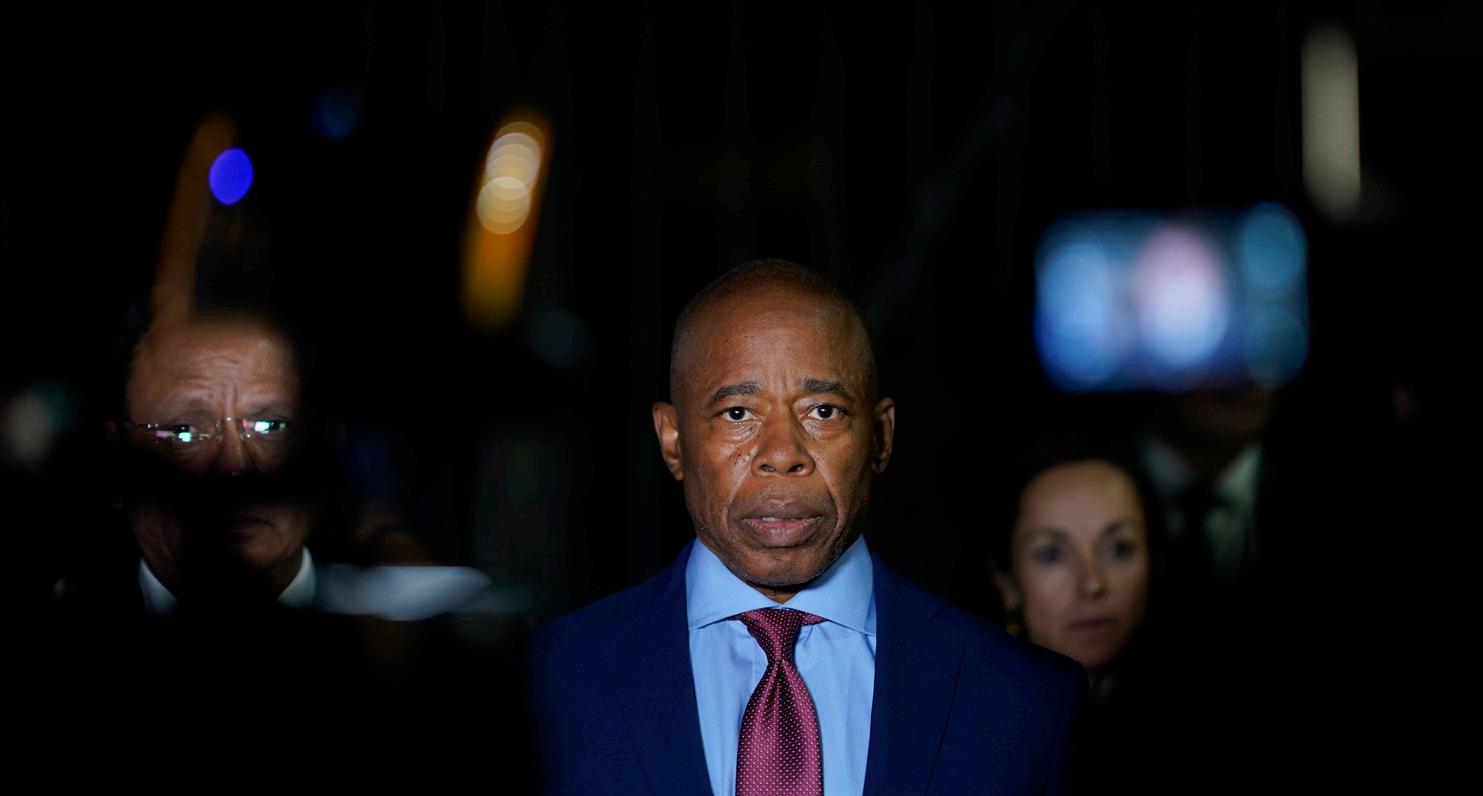
ignation. In response to the deputy mayors’ resignations, they ramped up their efforts




“This is a historic emergency: Trump has done a deal with corrupt Mayor Eric Adams. Adams will do anything to save
ing persecuting immigrant New Yorkers,” the coalition said in a statement. “It is like Nixon, but worse, because our institutions are failing. can protect ourselves and our fellow New Yorkers. That is why organizations on Sunday joined together and
ers marched. Now, we must keep the pressure on Governor Hochul to remove Adams and
Murad Awawdeh, New York Immigration Coalition’s (NYIC) president and CEO, said, “At a time when New Yorkers cannot rely on their mayor to follow the law, others in the Adams administration must step up. Mayor Adams
tation agenda as a ‘get out of jail free card,’ but the actions

“With the resignation of deputy mayors, it has become clear that Mayor Adams has now lost the confidence and trust of his own staff, his colleagues in government, and New Yorkers. He now must prioritize New York City and New Yorkers, step aside, and resign,” said City Council Speaker Adrienne Adams. “This administration no longer has the ability to effectively govern with Eric Adams as mayor. These resignations are the culmination of the mayor’s actions and decisions that have led to months of instability and now compromise the city’s sovereignty, threaten chaos, and risk harm to our families … We have endured enough scandal, selfishness, and embarrassment, all of which distract from the leadership that New Yorkers deserve.”
“No one is above the law,” said U.S. Rep. Laura Gillen. “If you abuse the power of public office, you’re not fit to hold it.
uties. Hochul said she spoke with them to express gratitude for their years of service and that their leaving “raises serious questions” about the long-term future of Adams’s administration. She decided to convene with leaders, including with Reverend Al Sharpton — Adams’s most prominent mentor — on Tuesday, Feb. 18, at her Manhattan office to discuss removing him.
“I recognize the immense responsibility I hold as governor and the constitutional powers granted to this office,” Hochul said in a statement. “In the 235 years of New York State history, these powers have never been utilized to remove a duly-elected mayor; overturning the will of the voters is a serious step that should not be taken lightly. That said, the alleged conduct at City Hall that has been reported over the past two weeks is troubling and cannot be ignored.”
dinates to take to collude with ICE are both legally dubious
nations from mainstays in Adams’s administration may be the proverbial straw to break the camel’s back, and has drawn scores of scathing calls from other electeds for

Mayor Adams has failed and betrayed New York City repeatedly over the last three years, prioritizing his own interests over those of New Yorkers. His recent actions of blatant, textbook corruption have proved once again why he should not be mayor for even one day more.”
New York State Lieutenant Governor Antonio Delgado, breaking from Hochul’s more reserved reactions to Adams’s situation, loudly called for Adams to resign.
It was certainly hard for Hochul to ignore the abrupt departures of Adams’s dep-
Hochul added that, “Let me be clear: My most urgent concern is the well-being of my 8.3 million constituents who live in New York City. I will be monitoring this situation extraordinarily closely to ensure that New Yorkers are not being shortchanged by the current crisis in City government.” Adams is set to face federal Judge Dale E. Ho on Wednesday, Feb. 19, who will decide whether to grant the DOJ’s request to dismiss the corruption charges. The judge has asked lawyers to explain the abrupt change in position just weeks before an April trial.
By DERREL JOHNSON Special to the AmNews
Queens native Hassan Diarra started his college basketball career with the Texas A&M Aggies and then made a decision that has dramatically altered his life. Diarra transferred to the University of Connecticut to play for head coach Dan Hurley and became one of the Huskies top reserves on back-to-back national championship squads, winning Big East Sixth Man of the Year honors last season. The senior has continued to come off of the bench this season in a leading role for the Huskies but their aim to make it three straight will be much harder than the other runs to the title as they are far from being a dominant team.
UConn was 17-8 overall and 9-5 in the Big East when they hosted Villanova on Tuesday night. They were unranked, out of the top 25, for the first time since the 2022-23 preseason polls after a 68-62 loss to St. John’s on February 7. Diarra went into the game versus Villanova topping UConn in assists at six per game while also averaging 8.2 points.
For Brooklyn’s Kadary Richmond, his college basketball journey began long before he was playing regularly at Madison Square Garden. The South Shore High School alumnus played his freshman year for Syracuse University under legendary head coach Jim Boeheim. The Syracuse Orange, one of the Big East Conference’s founding programs, had many
and South Shore High School product Kadary Richmond has been key to St. John’s No. 10 national ranking. (AP Photo/Noah K. Murray)

memorable games at MSG before moving to the ACC in 2013. Richmond transferred to Seton Hall after his first season with Syracuse and played three years for the Pirates.
With the NCAA granting student-athletes who were enrolled or entering college during COVID-19 an additional year, after
four years of college basketball, Richmond transferred to St. John’s last summer to suit up for the Red Storm and another legendary head coach, Rick Pitino. He was the No. 1 player in the transfer portal and decided to finish up at home. It has been a near perfect match. Richmond has been one of the
best all around guards in the country and St. John’s one of its best teams.
He was averaging 12.6 points, shooting a career-high 49.3% from the field and led the Red Storm in assists (5.1) and steals (2) per game when they took on DePaul last night on the road. St. John’s is experiencing its best season in three decades, having entered the top 10 for the first time in 26 years. The 22-4 Johnnies were as high as No. 9 a little over a week ago and are currently No. 10, first in the Big East at 13-2 heading into last night’s game. On Sunday at the Garden, Richmond dropped 19 points in a 79-73 win over the Creighton Bluejays.
“It feels good, going around, being noticed because of the way we’re playing and what we’re doing as a team,” Richmond said when asked about playing in front of a soldout Madison Square Garden. “We’re staying humble and we are going to keep on trying to win every game and play.”
Pitino said Richmond has leveled up as the team has risen in the rankings. “Kadary just keeps getting better and better,” he said. “I love his confidence. He doesn’t think about shooting a three. He just has great confidence right now, and that’s why he is playing so well.”
“This is what I transferred for,” Richmond said, referring to his team being on top of the Big East Conference and revitalizing the program. “I like what’s going on in the city right now.”
By LOIS ELFMAN
Special to the AmNews
The St. John’s University women’s basketball team hasn’t produced the results they hoped for when the season began. Heading into last night’s (Wednesday) against Creighton on the road, the Johnnies were 14-11 overall and 4-10 in Big East play. With three regular season games remaining, including Sunday’s matchup at home versus Seton Hall, their only road to the NCAA’s March Madness postseason is winning the Big East Tournament, which will begin on March 7 at the Mohegan Sun Arena in Uncasville, Connecticut.
This past Sunday was an uplifting day for the St. John’s squad and Madison Square Garden was a sea of red. Following the nationally ranked No. 10 St. John’s men’s basketball team’s 79-73 win over Creighton, the women’s team defeated Butler 65-43. Despite the crowd thinning out for the women, the Johnnies ladies did not let that dim their spirits as they dominated from start to finish.
“As a kid coming here to watch games, now being on the floor coaching, and then to see our players be able to have mo-
ments like they did tonight in this environment is something I’ll never forget,” said Red Storm head coach Joe Tartamella. “I’ve been in games here where we filled [MSG] and games where it’s not as filled, but you still feel the energy of the place. … It’s been hard the last few weeks, so the way that they played tonight was special.”
Lashae Dwyer led all scorers with 21 points. Phoenix Gedeon had 13 points and nine rebounds. Ber’Nyah Mayo had 11 points. Tartamella noted that Dwyer controlled the floor in terms of picking her spots.
“I’m very grateful for this moment right here, grateful to be here,” said Dwyer, a senior guard in her first year at St. John’s. “I actually came to the game very nervous because of this arena, so I’m happy to get this W for my team.”
Dwyer felt the energy from her teammates during the game’s first quarter and her nerves subsided. Playing at the “world’s most famous arena,” also known as the “Mecca of basketball,” was a blessing for her. She will carry that positive energy into the remainder of the season.
It’s been an up-and-down season for this team. They opened their schedule with a promising 10-1 mark facing non-confer-

ence opponents. The only loss was a hardfought 54-52 battle against Harvard. But their winning trend came to a halt when Big East play began. The Red Storm lost their first four games and has won just
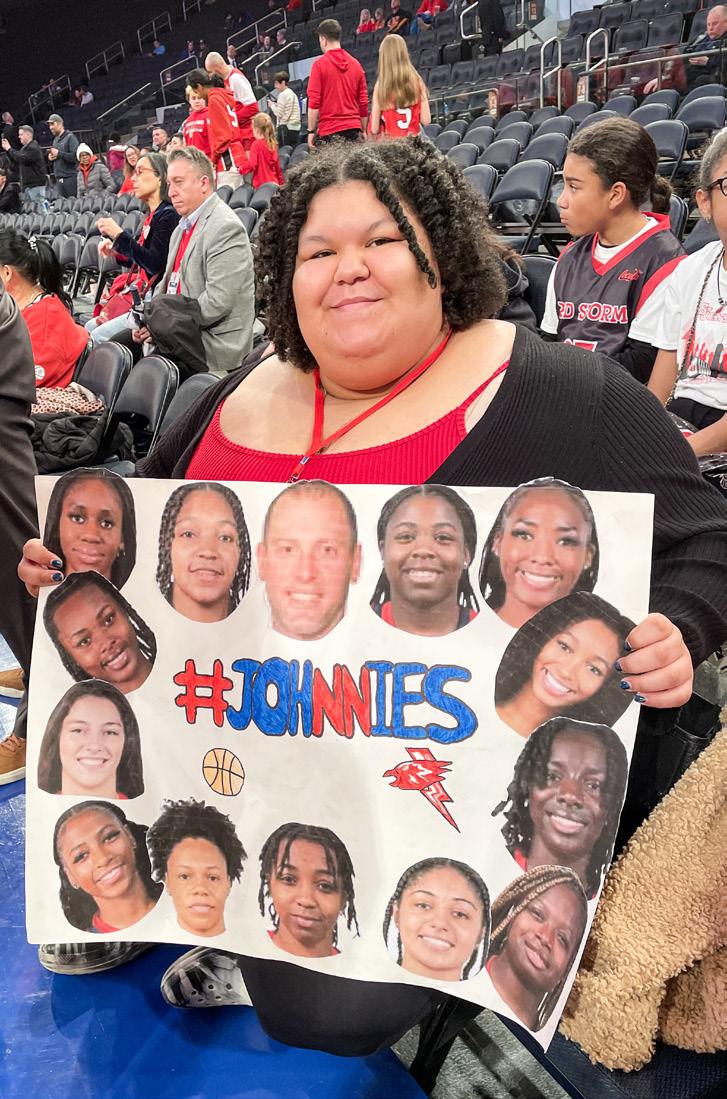
four since. Looking ahead, getting an invitation to one of college basketball’s postseason tournaments — they played in the WBIT last season — is attainable with a solid finish.
By JAIME C. HARRIS
AmNews Sports Editor
Knicks head coach Tom Thibodeau has regularly dismissed justified reasons when addressing his team’s shortcomings, encouraging them to push forward and not make excuses despite very real obstacles. His resonant mantra has been “we have enough to win” when injuries have indisputably hampered them, including in last year’s playoffs.
The Knicks ended their Eastern Conference semifinals series versus the Indiana Pacers last May at Madison Square Garden, a 4-3 series defeat, with center Mitchell Robinson sidelined after re-injuring his surgically repaired left ankle in Game 1. Forward OG Anunoby sat out Games 3 through 7 after sustaining a left hamstring strain in Game 2. And guard Jalen Brunson fractured his left hand in the 130-109 Game 7 loss.
The Knicks had already lost guard-

forward Bojan Bogdanovic, who was a solid contributor off of the bench, to a season ending foot injury in Game 4 of their opening round series against the Philadelphia 76ers. Bogdanovic was traded to the Nets last June in the Mikal Bridges deal.
Now as they come back tonight from the All Star break hosting the Chicago Bulls at MSG, the question of if they have enough to compete for the Eastern Conference championship with the conference leading Cleveland Cavaliers, who are 44-10 and facing the Nets in Brooklyn tonight, and the 39-16 No. 2 seed Boston Celtics in Philadelphia tonight to play the 76ers, is still open. The Knicks are third in East at 36-18 and won their last two games before the break.
A tape measure will come soon as they meet the Cavaliers and Celtics on the road tomorrow and Sunday, respectively.
“This is a good chance. You know, I want our players to get away, re-
energized and refocus and then come back to head down the stretch,” said Thibodeau after the Knicks’ 149-148 overtime victory at home over the Atlanta Hawks eight days ago, their last game prior to the All-Star hiatus. “There’s been a lot of fight and determination.”
Getting healthy and whole is the Knicks’ first order of business if they expect to contend with the Cavs and Celtics. Anunoby, who is slated to play tonight, has been shelved since spraining his right foot versus the Los Angeles Lakers on Feb. 1. Robinson has been working his way to a return following his second surgery — the first was in December 2023 — on his left ankle last May. Early next month has been the reported goal for Robinson to be back in the rotation.
Even with a full complement of players, questions will persist as to whether the Knicks have the quality of depth to match the long benches of the Celtics and the Cavs.
By LOIS ELFMAN
to the AmNews
Before current basketball stars took to the court for the new-look NBA All-Star Game(s), the San Francisco Bay Area experienced five days of incredible activities. There was a distinct WNBA presence, not only in the past and present players in attendance, but in the WNBA Housewarming activation for the Golden State Valkyries, the new WNBA franchise that begins play this spring.
Of particular note were the numerous activities reflective of youth basketball, community impact, and celebration of the diversity of the sport. The event kicked off with the NBA Cares All-Star Day of Service, which included NBA and WNBA players. Among other events were a Jr. WNBA Clinic, NBA Foundation All-Star pitch competition (startup companies pitching their businesses to a panel of judges, including former Los Angeles Sparks player Chiney Ogwumike),
and the high-energy NBA HBCU Classic presented by AT&T between the Morehouse College and Tuskegee University men’s basketball teams.
“We’re a basketball league and we felt like we have a unique role to play when thinking about the health of our fans, and specifically thinking about the interconnectivity of our physical health, our mental health, and community health,” said Barbara Bush, NBA vice president of social impact, shortly after participating in Sunday’s inaugural NBA Total Health All-Star Walk.
NBA’s Total Health platform partners with various organizations that have tools for making a plan toward health and wellbeing. WNBA and Olympic champion Lisa Leslie participated in the AllStar Walk alongside about 1,000 walkers for a 3-mile walk through Golden Gate Park.
“Today’s focus was joy and movement,” said Bush. “We’re trying to bring the community together to walk alongside each
ning with third graders up to high school seniors in addition to developing its travel teams.
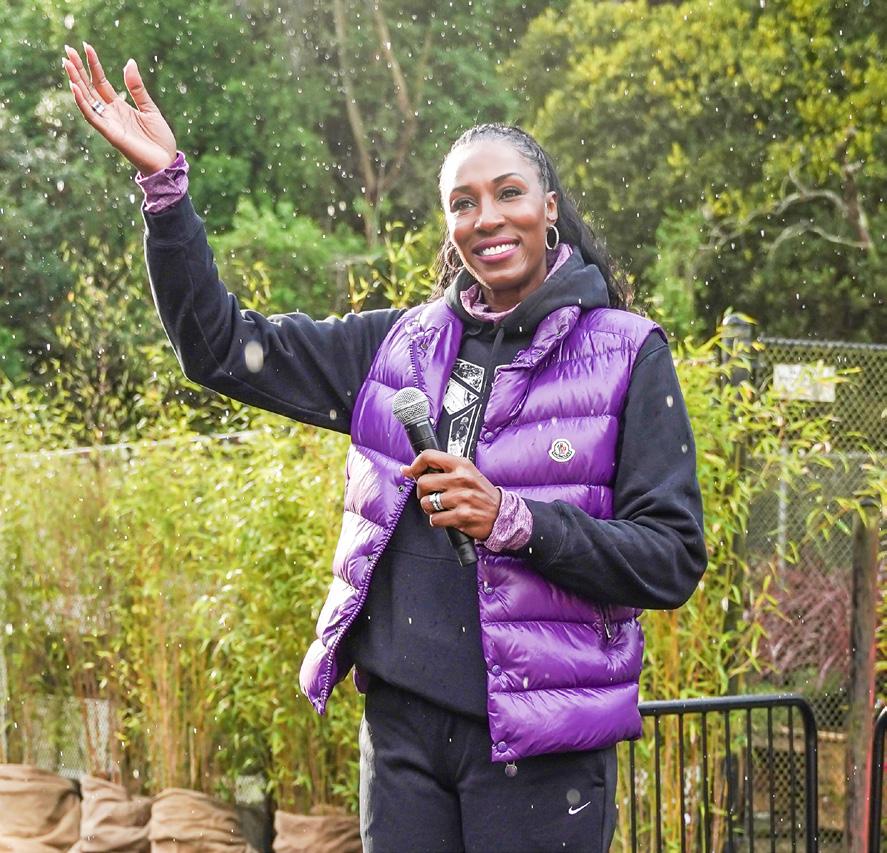
other as we take steps to bettering our health. [Lisa Leslie] spoke about what brings her joy, and one of the things that brings her joy is moving. We had women and men of all ages, all shapes and all sizes joining us, and most of us will not be like Lisa Leslie — we won’t play
Terence Simpson, who heads the Staten Island site.

at such an elite level, but to walk alongside someone like her is inspiring.”
Putting together more than a dozen events with social impact, including a Jr. NBA/Jr. WNBA STEM (science, technology, engineering, and mathematics) clinic
about the intersection of sports and STEM — takes a community.
“We had a unique opportunity to shine our spotlight on organizations that are showing up for communities in San Francisco and Oakland every single day,” said Bush.
clusively for girls ages 8-18 serving all five boroughs with its base in Manhattan. NYC Juniors holds camps and clinics for girls begin-
Along with Levine, the organization’s executive director, the administrative staff includes Director of Operations Kendra Wilson and Associate Director
“We all have been involved with volleyball for a long time and are very passionate about the sport,” said Levine to this writer. “What is truly meaningful for us is that we provide opportunities for girls re-
gardless of their economic status. Volleyball, like other youth sports and travel clubs, can be very expensive.
“We offer financial assistance,” Levine added, “and have provided over $200,000 to our girls in each of the past five years through per-
sonal, corporate, and other donations as a 501 (c)(3) nonprofit organization. We ensure that all of the money goes to helping the girls and none to administrative costs.”
For more information on NYC Juniors, visit their website at nycjuniorvolleyball.org.
By LOIS ELFMAN
Special to the AmNews
The Professional Women’s Hockey League (PWHL), now in its second season, consistently makes commitments to its fans — both current and those they hope to build. Although there are only three Black players currently in the league, the PWHL ensured that its six teams — three based in the U.S. and three in Canada — celebrated Black History Month.
Saroya Tinker, manager of diversity, equity, and inclusion for the PWHL, has taken the lead on the Black History Month celebrations. A former professional player, Tinker is also a commentator and co-founder and executive director of the Black Girl Hockey Club Canada, a nonprofit in the U.S. and Canada focused on bringing more Black women and girls into ice hockey.
“Unity games are dedicated games focused within the PWHL season that bring together fans, players, and communities to celebrate, learn about, and support diverse identities within the sport,” said Tinker. “I reached out to the artist Kezna Dalz, who … created a logo for us that is representative of Black History Month, of hockey, of our fan base.”
The New York Sirens held their unity game on Feb. 2, when they took on the Montréal Victoire at Prudential Center. That evening,

the team honored Kim Davis, executive vice president of social impact, growth initiatives, and legislative affairs for the National Hockey League, with a ceremonial puck drop. At Toronto’s unity game on Feb. 11, Canadian ice hockey great Angela James did the puck drop.
“The New York team was able to have a pre-game panel where they were talking about racial injustices and how allies can stand up for BIPOC individuals,” Tinker said. Several Black-owned businesses from New Jersey were highlighted throughout the game. “All the teams are engaging and making sure that the Black community feels included in the arena and that we’re introducing new faces to hockey.”
All six teams in the PWHL are holding unity games this month, with teams in Minnesota, Montréal, and Ottawa having their games this coming week.
“It’s all about representation and showing these girls that they can play,” said Tinker. There is a vibrant collegiate scene with a National Championship. “I do see more BIPOC and Black faces in the arena,” said Tinker, who played collegiate ice hockey at Yale University. “We see an influx of little Black girls playing the sport and some at a high level. We are on the right track … I hope the PW is so diverse one day.”
By DERREL JOHNSON Special to the AmNews
Keyshawn Davis’ rise is rapid. Last Friday at the Theater at Madison Square Garden, the 25-year-old from Norfolk, Virginia, won a lightweight title in the third fewest fights in history, knocking out the previously undefeated 36-year-old Ukrainian Denys Berinchyk in the fourth round to tie Oscar De la Hoya for his place on the lofty list.
Only Vasiliy Lomachenko and Jimmy Britt, who fought in the early 1900s, had fewer fights before being crowned. (Britt did not officially win the title but is still credited by some boxing historians.)
Davis (13-0-1, 9 KOs) achieved his status in just 14 bouts, knocking out Berinchyk at 1:45 of the fourth round to win the championship. The power of Davis (13-0, 9 KOs) proved to be too much for Berinchyk (19-1, 9 KOs), as he dropped him in the third round before finishing him off a round later.
“It was an amazing feeling,” said Davis. “Right before I knocked him out, I was hearing the crowd saying, ‘Norfolk! Norfolk! Norfolk!’ I was like, ‘I’ve got to knock him out now! Boom!”
In the still divided sport of professional boxing in which matchups between the best fighters in or around the same weight class are increasingly rare, as promotion companies and managers are often at odds, Davis was clear about who he wants to fight next.
“I want anybody who has the balls to step in

the ring and fight me,” he exclaimed. “There are two 135-pound champions that I would love to fight. If they have the guts to step in the ring with ‘The Businessman,’ tell them to send me a contract, or I can send them one.”
Davis was referring to Lomachenko, the IBF lightweight champion and WBA lightweight champion Gervonta “Tank’ Davis (no relation). WBC lightweight champion Shakur Stevenson is close friends with Keyshawn
Davis so the two would unlikely battle each other. Gervonta Davis, nicknamed Tank, was unsuccessful in his quest to make a fight with Lomachenko, who turned 37 earlier this week. At this point in his career, the Ukrainian champion, who has lost to Teofimo Lopez and Devin Haney, who last June was classified as the WBC “Champion in Recess” as he has taken time away from the ring, may not want to fight the young lions of boxing anymore.Newark, New Jersey, native Stevenson and Tank Davis are the fights to make. Stevenson was scheduled to battle Floyd Schofield in Riyadh, Saudi Arabia this Saturday, but Schofield pulled out due to illness. At AmNews press time, Stevenson was seeking a replacement opponent.
As for Keyshawn Davis, the 2020 Tokyo Olympics lightweight silver medalist, despite his eagerness to step up in competition, he doesn’t appear to be ready for any of the other champions in the division yet, but he could be the future of it barring him moving up to another division.
Saturday’s stacked card in Saudi Arabia includes Artur Beterbiev (21-0, 20 KOs) defending his undisputed light heavyweight world championship against Dmitry Bivol (23-1, 12 KOs). Beterbiev edged out a 115-113, 116112, and 114-114 win in their previous contest last October. In the co-main event, IBF heavyweight champion Daniel Dubois, (22-2 21 KOs) will try to retain his title against Joseph Parker, who is 35-3 with 23 KOs.
By JAIME C. HARRIS AmNews Sports Editor
When Carter G. Woodson, a towering American figure who became the second African American to ever receive a doctorate from Harvard University after W.E.B. Du Bois, established Negro History Week in February 1926, which was the forerunner Black History Month, Black athletes had already authored seminal historical achievements in sports.
Woodson, a historian, journalist, and author aptly referred to as the “father of Black history” for his extensive study and chronicling of the African diaspora, even with the breadth and depth of his knowledge and vision, couldn’t have fathomed how momentous sports would become to the pursuit of Black liberation. Consequential triumphs in the boxing ring, playing fields, and courts by those of African descent would markedly shape American society and culture.
Woodson, the son of enslaved Africans, was born December 19, 1875 in New Canton, Virginia, in Bucking-

ham County, the same county where this writer’s father, David Harris, was raised in his early years. On March 31, 1878, in Galveston, Texas, John Arthur “Jack” experienced his born day. Only 13 years prior, on June 19, 1865, enslaved African Americans in Galveston were finally informed by
Union General George Granger they had gained their freedom, two and half years after President Abraham Lincoln signed the Emancipation Proclamation on January 1, 1863, declaring freedom for enslaved people in all Confederate states. That day in Galveston is now celebrated as the
national Juneteenth holiday.
As Woodson would go on to become one of the world’s eminent scholars, Johnson’s parallel timeline saw him surface as arguably the most famous man on the planet as the first Black heavyweight boxing champion. On December 26, 1908, Johnson completed a 14-round, commanding one-sided victory over Canadian Tommy Burns in Sydney, Australia — a fight eventually stopped by local police due to the pounding Johnson was putting on his overmatched opponent.
Johnson was the first notable American Black athlete who openly flaunted his riches and standing as he amassed sizable financial resources inside the ring, endorsing products and engaging in entrepreneurial ventures, including owning an integrated restaurant in Chicago named Cafe de Champion.
“The possession of muscular strength and the courage to use it in contests with other men for physical supremacy does not necessarily imply a lack of appreciation for the finer and better things
of life,” Johnson once said.
Even before Woodson’s birth, Blacks in sports were by extension also cultural vanguards. Seven months prior, in 1875, Oliver Lewis, a Black jockey, won the first Kentucky Derby. Of the 15 jockeys in that race to cross the finish line, 13 were Black. In fact, Black men were the preeminent jockeys in horse racing before Jim Crow laws ended their reign in the early 20th century. Boxing and horse racing were the two most popular sports in the United States as well as abroad, making Johnson and jockeys like Lewis lofty figures in the late 1800 and early 1900s.
As African Americans endured slavery and post-Reconstruction betrayals, when baseball began to rise, and in the immediate ensuing years Black players such as Bud Fowler, William Edward White, and Moses Fleetwood Walker etched themselves as pioneers of the sport, unbeknownst to them, like Jack Johnson and Oliver Lewis, they would become the original threads in the fabric of sports history that would become part of the massive quilt of Black history.
By JAIME C. HARRIS
AmNews Sports Editor
Volleyball is the world’s fastest growing sport. For girls, the meteoric rise in participation is noteworthy.
USA Volleyball, the National Governing Body for the sport in the United States, reported a membership increase of 9.6% in 2022-23, the largest percentage growth since 1998. In 2023-24, 3,880 junior clubs were registered with the organization, up over 50% from the 1,750 in 200405. As of last July, 333,208 junior (ages 11-18) girls were active members of clubs.
Among them are the youth of NYC Juniors, the largest volleyball club in New York. Founded in Manhattan in 1993 by Doug Levine, a former collegiate player and coach, it has become a prominent fixture on the city’s and national sports landscape. This past weekend, the program’s NYC Ju-

niors 14 Blue, one of their three 14u (which stands for 14 years old and under) teams, captured third place at the highly competitive Capitol Hill Volleyball Classic held at the Walter E. Washington Convention Center in Washington, D.C., emerging from the 96team field.
“It is one of the most amazing ac-
complishments of my life,” said a proud Sara Atai, the team’s head coach, via phone to the AmNews on Tuesday. “Those young ladies worked extremely hard and are very committed. I am so happy for them and the entire program.”
Atai, who played volleyball for Pace University in Pleasantville, New York, is the assistant women’s
coach at Manhattan College under head coach Mauro Miletic. In an ironic role reversal, Miletic is Atai’s assistant with the 12-member 14 Blue squad.
Levine, a native of Manhattan’s Chelsea neighborhood and former volleyball stand-
out for the University of Maryland, began his coaching journey at his alma mater, Hunter College High School, where he led the boys varsity team to the 1988 PSAL championship. He then pursued graduate studies in exercise science at the University of New Mexico, obtaining a master’s degree while working with the women’s volleyball team.
Levine, now in his 26th year as an educator at the Brearley School, an all-girls K-12 private institution on the Upper East Side, where he is the volleyball coach, started NYC Juniors with one boys and one girls 12-under teams. It ultimately evolved into a club ex-
